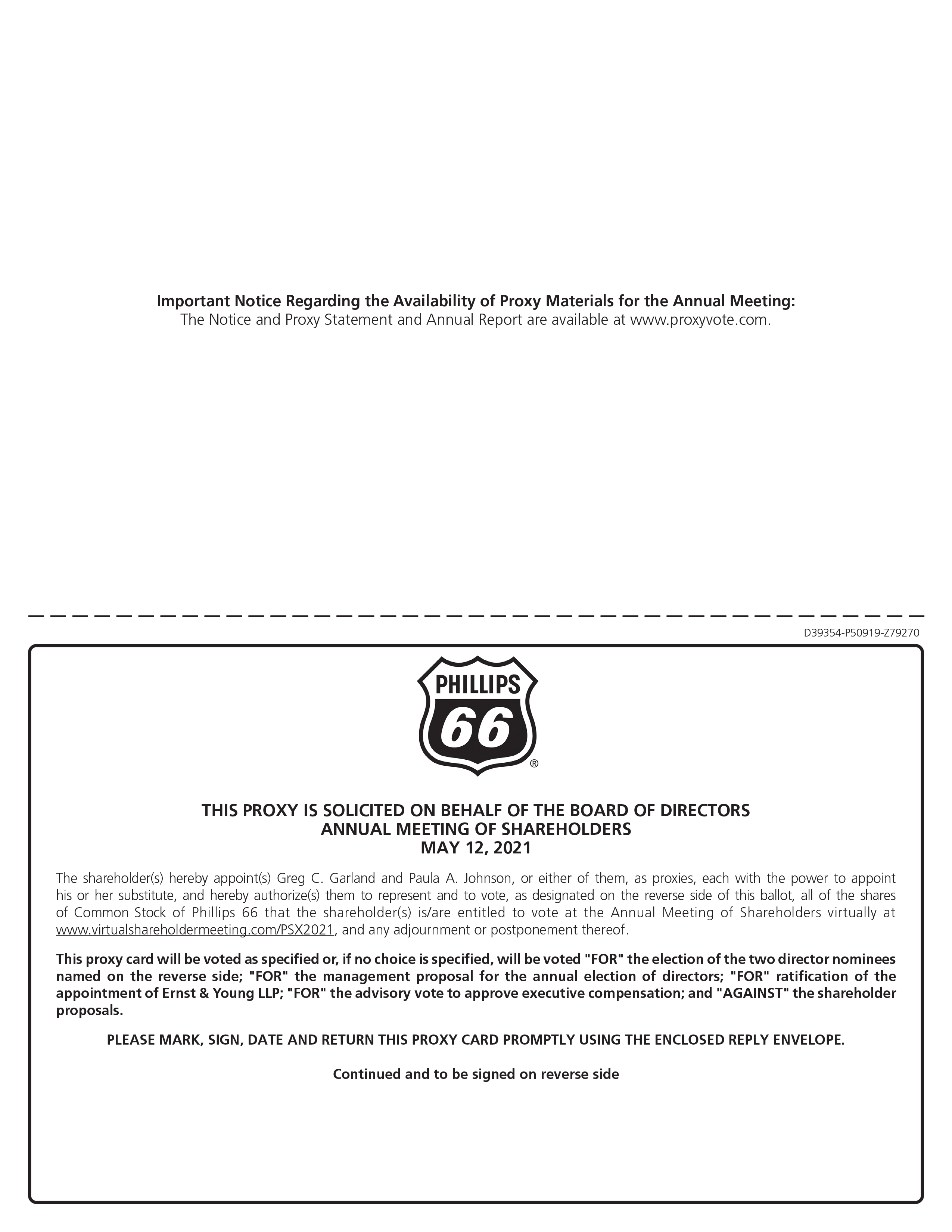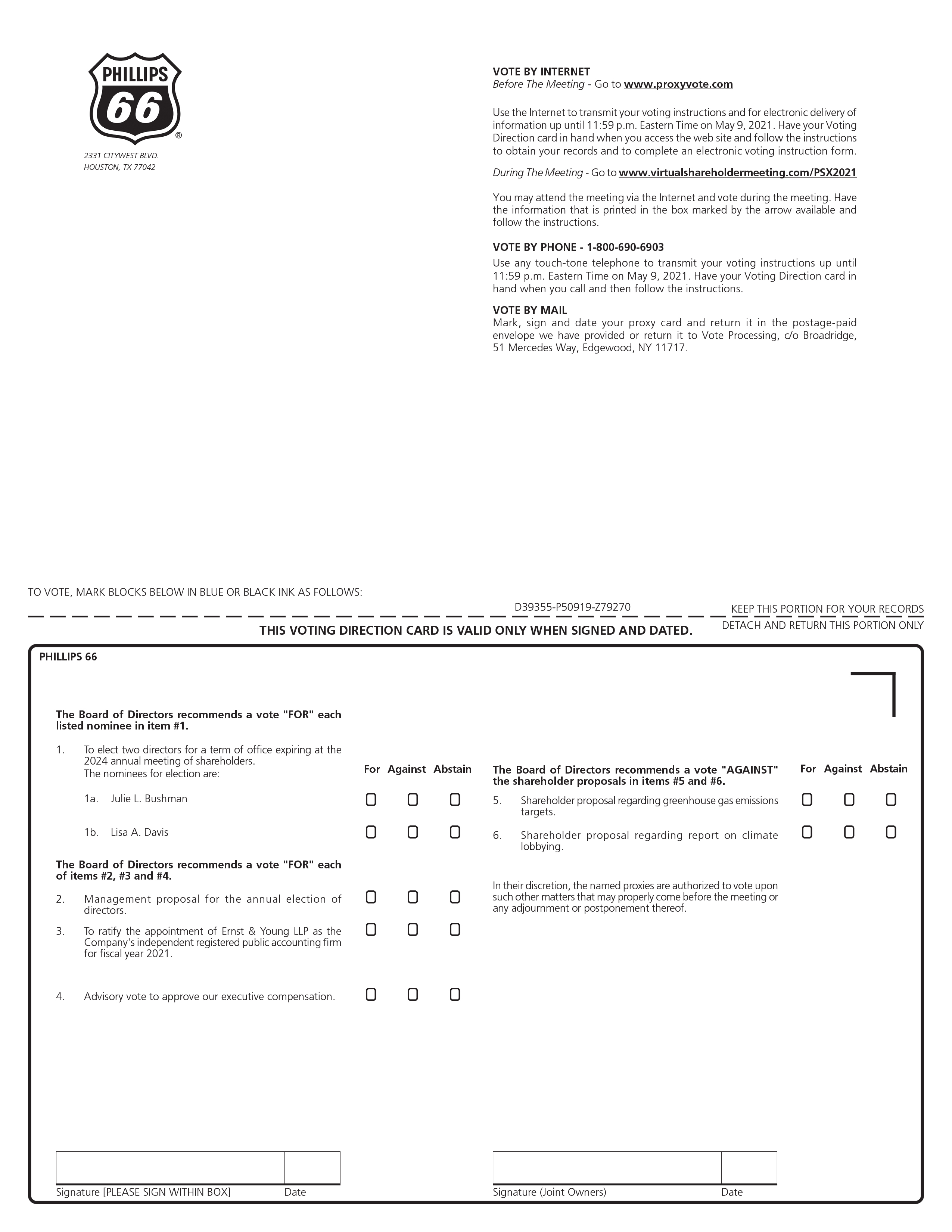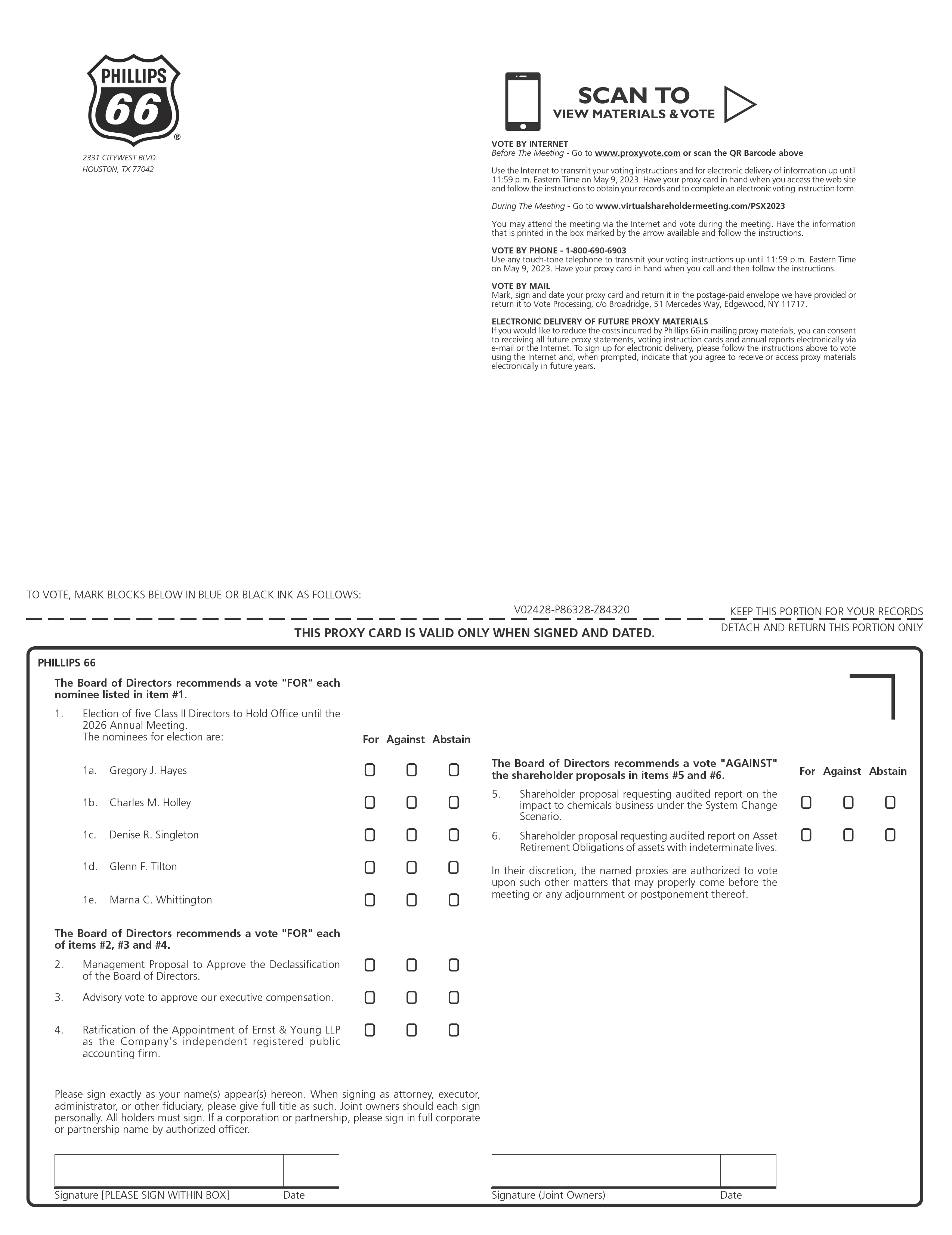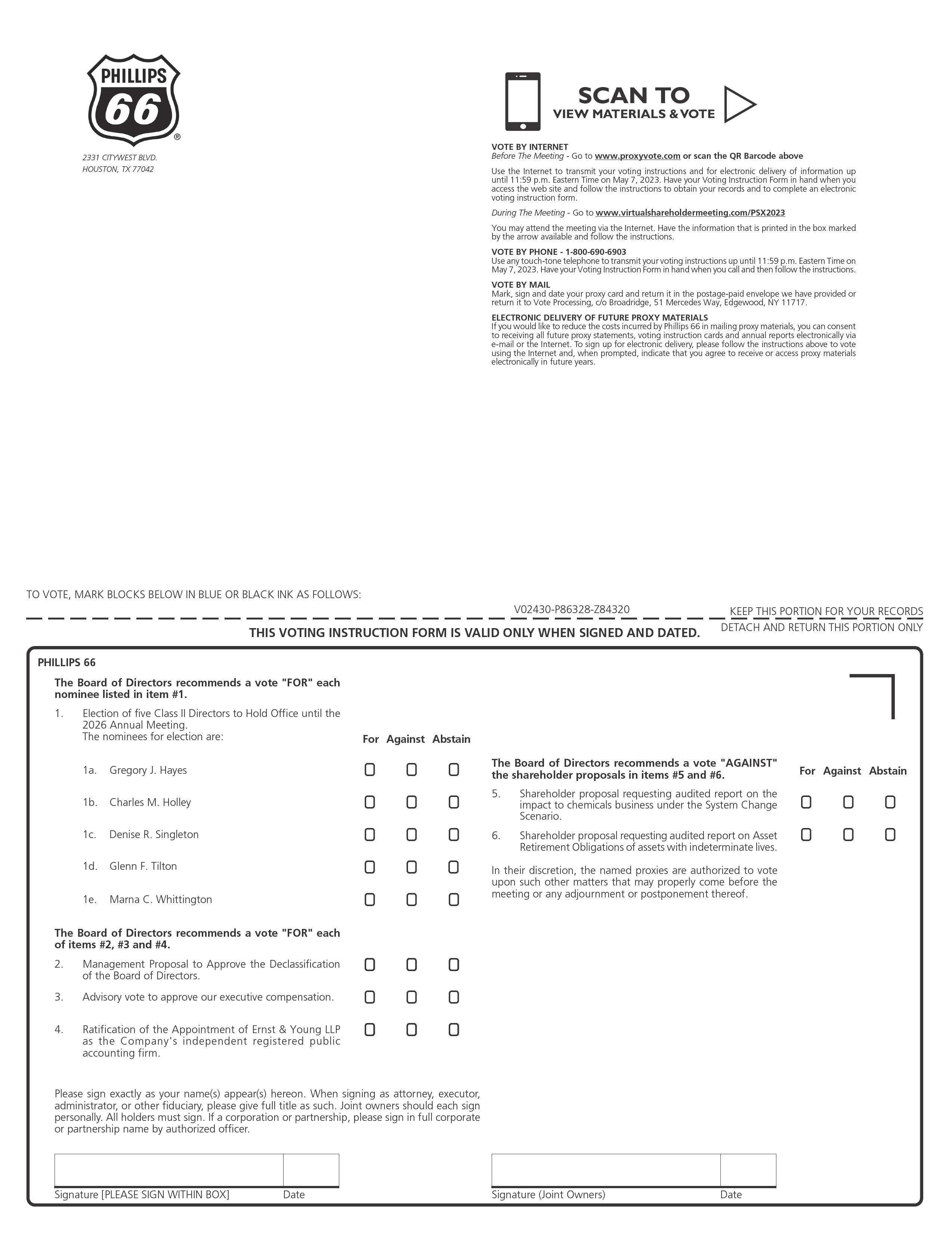
SECURITIES AND EXCHANGE COMMISSION
Washington, D.C. 20549
the
Securities Exchange Act of 1934 (Amendment No. )
| ☑ | Filed by the Registrant | ||||||||||
| ☐ | Filed by a | ||||||||||
| ☑ | Preliminary Proxy Statement | |||||||
| ☐ | Confidential, for Use of the Commission Only (as permitted by Rule 14a-6(e)(2)) | |||||||
| ☐ | Definitive Proxy Statement | |||||||
| ☐ | Definitive Additional Materials | |||||||
| ☐ | Soliciting Material under §240.14a-12 | |||||||

| ||||||
| ||||||
| ☑ | No fee | |||||
| ☐ | Fee paid previously with preliminary materials | |||||
| ☐ | Fee computed on table | |||||
| ||||||
| ||||||
| ||||||
| ||||||
| ||||||
| ||||||
| ||||||
| ||||||
|  | |
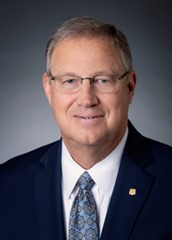 |
| |
► As a company in a critical infrastructure sector, we continued providing energy to our communities where we live and work. We implemented procedures and put measures in place to keep our employees safeimproving lives and our facilities on-line. We reconfigured work areas, provided protective equipment and put policies in place to support employees with underlying conditions or children at home, among others. We did this while achieving our best ever rate for personal safety at the Company.
► We took swift action to secure liquidity and maintain our dividend. We suspended our share repurchases, identified projects that could be deferred while still meeting our commitment to personal and process safety, and implemented measures to reduce our controllable costs.
► We focused on the future, announcing further investments in a lower-carbon economy and continuing to expand our participation in the energy transition. Our Rodeo Renewed project will convert our San Francisco Refinery into onecore values of the world’s largest renewable fuels facilities and is expected to reduce the facility’s greenhouse gas emissions by 50%. We formed a new organization within the Company, Emerging Energy, that is dedicated to working on a lower-carbon business platform and opportunities within our portfolio to commercialize emerging energy technologies.
► We completed major growth projects and progressed milestones on others. We completed the Gray Oak Pipeline and the Sweeny Hub Phase 2 expansion. We also added a fourth dock at our Beaumont Terminal, and two docks began crude oil export operations at the South Texas Gateway Terminal during 2020.
► We added two new directors to our Board. We continued our Board refreshment, adding two new directors in 2020 who bring diverse experience to our Board. The addition of these directors adds to our Board’s industry expertise, further increases our Board’s gender diversity, and broadens the depth and breadth of the skills and experiences our directors bring to the Board.
Finally, I would like to note that we are optimistic about the impact of the COVID-19 vaccines on economic recovery and longer term, the opportunities for value creation across our portfolio. To ensure everyone’s health and well-being, the 2021 Annual Meeting will be held exclusively online. You can find information about how to attend in the attached Proxy Statement.
Thank you for your continued support and investment in Phillips 66.
In safety, honor, and commitment,
Greg C. GarlandChairmancommitment.
We Work Together, We Get It Done
| |||||||||||||||||||||||||||||||||||
| |||||||||||||||||||||||||||||||||||
Work for the greater good. | Create an environment of | Seek different perspectives. | Achieve excellence. | ||||||||||||||||||||||||||||||||
| We embrace our values as a common bond. | We depend on each other to do our jobs. | We create space for possibilities. | We challenge ourselves and never settle. | ||||||||||||||||||||||||||||||||
Be a good neighbor and use resources wisely. Prioritize the Work across teams, business units and functions. Hold ourselves accountable for our words, work and actions. |
| Build relationships by understanding the Provide and welcome real-time feedback. Treat everyone as a Resolve differences quickly and move forward. | Examine the
Be open to Speak up and Listen and | Acknowledge and rebound from our mistakes. Embrace change and adapt quickly. Be curious and pursue lifelong learning. Leave things better for the next person. | |||||||||||||||||||||||||||||||
| Don't let self-interest come first. | Don't say one thing and do another. | Don't simply accept the "way we have always done things." | Don't avoid difficult decisions. | ||||||||||||||||||||||||||||||||
| Living our values earns us the confidence of our business partners, communities and co-workers. | Trusting each other makes us more productive and agile. | Championing inclusion enables us to
| Continuing to
| ||||||||||||||||||||||||||||||||
| ||||||
| Notice of Meeting of Shareholders |
| |||||
| ||||||||||||||||||||
| VOTING ITEMS | ||||||||||||||||||||
Date and time Wednesday, May |
9:00 a.m. Central |
Place virtualshareholdermeeting.com/ | ||||||||||||||||||
The 2021 Annual Meeting will be held exclusively online at www.virtualshareholdermeeting.com/PSX2021. To join as a shareholder, you must enter the 16-digit control number on your proxy card, voting instruction form, or Notice of Internet Availability you previously received. During the meeting shareholders may ask questions, examine our shareholder list and vote their shares (other than shares held through employee benefit plans, which must be voted prior to the meeting). Other interested parties may join the meeting as a guest, in which case no control number is required. For more information, please see the section entitled ADDITIONAL INFORMATION in this Proxy Statement. We are making the Proxy Statement and the form of proxy first available beginning on March , 2021.
| Shareholders of record at the close of business on March | |||||||||||||||||||
 | How to cast your vote: Online before the meeting www.proxyvote.com | |||||||||||||||||||
 | By phone (800) 690-6903 | |||||||||||||||||||
 | Proxy card or voting instruction form Complete, sign and return your proxy | |||||||||||||||||||
 |
| |||||||||||||||||||
| card. If you are a beneficial owner and received a voting instruction form, please follow the instructions provided by your bank or broker to vote your shares. Online at the meeting You may also vote online during the annual meeting by following the instructions provided on the meeting website during the annual meeting. To vote at the meeting, visit virtualshareholdermeeting.com/PSX2023 | ||||||||||||||||||||
| Proposals | Board Vote Recommendation | For Further Details | ||||||||||||||||||
| 1 | Election of five Class II Directors to hold office until the 2026 Annual Meeting | “FOR” each director nominee | Page 13 | |||||||||||||||||
| 2 | Management proposal to approve the declassification of our Board of Directors | “FOR” | Page 37 | |||||||||||||||||
| 3 | Approval, on an advisory basis, of compensation paid to our named executive officers | “FOR” | Page 38 | |||||||||||||||||
| 4 | Ratification of the appointment of our independent registered public accounting firm | “FOR” | Page 85 | |||||||||||||||||
| 5-6 | Two shareholder proposals, if properly presented | “AGAINST” each proposal | Page 88 | |||||||||||||||||
Shareholders will also vote on any other business that is properly brought before the meeting. The 2023 Annual Meeting will be held exclusively online at www.virtualshareholdermeeting.com/PSX2023. To join as a shareholder, you must enter the 16-digit control number printed on your proxy card, voting instruction form, Notice of Internet Availability, or legal proxy provided to you by the broker that holds your shares. During the meeting shareholders may ask questions and vote their shares (other than shares held through employee benefit plans, which must be voted prior to the meeting). Other interested parties may join the meeting as a guest, in which case no control number is required. For more information, please see the section entitled ADDITIONAL INFORMATION in this Proxy Statement. We are making the Proxy Statement and the form of proxy first available beginning on March , 2023. For the Board of Directors, | ||||||||||||||||||||
 |
| |||||||||||||||||||
Paula A. Johnson
Corporate Secretary
March , 2021
The Company will provide the Notice of Internet Availability, electronic delivery of the proxy materials or mailing of this Proxy Statement, the Annual Report on Form 10-K for the year ended December 31, 2020, and a proxy card to shareholders beginning on March , 2021.
 | ||||||||
| |||
 | ||||||||
 | ||||||||
Appendix A: Certificate of Amendment to the Amended and Restated Certificate of Incorporation | ||||||||
| Letters from Leadership | |||||
 |  Greg C. Garland Executive Chairman March , 2023 |  |  Mark E. Lashier President and Chief Executive Officer March , 2023 | ||||||||
| 3 | |||||
 | Sincerely, | ||||
 Glenn Tilton Lead Independent Director March , 2023 | |||||
4 | Phillips 66 2023 Proxy Statement | ||||
| Proxy Summary | |||||
YOUR COMPANY
 | AGENDA ITEMS AND VOTING RECOMMENDATIONS | ||||
 | PROPOSAL 1 | Election of 5 Class II Directors to Hold Office until the 2026 Annual Meeting The Board recommends that you vote “FOR” the five Class II director nominees named in this Proxy Statement.  See page 13 See page 13 | ||||||
 | PROPOSAL 2 | Management Proposal to Approve the Declassification of the Board of Directors The Board recommends that you vote “FOR” the declassification of the Board of Directors.  See page 37 See page 37 | ||||||
 | PROPOSAL 3 | Advisory Approval of Executive Compensation The Board recommends that you vote “FOR” the advisory approval of the compensation of the Company’s named executive officers.  See page 38 See page 38 | ||||||
 | PROPOSAL 4 | Ratification of the Appointment of Ernst & Young The Board recommends that you vote “FOR” the proposal to ratify the appointment of Ernst & Young LLP.  See page 85 See page 85 | ||||||
 | PROPOSAL 5-6 | Two Shareholder Proposals, if properly presented The Board recommends that you vote “AGAINST” each of the shareholder proposals.  See page 88 See page 88 | ||||||
YOUR VOTE IS IMPORTANT — This year, Phillips 66 will make a $1 charitable donation for every shareholder account that votes. Contributions will be made to Project Lead The Way, a non-profit organization that empowers students to thrive in an evolving world by providing teachers with the training, resources and support they need in classrooms across the United States. | ||
 | BUSINESS OVERVIEW AND PERFORMANCE HIGHLIGHTS | ||||
VOTING MATTERS
research for, solutions supporting a lower-carbon future.
| 5 | |||||
 | |||||
Achieve Operating Excellence Prioritizing safety, environmental stewardship, sustainability, reliability and cost efficiency while protecting shareholder value •Tied best-ever Tier 1 and 2 process safety event rate •Expanded Greenhouse Gas emissions reduction targets to include a 2050 emissions intensity reduction target for Scope 1 and Scope 2 emissions •Recognized by American Fuel and Petrochemical Manufacturers for exemplary safety performance •Awarded American Petroleum Institute’s large operator Distinguished Pipeline Safety Award for the second consecutive year | |||||
 | |||||
Drive Disciplined Growth Enhancing our portfolio by growing our integrated Midstream and Chemicals businesses, as well as executing our returns-focused lower-carbon strategy •Completed the acquisition of Phillips 66 Partners, LP •Increased ownership and further integrated DCP Midstream to enhance our wellhead-to-market strategy •Reached a final investment decision to convert our San Francisco Refinery into one of the world’s largest renewable fuels production facilities •Reached a final investment decision at CPChem, our 50-50 joint venture, in early 2023 for the construction of two |
| ||||
 | |||||
Deliver Shareholder Returns Rewarding shareholders through continued dividend growth and share repurchases •Increased the dividend by 5% in May 2022 and returned $1.8 billion in dividends in 2022 •Resumed share repurchases in the second quarter and repurchased $1.5 billion of shares in 2022 •Announced a $5 billion increase to the share repurchase authorization in November 2022 •Announced a target to return $10 billion to $12 billion to shareholders through dividends and share repurchases between July 2022 and year-end 2024 | |||||
 | |||||
Maintain Financial Strength & Flexibility Maintaining financial strength and disciplined capital allocation strategy to enhance resiliency •Generated $10.8 billion of operating cash flow •Ended the year with a cash balance of $6.1 billion •Paid down $2.4 billion of debt and ended the year with a net-debt-to-capital ratio of 24% •Implemented Business Transformation initiatives to sustainably lower our cost structure, and captured a run-rate savings in excess of $500 million by year-end | |||||
 | |||||
Cultivate a High-Performing Organization Building capability, pursuing excellence, and doing the right thing •Responded to employee feedback by enhancing workplace benefits •Contributed $27 million to support the communities where we operate and donated over $7 million through matching gifts and volunteer grant programs •Logged 88,000 employee volunteer hours •Received six external top employer recognition awards as a great place to work | |||||
| 6 | Phillips 66 2023 Proxy Statement | ||||
 | SPOTLIGHT ON EMERGING ENERGY | ||||
 | SPOTLIGHT ON OUR BUSINESS TRANSFORMATION | ||||
$800MM Cost Reduction Target | Sustainably Transform Our Operating Cost Structure •Working to reduce operating, SG&A and freight costs •Restructuring the organization to optimize our ways of working •Establishing culture of transformation and cost discipline | ||||
$200MM Lower Sustaining Capital Target | Capital Discipline Supports a Sustainable, Competitive Future •Centralizing project execution to drive greater capital efficiency •Empowering innovation and agility mindset •Realizing portfolio risk optimization | ||||
 | SHAREHOLDER OUTREACH AND ENGAGEMENT | ||||
57% of shares outstanding contacted | 47% of shares outstanding engaged | 26% of shares outstanding engaged with Lead Independent Director | ||||||
| Proxy Summary | 7 | ||||
 | CORPORATE GOVERNANCE AND BOARD HIGHLIGHTS | ||||
| Majority voting and resignation policy for directors | ||||||||
CORPORATE GOVERNANCE HIGHLIGHTS
|
| |||||||
| Committed to
| Annual evaluation of CEO by independent directors | |||||||
| Independent director participation in our shareholder engagement program | Clawback policies for incentive compensation | |||||||
| Meaningful director and executive stock ownership guidelines | Commitment to consider director candidates from a diverse candidate pool | |||||||
| Annual evaluation of the Board and its committees | Policy prohibiting pledging and hedging of Company stock | |||||||
| Board level oversight of ESG efforts, including sustainability initiatives, corporate culture and human capital management | Robust Lead Independent Director duties and regularly scheduled executive sessions of independent directors | |||||||
SHAREHOLDER ENGAGEMENT
Ongoing engagement with our shareholders is important
|
|
our Public Policy and Sustainability Committee also have participated in our engagements with shareholders. More information about our engagement process can be found under CORPORATE RESPONSIBILITY.
BOARD HIGHLIGHTS
We currently have a classified Board, meaning our Board is divided into three classes of directors, with each class elected for a three-year term. This year, as we did in 2015, 2016 and 2018, we are submitting a proposal to shareholders to amend our organizational documents to declassifySince 2019, the Board overhas appointed seven new directors to the next three years. If shareholders approve the proposal, beginning with the annual meeting in 2024, all directors will be elected annually. For more information, see PROPOSAL 2: MANAGEMENT PROPOSAL REGARDING THE ANNUAL ELECTION OF DIRECTORS.
Summarized information about our continuing directors and the nominees for election at this Annual Meeting is shown below. Earlier this year, Harold W. McGraw III and Victoria J. Tschinkel, eachBoard, six of whom had served on ourare independent, and increased the gender and racial/ethnic diversity of the Board. The Board’s recent refreshment activities have resulted in the Board since 2012, decided to retire in March and not stand for reelection atpossessing an average tenure of approximately 5 years. These actions demonstrate the Annual Meeting. As a result, Lisa A. Davis, who originally was appointed to the class of directors whose terms expire in 2023, will stand for election at this meeting in order to have the classes of directors as nearly equal as possible.
| Current Nominees | Director Since | Independent | Committee Memberships | Other Public Boards | |||||
| AFC | HRCC | NGC | PPSC | EC | |||||
| Julie L. Bushman | 2020 | ✔ | l | l | 2 | ||||
| Lisa A. Davis | 2020 | ✔ | l | l | 3 | ||||
| Directors whose terms expire in 2022 | |||||||||
| Greg C. Garland | 2012 |  | 2 | ||||||
| Gary K. Adams | 2016 | ✔ | l | l | 1 | ||||
| John E. Lowe | 2012 | ✔ |  | l | l | l | 2 | ||
| Denise L. Ramos | 2016 | ✔ | l | l |  | l | 2 | ||
| Directors whose terms expire in 2023 | |||||||||
| Charles M. Holley | 2019 | ✔ | l | l | 2 | ||||
| Glenn F. Tilton | 2012 | ✔ | l |  | l | l | 2 | ||
| Marna C. Whittington | 2012 | ✔ |  | l | l | l | 2 | ||
AFC = Audit and Finance Compensation HRCC = Human Resources and NGC = Nominating and Governance PPSC = Public Policy and Sustainability EC = Executive | l = Member |  = Chair = Chair | |||||||
Our Board seeksBoard’s desire to achieve a diverse and broadly inclusive membership. Our directors bring varying perspectivesmembership with individuals that collectively possess the skills and experiences that the company will need to succeed now and into the Board by virtue of their backgrounds and experiences. The Board views diversity in terms of skills, as well as gender, age, race, ethnicity, background, tenures, professional experience and perspectives. In late 2019, Charles Holley was appointed to the Board and in 2020, Julie Bushman and Lisa Davis were both appointed. We believe these new directors add to the breadth of experience and perspective of our Board. Our Nominating and Governance Committee is focused on Board refreshment and evaluates directors’ skills in the context of our Company’s evolving business and prioritizes diversity to ensure effective Board oversight.future. To more completely convey our Board’sBoard's composition, we have included a skills matrix under Board Skills and Experience on page 21.
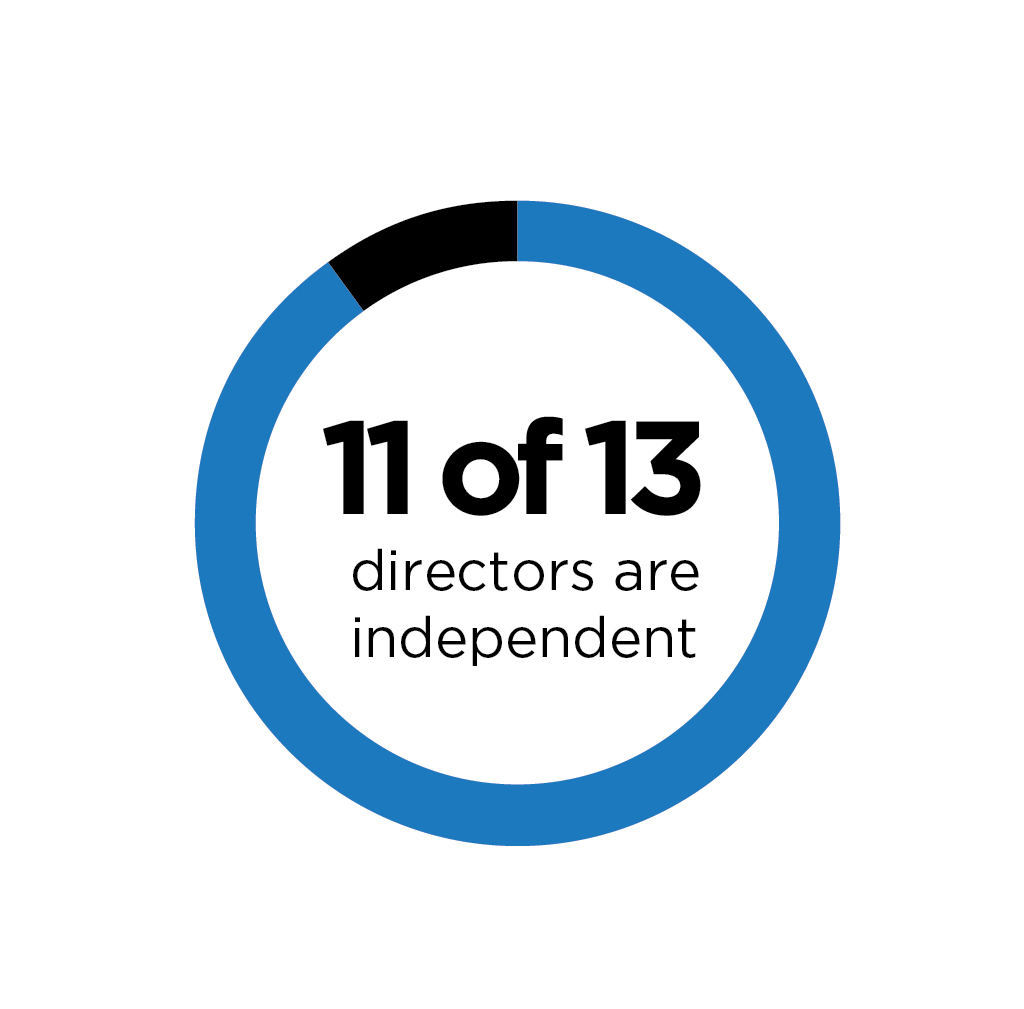 |  | 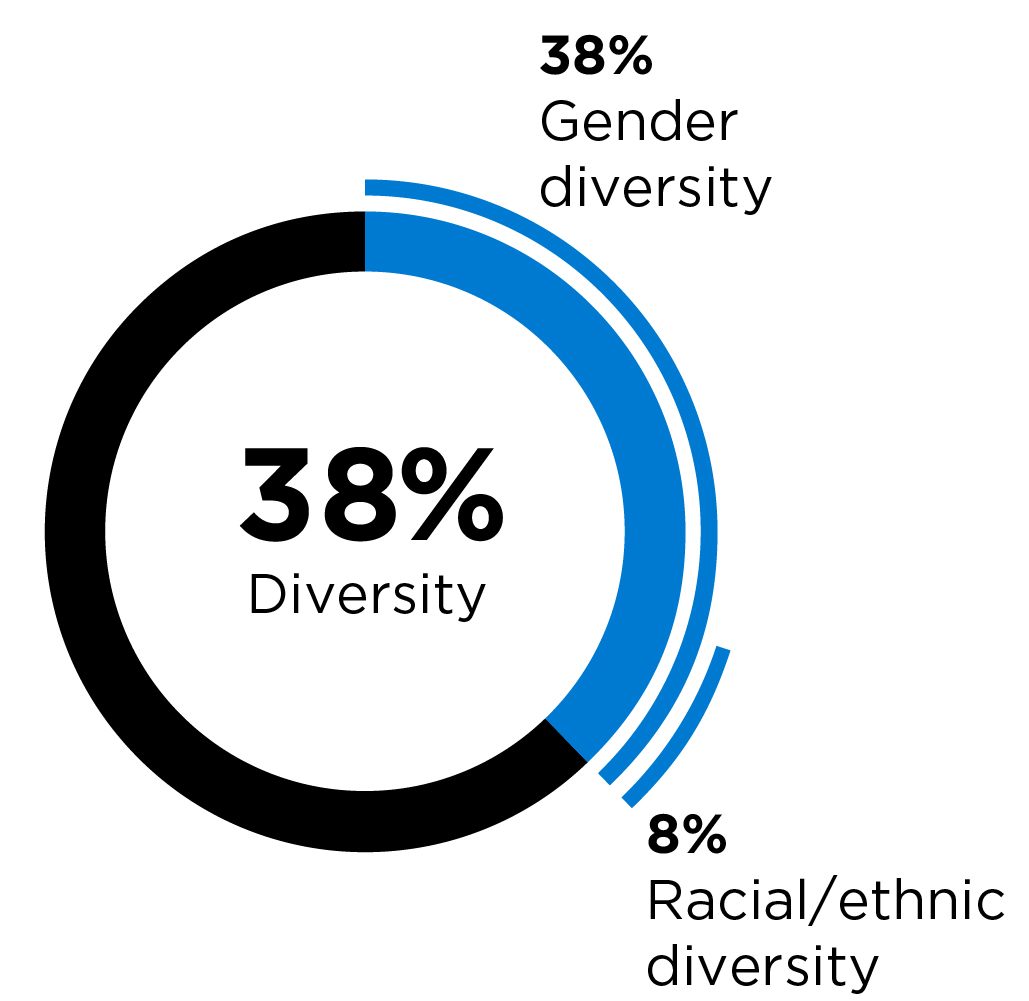 | 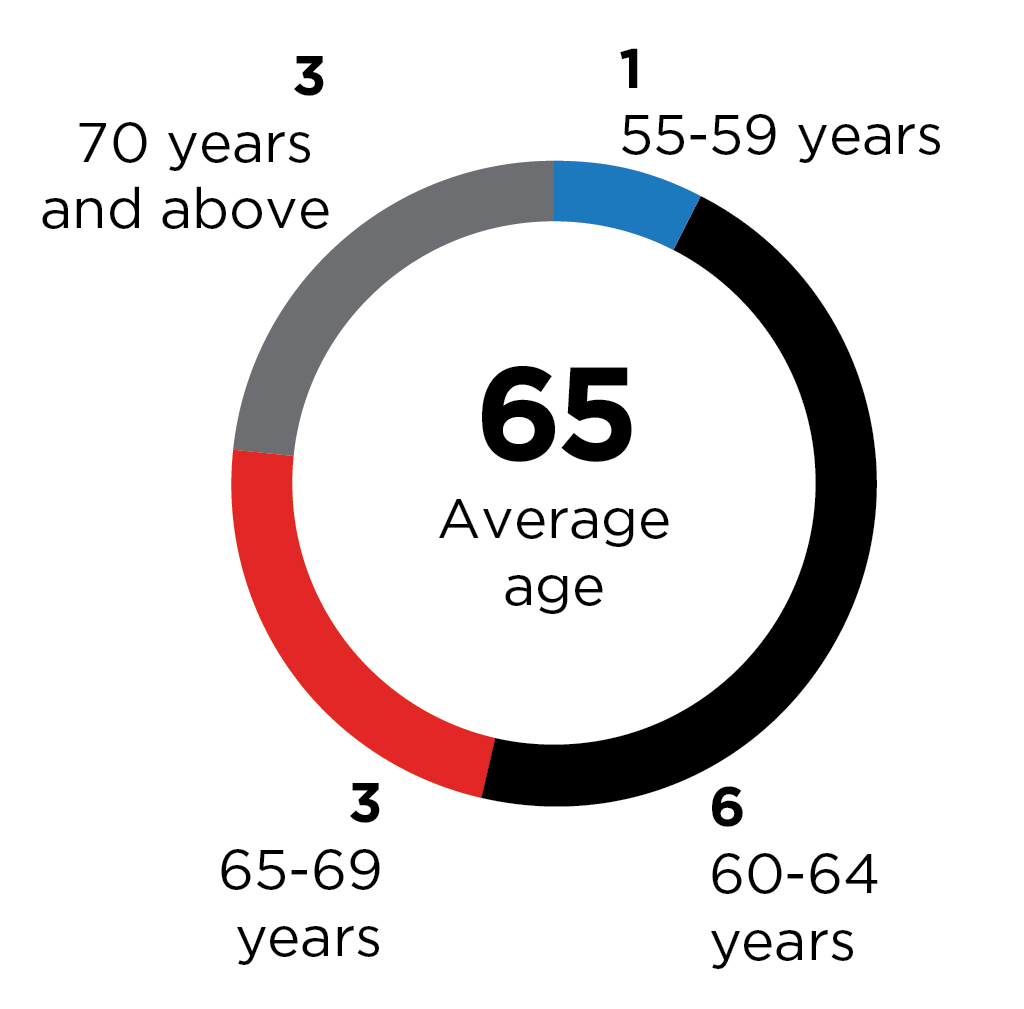 | ||||||||
|
|
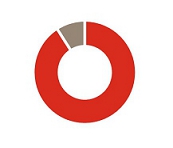 |  |  |  Phillips 66 2023 Proxy Statement | ||||
2020 PERFORMANCE HIGHLIGHTS
| BOARD OVERVIEW | |||||||||||||||||||||||||||||||||||
Director Since | Committee Memberships | Other Public Boards | |||||||||||||||||||||||||||||||||
| Name and Primary Occupation | Independent | AFC | HRCC | NGC | PPSC | EC | |||||||||||||||||||||||||||||
| Class II Directors, Current Nominees | |||||||||||||||||||||||||||||||||||
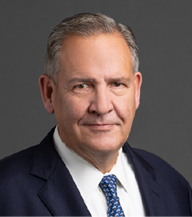 | Gregory J. Hayes, 62 Chairman and Chief Executive Officer of Raytheon Technologies | 2022 |  |  |  |  | 1 | ||||||||||||||||||||||||||||
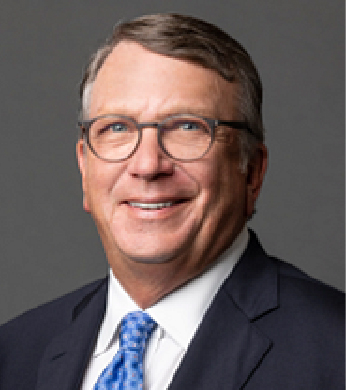 | Charles M. Holley, 66 Former Executive Vice President and Chief Financial Officer of Walmart Inc. | 2019 |  |  |  | 2 | |||||||||||||||||||||||||||||
 | Denise R. Singleton, 60 Executive Vice President, General Counsel and Secretary of WestRock Company | 2021 |  |  |  | 1 | |||||||||||||||||||||||||||||
 | Glenn F. Tilton, 74 Former Chairman and Chief Executive Officer of UAL Corporation | 2012 |  |  |  |  |  | 2 | |||||||||||||||||||||||||||
 | Marna C. Whittington, 75 Former Chief Executive Officer of Allianz Global Investors Capital | 2012 |  |  |  |  |  | 2 | |||||||||||||||||||||||||||
| Class III Directors, Whose Terms Expire in 2024 | |||||||||||||||||||||||||||||||||||
 | Julie L. Bushman, 62 Former Executive Vice President of International Operations of 3M | 2020 |  |  |  | 2 | |||||||||||||||||||||||||||||
 | Mark E. Lashier, 61 President and CEO of Phillips 66 | 2022 |  | 0 | |||||||||||||||||||||||||||||||
 | Lisa A. Davis, 59 Former member of Managing Board of Siemens AG and CEO for Siemens Gas and Power | 2020 |  |  |  | 3 | |||||||||||||||||||||||||||||
 | Douglas T. Terreson, 61 Former Head of Energy Research at Evercore ISI | 2021 |  |  |  | 0 | |||||||||||||||||||||||||||||
| Class I Directors, Whose Terms Expire in 2025 | |||||||||||||||||||||||||||||||||||
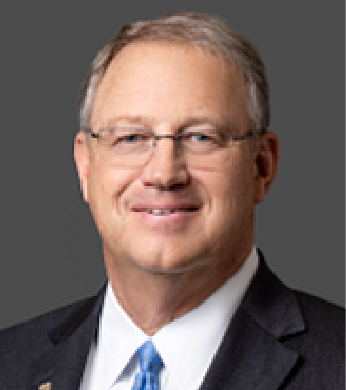 | Greg C. Garland, 65 Executive Chairman and Former CEO of Phillips 66 | 2012 |  | 1 | |||||||||||||||||||||||||||||||
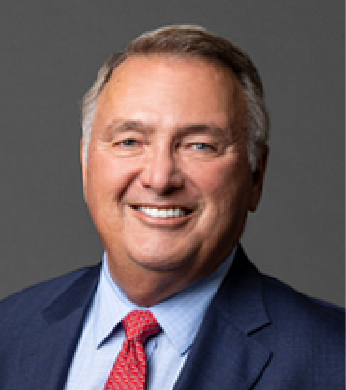 | Gary K. Adams, 72 Former Chief Advisor - Chemicals for IHS Markit | 2016 |  |  |  | 0 | |||||||||||||||||||||||||||||
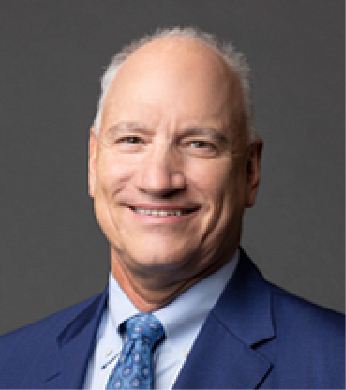 | John E. Lowe, 64 Former Senior Executive Advisor to Tudor, Pickering, Holt & Co. | 2012 |  |  |  |  |  | 1 | |||||||||||||||||||||||||||
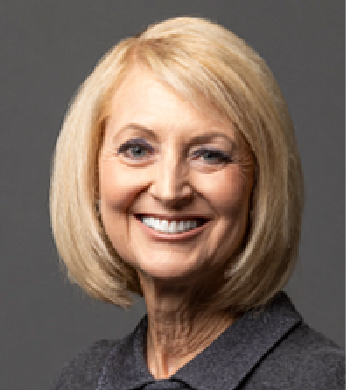 | Denise L. Ramos, 66 Former Chief Executive Officer, President and Director of ITT Inc. | 2016 |  |  |  |  |  | 2 | |||||||||||||||||||||||||||
|
|
|
|
| ||||||||
AFCAudit and Finance | PPSC Public Policy and Sustainability |  | Chair | |||||||||
HRCCHuman Resources and | EC Executive |  | Member | |||||||||
NGC Nominating and
|
|
|
|
| ||||||||
| Proxy Summary | 9 | ||||
PROGRAM OVERVIEW
Our executives’ compensation, includes base salary, anand we align all employees' interests with the execution of short-term priorities through our annual cash bonus, opportunity under ourthe Variable CompensationCash Incentive Program (“VCIP”),.
| |||||||||||
| Key Elements of Pay | Delivered via | Performance Drivers(1) and Weightings | |||||||||
| CEO | Other NEOs | ||||||||||
| Base Salary | Cash | •Annual fixed cash compensation to attract and retain NEOs | |||||||||
 |  | ||||||||||
| Annual Incentive | Variable Cash Incentive Program (VCIP) | Operational Sustainability 50% | |||||||||
 |  | •Safety & Operating Excellence (25%) •Environment (15%) •High-Performing Organization (10%) | |||||||||
| Financial Sustainability 50% | |||||||||||
•Adjusted VCIP EBITDA (40%) •Adjusted Controllable Costs (10%) | |||||||||||
| Long-Term Incentives | Performance Share Program (PSP) | •Adjusted PSP ROCE (50%) | |||||||||
 |  | •Relative total shareholder return (50%) | |||||||||
| Stock Option Program | •Long-term stock price appreciation | ||||||||||
| Restricted Stock Unit (RSU) | •Long-term stock price appreciation | ||||||||||
|
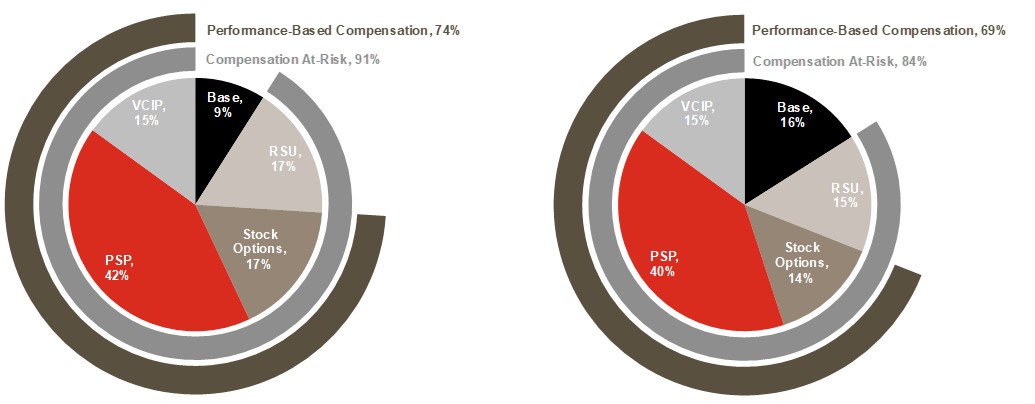
The(1)Adjusted VCIP is designed to align annual bonus awards with shareholder interestsEBITDA, Adjusted Controllable Costs and execution of our corporate strategy. Performance under the VCIP is based on operational andAdjusted PSP ROCE are non-GAAP financial metrics. In 2020, 45% of VCIP was weighted to operational metrics − operating excellence and high-performing organization − and 55% was weighted to financial metrics – adjusted EBITDA and controllable costs. For 2021, the weighting has changed, and two new metrics were added – Low Carbon Priorities and Greenhouse Gas Priorities. These changes were made to reinforce our commitmentmeasures. See Appendix B for reconciliations to the energy transition and further alignnearest GAAP financial measures.
| 10 | Phillips 66 2023 Proxy Statement | ||||
Our visionOVERVIEW
We also are committed to achieving a high-performing organization that is focused on culture, inclusionsocial responsibility and diversity, as well as building community through volunteerism, financial support, and engagement, including community awareness and education.
Moregovernance. For information can be found in the CORPORATE RESPONSIBILITY sectionregarding how our Board oversees sustainability matters, see pages 31-32 of this Proxy Statement.
| |||||
| Sustainability and Transition to Lower- Carbon Future | •Reached a final investment decision on Rodeo Renewed, which will convert our San Francisco refinery into one of the world's largest renewable fuels production facilities. •Continued to conduct research on energies of the future, including renewable fuels and current and next generation batteries at our Bartlesville Innovation Center. •Announced a 2050 GHG emissions intensity reduction target to further reduce Scope 1 and Scope 2 emissions intensity by 50%, as compared to 2019 levels. •Leveraged existing infrastructure, digital investments, supply networks and capabilities to participate in lower-carbon opportunities. | ||||
| Community Involvement and Engagement | •Helped students prepare for the workforce by contributing $9.6 million to education and literacy programs supporting 16 local schools and school districts, 29 colleges and universities and 196 scholarship recipients. •Supported community safety and preparedness by donating $3.9 million, including $1.3 million in disaster relief, supporting 40 local emergency responder departments and 9 food banks. •Contributed $3.1 million supporting environmental and sustainability programs at 27 community parks and 26 conservation projects. •Donated $3 million toward civic enrichment through 9 United Way campaigns and 11 inclusion and diversity programs. | ||||
| Political and Lobbying Activities | •Received “Trendsetter” ranking by the 2022 CPA-Zicklin Index of Corporate Political Disclosure and Accountability. This is the second consecutive year we have received this recognition for the transparency and accountability of our corporate political spending. •Continued participating in the political process to educate policymakers and stakeholders in support of laws and regulations that meet societal and business needs while promoting federal, state and local economies. | ||||
| Proxy Summary | 11 | ||||
INFORMATION REGARDING THE BOARD OF DIRECTORS
In making independence determinations, the Board specifically considered the fact that many of our directors are directors of companies with which we may conduct business. Additionally, some of our directors may purchase products, such as gasoline from our retail sites, from the Company. In all cases, it was determined that there are no relationships or transactions that are material to the Company or the director and accordingly, there are no relationships that would affect the independence of any director other than Mr. Garland.
Executive Sessions of Independent Directors
The independent directors hold regularly scheduled executive sessions of the Board and its committees without Company management present. These executive sessions are chaired by the Lead Director at Board meetings or by the committee chairs at committee meetings.
Chairman and CEO Roles
The Board of Directors believes that currently, it is in the best interests of the Company and shareholders to combine the roles of Chairman and CEO. However, there is no Company policy regarding whether the roles should be combined or separated, and our Corporate Governance Guidelines state that the Board will retain flexibility and periodically consider whether the roles should be separated and, if so, the Chairman should be an independent director or an employee. The Board believes that Mr. Garland’s extensive industry experience and direct, day-to-day involvement in managing the Company as the CEO makes him best suited to also serve as Chairman and guide the Board in setting Company priorities and addressing Company risks and challenges.
Independent Director Leadership
Our Corporate Governance Guidelines state that when the Chairman of the Board is an employee of the Company, the non-employee directors will name a Lead Director. Glenn Tilton was appointed to serve as our Lead Director in 2016. As Lead Director, Mr. Tilton chairs executive sessions, coordinates the activities of the non-employee directors and performs other duties and responsibilities as determined by the Board, including:
|
|
The Board of Directors believes that its current structure and processes encourage its non-employee directors to be actively involved in guiding its work. The chairs of the Board's committees review their respective agendas and committee materials in advance of each meeting, communicating directly with other directors and members of management as each deems appropriate. Moreover, each director may suggest agenda items and raise matters that are not on the agenda at Board and committee meetings.
BOARD MEETINGS, COMMITTEES AND MEMBERSHIP
The Board of Directors met six times in 2020. In addition to the regularly scheduled meetings of the Board, in October of each year, the Board holds a two-day strategy session with members of management to provide deep dives into the Company’s operating segments and corporate functions. All of our directors attended at least 75% of the meetings of the Board and committees on which they served. Recognizing that director attendance at the Company's annual meeting can provide the Company's shareholders with an opportunity to communicate with the directors about issues affecting the Company, the Company actively encourages directors to attend the annual meetings of shareholders. All of our directors who were serving as such as of the date of our 2020 Annual Meeting attended virtually.
BOARD COMMITTEES AND MEMBERSHIP
The Board has five standing committees, as described below. The charters for each of the committees may be found in the “Investors” section on the Phillips 66 website (www.phillips66.com) under the “Corporate Governance” caption. Shareholders may also request printed copies of these charters by following the instructions located under ADDITIONAL INFORMATION. Other than our Executive Committee, all members of our Board’s committees meet the independence standards under our Corporate Governance Guidelines, the NYSE listing standards, and SEC rules or regulations, as applicable. The tables below show the composition of the committees as of March 15, 2021; as disclosed elsewhere in this Proxy Statement, Mr. McGraw and Ms. Tschinkel retired from the Board at the end of March 2021 and will not continue to serve as members of the committees.
|
|
| ||
| ||
| ||
| ||
| ||
|
|
| ||
| ||
| ||
| ||
| ||
| ||
To ensure continued Board effectiveness, the Nominating and Governance Committee periodically considers committee rotations, including in the event of a change in the composition of the Board. In 2020, J. Brian Ferguson, who previously had served as Chair of the Audit Committee, retired and the Nominating and Governance Committee recommended, and the Board approved, the appointment of Mr. Lowe as Chair of the Audit Committee and Ms. Ramos as Chair of the Public Policy and Sustainability Committee.
Additionally, in 2020 the Public Policy Committee changed its name to the Public Policy and Sustainability Committee. This name change was in connection with revisions to the committee’s charter that broadened the scope of its responsibilities to specifically include oversight of the Company’s sustainability program and initiatives.
|
|
BOARD'S ACTIVE ROLE IN RISK OVERSIGHT
The Company's management is responsible for the day-to-day conduct of our businesses and operations, including management of risks the Company faces. To fulfill this responsibility, our management has established an enterprise risk management (“ERM”) program. The program is designed to identify and facilitate the management of significant risks facing the Company as well as the approaches to addressing risks.
The Board of Directors has broad oversight responsibility over the Company's ERM program and receives management updates on its development and implementation. In this oversight role, the Board is responsible for satisfying itself that the risk management processes designed and implemented by the Company's management are functioning as intended, and that necessary steps are taken to foster a culture of risk-adjusted decision making throughout the organization.
The Board exercises its oversight responsibility for risk assessment and risk management directly and through its committees. However, the full Board maintains responsibility for oversight of strategic risks. Setting the strategic course of the Company and providing oversight of strategic risks involves a high level of constructive engagement between management and the Board. The Board regularly discusses the strategic priorities of the Company and the risks to the Company's successful execution of its strategy, including global economic and other significant trends, as well as changes in the energy industry and regulatory initiatives.
The Board of Directors receives regular updates from its committees on individual areas of risk falling within each committee's area of oversight and expertise, as outlined below.
Committee Risk Oversight Responsibilities
Audit Committee
The Audit Committee has primary responsibility for overseeing Phillips 66’s ERM program. The Audit Committee discusses the guidelines and policies to govern the process by which ERM is handled, and has been delegated responsibility to facilitate coordination among the Board's committees with respect to the Company's risk management programs. The Audit Committee’s meeting agendas throughout the year include discussions of individual risk areas, as well as an annual summary of the ERM process. The Audit Committee also oversees the Company’s information security (including cybersecurity) and technology risk management programs, which are fully integrated into the overall ERM program.
Public Policy and Sustainability Committee
The Public Policy and Sustainability Committee assists the Board in identifying, evaluating and reviewing social, political and environmental trends and related risks. It also reviews management's proposed actions to anticipate and adjust to such trends and manage risks to achieve the Company's long-term business goals. The Public Policy and Sustainability Committee considers risks relating to: (i) the health, safety and environmental matters; (ii) the Company’s lobbying priorities and activities; (iii) Company issues related to public policy, including political spending policies and practices; (iv) Company issues related to corporate social responsibility and sustainability; and (v) emerging issues potentially affecting the reputation of the energy industry and the Company.
Other Board Committees
The Board’s other committees oversee risks associated with their respective areas of responsibility. For example:
• The Compensation Committee considers the risks associated with our compensation policies and practices for both executive compensation and compensation generally, as well as corporate culture and human capital risks generally.
• The Nominating and Governance Committee reviews policies and practices in the areas of corporate governance and is responsible for overseeing Board composition and director qualifications through the nomination process. Additionally, the Nominating and Governance Committee is responsible for CEO succession planning.
|
|
Our Code of Business Ethics and Conduct requires all directors and executive officers to promptly report any transactions or relationships that reasonably could be expected to constitute a related party transaction. The transaction or relationship is reviewed by the Company's management and the appropriate committee of the Board to ensure that it does not constitute a conflict of interest and is appropriately disclosed.
Additionally, the Nominating and Governance Committee conducts an annual review of related party transactions between each director and the Company and its subsidiaries in making recommendations to the Board regarding the continued independence of each director. Since January 1, 2020, there have been no related party transactions in which the Company or a subsidiary was a participant and in which any director, executive officer, or any of their immediate family members had a direct or indirect material interest.
The Nominating and Governance Committee also considered relationships that, while not constituting related party transactions where a director had a direct or indirect material interest, nonetheless involved transactions between the Company and an organization with which a director is affiliated, either directly or as a partner, shareholder or officer. The Nominating and Governance Committee determined that there were no transactions impairing the independence of any member of the Board.
DIRECTOR QUALIFICATIONS AND NOMINATION PROCESS
Director Skills and Qualifications Aligned with Company Strategy
In evaluating potential candidates for nomination to the Board, as well as evaluating the Board's overall composition, the Nominating and Governance Committee and the Board consider several factors. First, all directors are expected to possess the highest personal and professional ethics, integrity and values and be committed to representing the long-term interests of the Company's shareholders. Additionally, directors are expected to devote sufficient time and effort to their duties as a director.
The Nominating and Governance Committee believes that the Board should reflect a range of talents, ages, skills, experiences, diversity, and expertise sufficient to provide sound and prudent guidance with respect to the Company's strategic and operational objectives. The Board has committed to seeking women and minority candidates, as well as candidates with diverse backgrounds, skills and experiences, as part of the search process for new directors.
The core skills and qualifications considered in evaluating director nominees and Board composition as a whole are described below.
|
|
| ||
|
|
|
|
|
Board Refreshment
The Board strives to maintain an appropriate balance of tenure, turnover, diversity, skills and experience. Our average director tenure is five years, representing an appropriate balance of tenures. The Board does not maintain term limits, as the Board believes that continuity of service can provide stability and valuable insight. Our Corporate Governance Guidelines include a mandatory retirement that provides that no director may serve past the annual meeting immediately following his or her 75th birthday. The average age of our continuing directors is 65.
The Board ensures refreshment and continued effectiveness through evaluation, nomination, and other policies, processes and practices. For example:
Recent Board Refreshment
In 2020, the Board appointed Julie L. Bushman and Lisa A. Davis. These directors’ skills and perspectives further enhance our diversity and expertise in the boardroom. Their appointments were informed by the Board’s continued focus on its composition, as well as insights provided through the Board’s annual self-evaluation process. In March of this year, Harold W. McGraw III and Victoria J. Tschinkel, who have served on our Board since 2012, informed us that they would be retiring from the Board and not standing for reelection at this Annual Meeting.
How We Select Our Director Nominees
The Board is responsible for nominating directors and filling vacancies that may occur between annual meetings, based upon the recommendation of the Nominating and Governance Committee. The Nominating and Governance Committee considers the Company’s current needs and long-term and strategic plans to determine the skills, experience and characteristics needed by our Board. The Nominating and Governance Committee identifies, considers and recommends director candidates to the Board of Directors with the goal of creating a balance of knowledge, experience and diversity. Generally, the Nominating and Governance Committee identifies candidates through the use of a search firm or the business and organizational contacts of directors and management. In 2018, the Board amended our Corporate Governance Guidelines to formalize its commitment to ensuring that the pool of candidates in any search process for new directors includes diverse candidates.
Shareholder Recommendation of Candidates
The Nominating and Governance Committee will consider director candidates recommended by shareholders. A shareholder wishing to recommend a candidate for nomination by the Nominating and Governance Committee should follow the procedures described under SUBMISSION OF FUTURE SHAREHOLDER PROPOSALS AND DIRECTOR NOMINATIONS. In addition, the shareholder should provide such other information deemed relevant to the Nominating and Governance Committee's evaluation. Candidates recommended by the Company's
|
|
shareholders are evaluated on the same basis as candidates recommended by the Company's directors, management, third-party search firms or other sources.
Throughout the year, the Board continued its proactive assessment of board succession planning and refreshment. The Nominating and Governance Committee and full Board works to ensure we maintain a Board that embodies a broad and diverse set of experiences, qualifications, attributes and skills to provide effective oversight of management and the Company. When seeking new candidates, the Board considers a diverse pool of qualified candidates who could potentially serve as Board members. We view diversity in terms of skills, as well as gender, age, race, ethnicity, background, professional experience and perspectives.
As the needs of the Company change, the Board revisits the skills and experiences it seeks. Included in the matrix below are the core skills and experiences of C-suite, environmental, risk management, international/global and industry experience, as well as additional skills and experiences the Board currently considers, for our continuing directors.
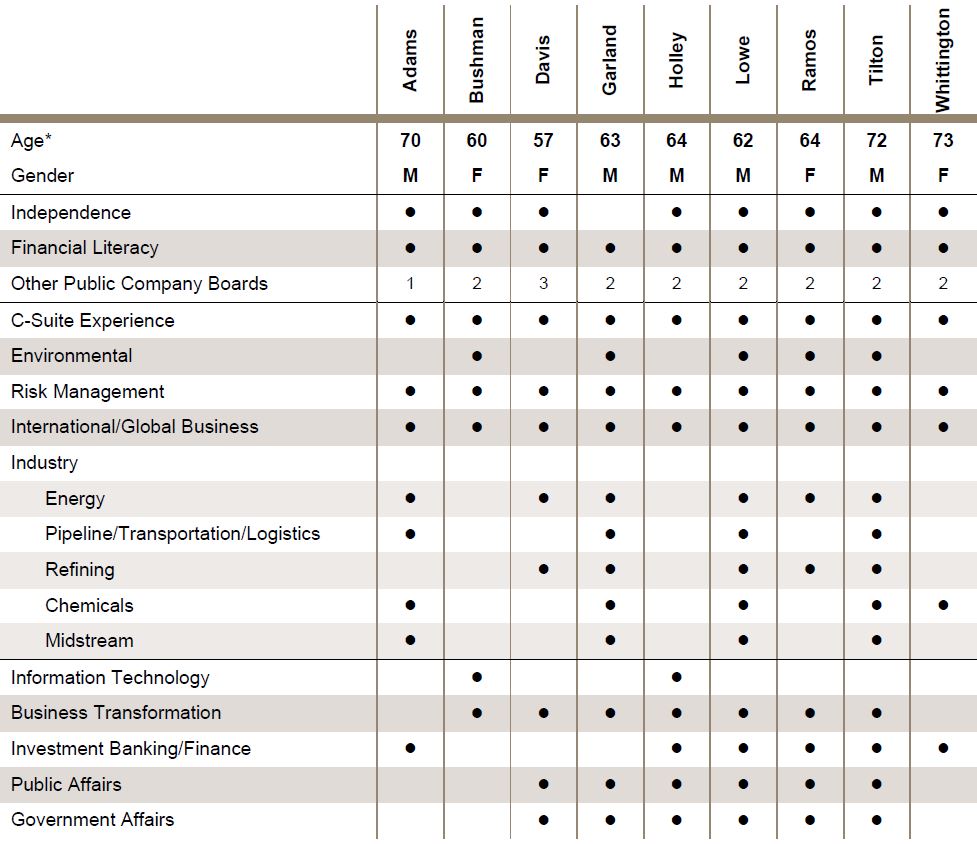
*As of March 15, 2021
|
|
Directors Whose Terms Expire at the 2022 Annual Meeting
 |
| ||
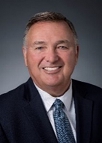 |
| ||
 |
| ||
|
|
 |
| ||
Directors Whose Terms Expire at the 2023 Annual Meeting
 |
| ||
 |
| ||
|
|
 |
| ||
|
PROPOSAL 1: ELECTION OF DIRECTORS
The Board has nominated Julie L. Bushman and Lisa A. Davis to stand for election for a term that expires at the annual meeting of shareholders in 2024. Mr. McGraw and Ms. Tschinkel previously served in this class of directors, but both decided to retire in March of this year and not stand for reelection. Although Ms. Davis originally was appointed to the Board to serve in the class whose term ends at the annual meeting in 2023, the Board determined that Ms. Davis should stand for election at this meeting to make the classes of directors as nearly equal as possible.
Each nominee requires the affirmative vote of a majority of the votes cast in person or by proxy at the meeting. Directors are elected to serve until their successor is duly elected and qualified. If a nominee is unavailable for election, proxy holders may vote for another nominee proposed by the Board or the Board may reduce the number of directors to be elected at the Annual Meeting. No family relationship exists among any of our directors, director nominees or executive officers. There is no arrangement between any director or director nominee and any other person pursuant to which he or she was, or is to be, selected as a director or director nominee.
| ||||
 |
| |||
 |
| ||
|
|
PROPOSAL 2: MANAGEMENT PROPOSAL REGARDING ANNUAL ELECTION OF DIRECTORS
Currently, the Amended and Restated Certificate of Incorporation (the “Certificate of Incorporation”) of the Company provides for a staggered Board, divided into three classes of directors, with each class elected for a three-year term.
After considering the advantages and disadvantages of declassification, including the opinion of our shareholders, the Board has determined it is in the best interests of the Company and its shareholders to amend the Certificate of Incorporation and the By-Laws of the Company to declassify the Board over the next three years. This will result in a fully declassified Board by the 2024 Annual Meeting of Shareholders.
|
The affirmative vote of the holders of 80% of the outstanding shares of stock entitled to vote is required to approve this proposal. We submitted this proposal in 2015, 2016 and 2018 and, while it received significant support, it did not receive the 80% vote required for adoption. Because brokers may not cast a vote on this proposal without your instruction, it is very important that you vote your shares.
The proposed amendment to the Certificate of Incorporation would eliminate the classification of the Board over a three-year period and provide for the annual election of all directors beginning at the 2024 Annual Meeting of Shareholders. The proposed amendment to the Certificate of Incorporation would become effective upon the filing of a Certificate of Amendment with the Secretary of State of the State of Delaware, which the Company would file promptly following the Annual Meeting if our shareholders approve the amendment. Board declassification would be phased-in over a three-year period, beginning at the 2022 Annual Meeting of Shareholders, as follows:
Beginning with the 2024 Annual Meeting of Shareholders, all directors will stand for election at each annual meeting of shareholders for a one-year term expiring at the subsequent annual meeting of shareholders. The proposed amendment does not change the number of directors or the Board's authority to change that number and to fill any vacancies or newly created directorships.
Delaware law provides, unless otherwise addressed in the certificate of incorporation, that members of a board that is classified may be removed only for cause. The proposed amendment provides that, once the Board is fully declassified as of the 2024 Annual Meeting of Shareholders, directors may be removed with or without cause. Before that time, directors serving in a class elected at any annual meeting between 2019 through 2021 may be removed only for cause. Directors elected for a one-year term at each annual meeting between 2022 through 2023 may be removed with or without cause.
The proposed Certificate of Amendment to the Certificate of Incorporation is attached to this Proxy Statement as Appendix A. If our shareholders approve the proposed amendment to the Certificate of Incorporation, the Board will make certain conforming changes to the Company’s By-Laws.
|
|
BENEFICIAL OWNERSHIP OF PHILLIPS 66 SECURITIES
SECURITIES OWNERSHIP OF CERTAIN BENEFICIAL OWNERS
The following table sets forth information regarding persons who we know to be the beneficial owners of more than five percent of our issued and outstanding common stock as of December 31, 2020. The information is based on reports filed by such person with the SEC:
| NAME AND ADDRESS | NUMBER OF SHARES | PERCENT OF CLASS | ||
The Vanguard Group(1) 100 Vanguard Blvd. Malvern, PA 19335 | 42,759,263 | 9.79 | % | |
BlackRock, Inc.(2) 55 East 52nd Street New York, NY 10055 | 32,908,454 | 7.5 | % | |
State Street Corporation(3) One Lincoln Street Boston, MA 02111 | 26,710,734
| 6.12 | % | |
SECURITIES OWNERSHIP OF OFFICERS AND DIRECTORS
This table lists the beneficial ownership of our common stock as of February 15, 2021, by all directors and nominees, the executive officers named in the Summary Compensation Table, and by all of our directors and executive officers as a group. Together these individuals beneficially own less than one percent of our common stock.
|
|
| NUMBER OF SHARES OR UNITS | |||
| NAME OF BENEFICIAL OWNER | SHARES | RESTRICTED OR | OPTIONS |
| Mr. Garland | 532,974 | 109,885 | 1,111,733 |
| Mr. Herman | 39,760 | 75,762 | 169,866 |
| Ms. Johnson | 77,416 | 26,787 | 193,333 |
| Mr. Mitchell | 49,047 | 39,777 | 172,599 |
| Mr. Roberts | 11,367 | 29,491 | 122,166 |
| Mr. Adams | 12,984 | -- | -- |
| Ms. Bushman | -- | 4,305 | -- |
| Ms. Davis | 3,646 | -- | -- |
| Mr. Holley | 77 | 5,775 | -- |
| Mr. Lowe | 40,000 | 30,403 | -- |
| Mr. McGraw(3) | 873 | 52,122 | -- |
| Ms. Ramos | -- | 12,773 | -- |
| Mr. Tilton | 5,900 | 30,403 | -- |
| Ms. Tschinkel | 51,757 | 9,303 | -- |
| Dr. Whittington | 2,500 | 30,403 | -- |
| Directors and Executive Officers as a Group (17 Persons) | 858,259 | 488,437 | 1,882,529 |
|
|
At Phillips 66, we believe that we succeed together as a team, leveraging our diverse experiences and thoughts in an environment that thrives on collaboration. We embrace engagement as an important tenet of good governance, and value the views of our shareholders and other stakeholders. We believe that positive dialogue builds informed relationships that promote transparency and accountability. Although our Lead Director or other members of the Board are available to participate in meetings with shareholders as appropriate, management has the principal responsibility for shareholder communication.
For several years, Phillips 66 has conducted a formal shareholder outreach program to listen to investor perspectives on our business strategy; corporate governance; executive compensation programs; environmental, social and governance (“ESG”); and other matters that are important to our investors. Information and feedback received through our engagement activities are shared with our executive leadership team and the Board of Directors, which help inform their decisions and oversight, respectively. In 2020, we engaged with representatives of many of our top institutional shareholders and discussed the energy transition and our sustainability efforts; board composition, refreshment and tenure; inclusion and diversity; our response to COVID-19; and executive compensation. Our year-round focus on investor engagement is described below:
|  |
|
|
|
This year, we heard that our investors are interested in, and supportive of, our Board refreshment efforts, as well as our work towards setting targets for greenhouse gas emissions reductions. We also heard that investors are interested in additional disclosures on human capital management and our efforts to declassify our Board. We are committed to continued shareholder engagement. Highlights of some of the actions we have taken in response to our engagements over the last several years are shown below:
| 2015 | 2016 | 2017 | 2018 | 2019 | 2020 | 2021 |
Adopted proxy access bylaw Sought shareholder approval of declassification Refreshed sustainability information on website | Added two new independent directors Sought shareholder approval of declassification
| Expanded sustainability disclosures from website to report
| Committed to diverse director candidate pools Sought shareholder approval of declassification Initial TCFD*-informed sustainability report | Added new independent director
| Incorporated TCFD* and SASB* into sustainability report Added two new independent directors Enhanced lobbying disclosures | Seeking shareholder approval of declassification Published Human Capital Management Report
|
*TCFD is the Task Force on Climate-Related Financial Disclosures and SASB is the Sustainability Accounting Standards Board.
|
|
Our Board recognizes the importance of our human capital practices in creating value and supporting our vision. Our ability to attract, retain and develop talented employees, and create a workplace where they can innovate and thrive, is an integral part of our competitive strategy to drive long-term value and mitigate risk.
To that end, our Board routinely engages with senior leadership on matters such as talent pipeline, turnover, workplace culture, and inclusion and diversity. Results of employee surveys and metrics on talent and diversity initiatives are reviewed by the Board on a regular basis. This oversight responsibility sits with the full Board. In addition, certain human capital metrics have been and continue to be measured, reviewed and managed as part of our compensation program and are discussed by the Compensation Committee in its regular meetings. The table below provides an overview of certain of our human capital practices. More information regarding our human capital practices can be found in our Human Capital Management Report on our website at www.phillips66.com.
| ||
|
| |
|
|
|
|
|
|
The communities in which our assets are located and where our employees live are critical stakeholders. We consistently and regularly engage with our local communities and seek their feedback. Our refining operations have community advisory councils or panels that include both Company representatives and community members. Many panels include adjacent operations from our midstream and lubricants businesses. These panels meet at least quarterly with refinery management to provide feedback, discuss topics of local concern and share insights on plans and activities. Our pipeline business units have year-round community awareness, education and listening panels to stay connected with those involved with and living near our extensive pipeline network.
 | SPOTLIGHT ON OUR GHG EMISSIONS REDUCTION TARGETS | ||||
30% ↓ | 15% ↓ | 50% ↓ | ||||||||||||
| Manufacturing-related emissions intensity Scope 1 and 2 from operated assets by 2030 | Products manufactured and sold emissions intensity Scope 3 from operated assets by 2030 | Manufacturing-related emissions intensity Scope 1 and 2 from operated assets by 2050 | ||||||||||||
| 12 | Phillips 66 2023 Proxy Statement | ||||
PROPOSAL 1  | Election of 5 Class II Directors to hold office until the 2026 Annual Meeting The Board recommends that you vote “FOR” the election of the five Class II director nominees. | ||||
 | CORE DIRECTOR SKILLS | ||||
 | C-Suite Experience |  | Financial |  | Global Business | ||||||||||||
| C-suite experience provides valuable insights and practical understanding of companies, and the methods to drive change and growth within an organization | Finance and financial reporting experience provide knowledge necessary to evaluate our performance by reference to financial targets and to oversee financial reporting | Global business or international experience provides valuable perspectives on our operations and enables the oversight of our strategic initiatives | |||||||||||||||
 | Risk Management |  | Environmental |  | Industry Experience | ||||||||||||
| Experience in managing risk ensures capabilities necessary for risk oversight responsibilities, bringing background and experience that increase directors’ effectiveness | Experience in environmental regulation helps in effective evaluation and oversight of our strategy to provide energy and improve lives while ensuring a healthy and safe environment | Energy experience brings pertinent background and knowledge to provide perspective on issues specific to the Company’s industry, business, operations and strategy | |||||||||||||||
| 13 | ||
| Gregory J. Hayes | |||||
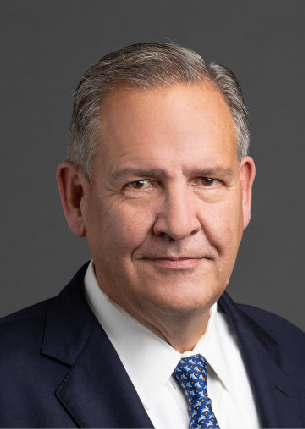 Age: 62 Director since: 2022 Committees: Compensation; Nominating and Governance; Public Policy and Sustainability | Career Highlights: •Chairman and Chief Executive Officer, Raytheon Technologies Corporation (since June 2021) •Former President, Chief Executive Officer and Director, Raytheon Technologies Corporation (April 2020 to June 2021) •Former Chairman and Chief Executive Officer, United Technologies Corporation (2016 to April 2020) •Former director of Nucor Corporation (2014 to 2018) Experience and Key Skills: Mr. Hayes is the chairman and chief executive officer of Raytheon Technologies Corporation, responsible for leading an aerospace and defense company of 174,000 employees and $64 billion in annual sales. During his career, Mr. Hayes has held senior leadership roles across finance, corporate strategy and business development. Mr. Hayes brings substantial experience in executive leadership, finance, strategic planning, mergers and acquisitions, business development, and global operations and management to the Board. | |||||||||||||||||||
 C-Suite Experience |  Financial |  Global Business |  Risk Management | |||||||||||||||||
Other Current Public Company Directorships: •Raytheon Technologies Corporation | ||||||||||||||||||||
| Charles M. Holley | |||||
 Age:66 Director since:2019 Committees: Audit; Public Policy and Sustainability | Career Highlights: •Former Executive Vice President and Chief Financial Officer of Walmart Inc. (2010 to 2015) Experience and Key Skills: Mr. Holley served as Executive Vice President and Chief Financial Officer at one of the largest U.S. corporations, providing him with expertise in finance, senior management, risk and asset management, strategic planning and capital markets. From 2016 to 2019, Mr. Holley served as an independent senior advisor, U.S. CFO Program, Deloitte LLP. He also has extensive experience in international operations and technology platforms. | |||||||||||||||||||
 C-Suite Experience |  Financial |  Global Business |  Risk Management | |||||||||||||||||
Other Current Public Company Directorships: •Amgen •Carrier Global | ||||||||||||||||||||
| 14 | Phillips 66 2023 Proxy Statement | ||||
| Denise R. Singleton | |||||
 Age: 60 Director since: 2021 Committees: Audit; Public Policy and Sustainability | Career Highlights: •Executive Vice President, General Counsel and Secretary of WestRock Company (since March 2022) •Former Senior Vice President, General Counsel and Corporate Secretary of IDEX Corporation (2015 to March 2022) Experience and Key Skills: Ms. Singleton was named Executive Vice President, General Counsel and Secretary of WestRock Company in March 2022. Ms. Singleton has extensive legal and corporate governance experience. Previously, she was Senior Vice President, General Counsel and Corporate Secretary of IDEX Corporation, a position she held from 2015 to 2022. Prior to joining IDEX, Ms. Singleton served as Senior Vice President, General Counsel, Corporate Secretary and Chief Compliance Officer at SunCoke Energy, Inc. and its controlled company SunCoke Energy Partners, L.P., where she was on the board of directors, from 2011 to 2015. Prior to joining SunCoke Energy, Ms. Singleton held several positions at PPG Industries, Inc., and was a partner at Shaw Pittman LLP, a law firm. | |||||||||||||||||||
 C-Suite Experience |  Financial |  Global Business |  Risk Management |  Environmental | ||||||||||||||||
Other Current Public Company Directorships: •Teledyne Technologies Incorporated | ||||||||||||||||||||
| Glenn F. Tilton | |||||
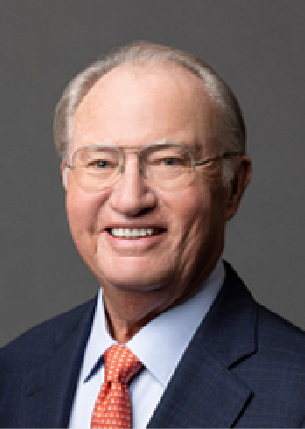 Age: 74 Director since: 2012 Committees: Compensation; Nominating and Governance (Chair); Public Policy and Sustainability; Executive | Career Highlights: •Former Chairman of the Midwest, JPMorgan Chase (2011 to 2014) •Former Non-Executive Chairman, United Continental Holdings (2010 to 2012) •Former Chairman and Chief Executive Officer of UAL Corporation (2002 to 2010) Experience and Key Skills: Mr. Tilton previously served as chairman and chief executive officer of UAL Corporation, the parent company of United Air Lines, as well as chairman of the Midwest of JPMorgan Chase & Co. Mr. Tilton’s career has provided him with strong management experience overseeing complex multinational businesses operating in highly regulated industries as well as expertise in finance and capital markets matters. He also has extensive experience in the energy industry through his more than 30 years in increasingly senior roles with Texaco Inc., including chairman and chief executive officer. | |||||||||||||||||||
 C-Suite Experience |  Financial |  Global Business |  Risk Management |  Environmental |  Industry Experience | |||||||||||||||
Other Current Public Company Directorships: •Abbott Laboratories •AbbVie Inc. | ||||||||||||||||||||
| Proposal 1: Election of Directors | 15 | ||||
| Marna C. Whittington | |||||
 Age: 75 Director since: 2012 Committees: Compensation (Chair); Nominating and Governance; Public Policy and Sustainability; Executive | Career Highlights: •Former Chief Executive Officer of Allianz Global Investors Capital (2002 to 2012) •Former director of Macy's Inc. (1993 to 2022) Experience and Key Skills: Dr. Whittington has many years of leadership experience and expertise as a former senior executive in the investment management industry, including as chief executive officer of Allianz Global Investors Capital. She has extensive knowledge of and substantial experience in management, and in financial, investment and banking matters and provides valuable insight from her previous experience serving as a public company board member. | |||||||||||||||||||
 C-Suite Experience |  Financial |  Global Business |  Risk Management |  Industry Experience | ||||||||||||||||
Other Current Public Company Directorships: •Oaktree Capital Group LLC •Ocugen Inc. | ||||||||||||||||||||
| Gary K. Adams | |||||
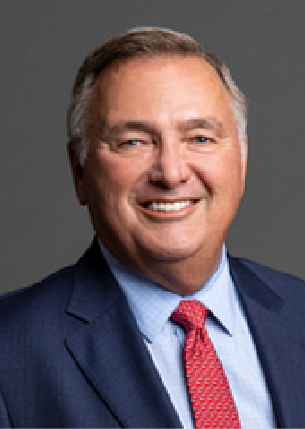 Age: 72 Director since:2016 Committees: Compensation; Public Policy and Sustainability | Career Highlights: •Former Chief Advisor — Chemicals for IHS Markit (2011 to 2017) •Former director of Westlake Chemical Partners LP (2014 to 2016) •Former director of Phillips 66 Partners LP (2013 to 2016) •Former director of Trecora Resources (2012 to 2022) Experience and Key Skills: Mr. Adams has over 40 years of experience in the petrochemicals and plastics industries, including 15 years at Union Carbide, where he began his career. Through various management positions, including as president, chief executive officer and chairman of Chemical Markets Associates Inc. (“CMAI”) before its acquisition by IHS, Mr. Adams also has leadership experience with operating responsibilities, and financial and risk oversight for a global business. | |||||||||||||||||||
 C-Suite Experience |  Financial |  Global Business |  Risk Management |  Industry Experience | ||||||||||||||||
| 16 | Phillips 66 2023 Proxy Statement | ||||
| Julie L. Bushman | |||||
 Age:62 Director since: 2020 Committees: Audit; Public Policy and Sustainability | Career Highlights: •Former Executive Vice President of International Operations of 3M (2017 to 2020) and Senior Vice President of Business Transformation and Information Technology of 3M (2013 to 2017) •Former director of Johnson Controls (2012 to 2016) Experience and Key Skills: As a former executive of 3M, Ms. Bushman brings executive management experience, as well as experience in international business, risk management and financial oversight to the Board. Ms. Bushman also brings environmental experience through her roles leading occupational health and environmental safety divisions at 3M. | |||||||||||||||||||
 C-Suite Experience |  Financial |  Global Business |  Risk Management |  Environmental | ||||||||||||||||
Other Current Public Company Directorships: •Adient plc •Bio-Techne Corporation | ||||||||||||||||||||
| Lisa A. Davis | |||||
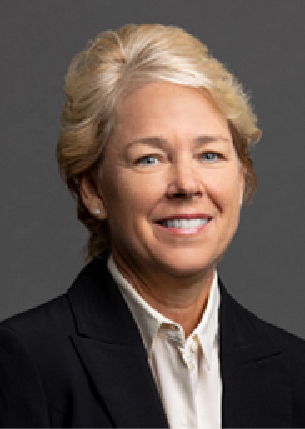 Age: 59 Director since: 2020 Committees: Compensation; Public Policy and Sustainability | Career Highlights: •Former member of Managing Board of Siemens AG and CEO for Siemens Gas and Power (2014 to 2020) •Former director of Kosmos Energy (2019 to 2022) Experience and Key Skills: Ms. Davis brings significant industry experience to the Board through her roles at Siemens, as well as over 25 years in engineering and management roles at large integrated oil companies including ExxonMobil, Texaco and Shell, including executive vice president strategy and portfolio at Shell. | |||||||||||||||||||
 C-Suite Experience |  Financial |  Global Business |  Risk Management |  Industry Experience | ||||||||||||||||
Other Current Public Company Directorships: •Air Products and Chemicals •Penske Automotive Group •C3.ai | ||||||||||||||||||||
| Proposal 1: Election of Directors | 17 | ||||
| Greg C. Garland | |||||
 Age: 65 Director since: 2012 Committees: Executive (Chair) | Career Highlights: •Executive Chairman of Phillips 66 (July 2022 to present) •Former President, Chief Executive Officer and Chairman of Phillips 66 (2012 to July 2022) Experience and Key Skills: Mr. Garland brings extensive knowledge of all aspects of our business and industry to the Board, having served as our president and chief executive officer from 2012 to July 2022, in executive positions at ConocoPhillips, as president and chief executive officer of Chevron Phillips Chemical Company, and as the chairman and chief executive officer of Phillips 66 Partners. Through his more than 35 years of service and experience in the energy industry, Mr. Garland brings to the Board each of the key skills we seek in a director. | |||||||||||||||||||
 C-Suite Experience |  Financial |  Global Business |  Risk Management |  Environmental |  Industry Experience | |||||||||||||||
Other Current Public Company Directorships: •Amgen | ||||||||||||||||||||
| Mark E. Lashier | |||||
 Age: 61 Director since: 2022 Committees: Executive | Career Highlights: •President and Chief Executive Officer of Phillips 66 (since July 2022) •President and Chief Operating Officer of Phillips 66 (2021 to 2022) •President and Chief Executive Officer of Chervon Phillips Chemical Company LLC (2017 to 2021) Experience and Key Skills: Mr. Lashier brings extensive knowledge of our business and industry to the Board, as he serves as our President and Chief Executive Officer and has previously served as president and chief executive officer of Chevron Phillips Chemical Company (CPChem). Prior to that, he held several leadership positions at CPChem, including Executive Vice President of Olefins and Polyolefins; Senior Vice President of Specialties, Aromatics and Styrenics; Vice President of Corporate Planning and Development; Project Director for Saudi Arabia; and Regional Manager in Asia. Mr. Lashier began his career at Phillips Petroleum in 1989 as an Associate Research Engineer. | |||||||||||||||||||
 C-Suite Experience |  Financial |  Global Business |  Risk Management |  Industry Experience | ||||||||||||||||
| 18 | Phillips 66 2023 Proxy Statement | ||||
| John E. Lowe | |||||
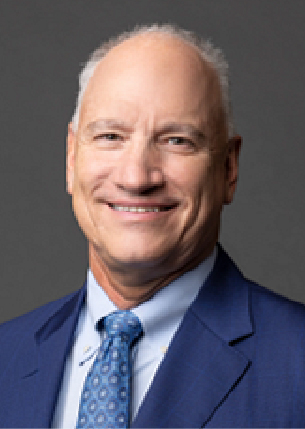 Age:64 Director since: 2012 Committees: Audit (Chair); Nominating and Governance; Public Policy and Sustainability; Executive | Career Highlights: •Former Senior Executive Advisor to Tudor, Pickering, Holt & Co. (2012 to 2022) •Former director of APA Corporation (2013 to 2022) and non-executive Chairman (2015 to 2022) •Former director of Agrium Inc. (2010 to 2015) Experience and Key Skills: Mr. Lowe had a 30-year career with ConocoPhillips and Phillips Petroleum Company, including several executive positions with ConocoPhillips, providing him extensive industry experience. Mr. Lowe also has financial and risk oversight, international and environmental experience through the series of executive positions he has held and his service on the boards of publicly traded oil and gas and energy companies. | |||||||||||||||||||
 C-Suite Experience |  Financial |  Global Business |  Risk Management |  Environmental |  Industry Experience | |||||||||||||||
Other Current Public Company Directorships: •TC Energy | ||||||||||||||||||||
| Denise L. Ramos | |||||
 Age: 66 Director since: 2016 Committees: Audit; Nominating and Governance; Public Policy and Sustainability (Chair); Executive | Career Highlights: •Former Chief Executive Officer, President and director of ITT Inc. (2011 to 2018) •Former director of Praxair, Inc. (2014 to 2016) Experience and Key Skills: Ms. Ramos has experience in the oil and gas industry, including more than 20 years in various finance positions at Atlantic Richfield Company. Having also served as CEO of ITT and chief financial officer at ITT as well as Furniture Brands International and Yum! Brands, Ms. Ramos brings extensive senior leadership, risk management and global business expertise to the Board. | |||||||||||||||||||
 C-Suite Experience |  Financial |  Global Business |  Risk Management |  Environmental |  Industry Experience | |||||||||||||||
Other Current Public Company Directorships: •Bank of America •Raytheon Technologies | ||||||||||||||||||||
| Proposal 1: Election of Directors | 19 | ||||
| Douglas T. Terreson | |||||
 Age: 61 Director since:2021 Committees: Compensation; Public Policy and Sustainability | Career Highlights: •Former Head of Energy Research at Evercore ISI (2016 to 2021) Experience and Key Skills: Mr. Terreson is a former Senior Advisor at Evercore, a position he held from April 2021 through July 2021. He previously served as the Head of Global Energy at Evercore ISI, from 2016 until April 2021. Mr. Terreson joined International Strategy & Investment Group (ISI), which was acquired by Evercore in 2014, in 2009, after 15 years at Morgan Stanley, where he managed the Global Energy Group. Prior to that, he managed Putnam Investments’ energy mutual fund. Mr. Terreson began his career as an engineer with Schlumberger Limited. | |||||||||||||||||||
 Financial |  Global Business |  Risk Management |  Industry Experience | |||||||||||||||||
| 20 | Phillips 66 2023 Proxy Statement | ||||
EXPERIENCE
 |  |  |  |  |  |  |  |  |  |  |  |  | |||||||||||||||||||||||||||||
Age(1) | 72 | 62 | 59 | 65 | 62 | 66 | 61 | 64 | 66 | 60 | 61 | 74 | 75 | ||||||||||||||||||||||||||||
| Tenure | 7 | 3 | 3 | 11 | 1 | 4 | 1 | 11 | 7 | 2 | 2 | 11 | 11 | ||||||||||||||||||||||||||||
| Gender | M | F | F | M | M | M | M | M | F | F | M | M | F | ||||||||||||||||||||||||||||
| Independence |  |  |  |  |  |  |  |  |  |  |  | ||||||||||||||||||||||||||||||
| Other Public Company Boards | 0 | 2 | 3 | 1 | 1 | 2 | 0 | 1 | 2 | 1 | 0 | 2 | 2 | ||||||||||||||||||||||||||||
| C-Suite Experience |  |  |  |  |  |  |  |  |  |  |  |  | |||||||||||||||||||||||||||||
| Financial Experience |  |  |  |  |  |  |  |  |  |  |  |  |  | ||||||||||||||||||||||||||||
| International/Global Business |  |  |  |  |  |  |  |  |  |  |  |  |  | ||||||||||||||||||||||||||||
| Risk Management |  |  |  |  |  |  |  |  |  |  |  |  |  | ||||||||||||||||||||||||||||
| Environmental |  |  |  |  |  |  | |||||||||||||||||||||||||||||||||||
| Industry | |||||||||||||||||||||||||||||||||||||||||
| Energy |  |  |  |  |  |  |  |  | |||||||||||||||||||||||||||||||||
| Pipeline/Transportation/Logistics |  |  |  |  |  | ||||||||||||||||||||||||||||||||||||
| Refining |  |  |  |  |  |  | |||||||||||||||||||||||||||||||||||
| Chemicals |  |  |  |  |  |  | |||||||||||||||||||||||||||||||||||
| Midstream |  |  |  |  |  | ||||||||||||||||||||||||||||||||||||
| Information Technology |  |  |  | ||||||||||||||||||||||||||||||||||||||
| Business Transformation |  |  |  |  |  |  |  |  |  |  |  | ||||||||||||||||||||||||||||||
| Investment Banking/Finance |  |  |  |  |  |  |  |  |  |  |  | ||||||||||||||||||||||||||||||
| Public Affairs |  |  |  |  |  |  |  |  |  | ||||||||||||||||||||||||||||||||
| Government Affairs |  |  |  |  |  |  |  |  | |||||||||||||||||||||||||||||||||
| Proposal 1: Election of Directors | 21 | ||||
| 2022 Board Self Assessment | |||||
| Oversight of annual evaluation process | Each committee of the Board performed an annual self-assessment, and the Nominating and Governance Committee and Lead Independent Director oversaw an annual self-assessment of the full Board. | ||||
| Survey and one-on-one discussions | The self-assessment included an evaluation survey, which provided an opportunity for candid feedback on the Board's performance, followed by one-on-one conversations between the Lead Independent Director and each other director. During these conversations, the Lead Independent Director sought input on the effectiveness of the Board, its committees, and the individual directors, among other topics. | ||||
| Presentation and discussion of results | A summary of the results of each committee’s self-assessment was presented to the Committee and discussed in executive session. The Lead Independent Director presented a summary of the results of the Board evaluation to the Nominating and Governance Committee and to the Board in executive session. | ||||
| Incorporation of feedback | Any matters requiring further action that may enhance the Board's performance are identified and action plans developed to address the matter. | ||||
| 22 | Phillips 66 2023 Proxy Statement | ||||
| Board changes since 2019: | |||||
•Seven new highly-skilled directors have joined the Board, six of whom are independent •Increased gender and racial/ethnic diversity of the Board •Enhanced the skill set of the Board by adding directors with skills critical to supporting our strategy, including skills in industry, information technology, environmental, finance, and government affairs | |||||
| 1 Review | The Nominating and Governance Committee considers the Company’s current and long-term needs and strategic plans to determine the skills, experience and characteristics that may enhance the Board's composition and effectiveness. | ||||
| 2 Identify | The Nominating and Governance Committee identifies a pool of diverse candidates through a variety of methods, including the use of third-party search firms and the business and organizational contacts of directors and management. | ||||
| 3 Evaluate | In evaluating potential candidates for nomination to the Board, the Nominating and Governance Committee and the Board consider several factors: •all directors are expected to possess the highest personal and professional ethics, integrity and values and be committed to representing the long-term interests of the Company’s shareholders; •candidates should possess skills and experience complementary to those of existing directors; and •additionally, directors are expected to devote sufficient time and effort to their duties as a director. | ||||
| 4 Recommend | The Nominating and Governance Committee recommends director candidates to the Board of Directors with the goal of creating a balance of knowledge, experience and diversity. | ||||
| Proposal 1: Election of Directors | 23 | ||||
Commitment to Board Diversity The Nominating and Governance Committee believes that the Board should reflect a range of talents, ages, skills, experiences, diversity, and expertise sufficient to provide sound and prudent guidance with respect to the Company’s strategic and operational objectives. The Board has committed to seeking women and underrepresented groups, as well as candidates with diverse backgrounds, skills and experiences, as part of the search process for new directors, and assesses the effectiveness of its commitment in this regard as part of the annual board and director evaluation process. We have incorporated this commitment into our Corporate Governance Guidelines. | ||
| 24 | Phillips 66 2023 Proxy Statement | ||||
| Corporate Governance | |||||
| 25 | ||
| 26 | Phillips 66 2023 Proxy Statement | ||||
| Audit and Finance Committee | ||
Members: John E. Lowe (Chair) Julie L. Bushman Charles M. Holley Denise L. Ramos Denise R. Singleton Number of meetings in 2022: 9 | Primary Responsibilities: •Oversee the integrity of accounting policies, internal controls, financial statements, and financial reporting practices, and certain financial matters covering the Company’s capital structure, complex financial transactions, financial risk management, retirement plans and tax planning. •Review significant risk exposures and management’s monitoring, control and reporting of such exposures. •Monitor compliance with legal and regulatory requirements, including our Code of Business Ethics and Conduct; the qualifications and independence of independent auditors; and the performance of the internal audit function and independent auditors. Financial Expertise and Financial Literacy of Audit Committee Members The Board has determined that each of Mr. Lowe, Mr. Holley and Ms. Ramos satisfies the SEC’s criteria for “audit committee financial experts.” Additionally, the Board has determined that each member is financially literate within the meaning of the NYSE listing standards. | ||||
| Human Resources and Compensation Committee | ||
Members: Marna C. Whittington (Chair) Gary K. Adams Lisa A. Davis Gregory J. Hayes Douglas T. Terreson Glenn F. Tilton Number of meetings in 2022: 6 | Primary Responsibilities: •Oversee executive compensation programs, policies and strategies and approve metrics, goals and objectives under incentive compensation programs, including those relevant to senior officers. •Approve goals and objectives relevant to CEO compensation, evaluate CEO performance in light of those goals and objectives, and determine the CEO’s overall compensation. •Oversee initiatives of our human capital strategies, including in the areas of inclusion and diversity, management succession planning and talent management. Additional information about the Compensation Committee can be found in Compensation Discussion and Analysis beginning on page 39. | ||||
| Corporate Governance | 27 | ||||
| Nominating and Governance Committee | ||
Members: Glenn F. Tilton (Chair) Gregory J. Hayes John E. Lowe Denise L. Ramos Marna C. Whittington Number of meetings in 2022: 5 | Primary Responsibilities: •Identify and recommend nominees for election to the Board. •Recommend committee assignments and periodic rotation of committee assignments and committee chairs. •Review and recommend compensation and benefits policies for non-employee directors. •Review and recommend appropriate corporate governance guidelines and procedures. •Oversee the Board’s annual self-evaluation of performance and monitor Board composition. •Evaluate potential CEO successors jointly with Compensation Committee. | ||||
| Public Policy and Sustainability Committee | ||
Members: Denise L. Ramos (Chair) Gary K. Adams Julie L. Bushman Lisa A. Davis Charles M. Holley John E. Lowe Denise R. Singleton Douglas T. Terreson Glenn F. Tilton Marna C. Whittington Number of meetings in 2022: 5 | Primary Responsibilities: •Review policies, programs and practices regarding health, safety and environmental protection; health and safety performance; social impact and corporate responsibility matters. •Review the sustainability program and oversee progress of sustainability initiatives. •Review and approve budget for charitable contributions and for political contributions and independent expenditures, and oversee such expenditures. •Review the administration of any political action committees. •Review and approve the Company’s budgets for political candidate contributions and independent expenditures, and receive reports from management on such candidate contributions, independent expenditures and other political expenditures. | ||||
| Executive Committee | ||
Members: Greg C. Garland (Chair) Mark Lashier John E. Lowe Denise L. Ramos Glenn F. Tilton Marna C. Whittington Number of meetings in 2022: None | Primary Responsibilities: •Exercise the authority of the full Board, if needed, in intervals between regularly scheduled Board meetings, other than (1) those matters expressly delegated to another committee of the Board, (2) the adoption, amendment or repeal of any By-Laws, and (3) those matters that cannot be delegated to a committee under statute, the Certificate of Incorporation, or By-Laws. | ||||
| 28 | Phillips 66 2023 Proxy Statement | ||||
| Corporate Governance | 29 | ||||
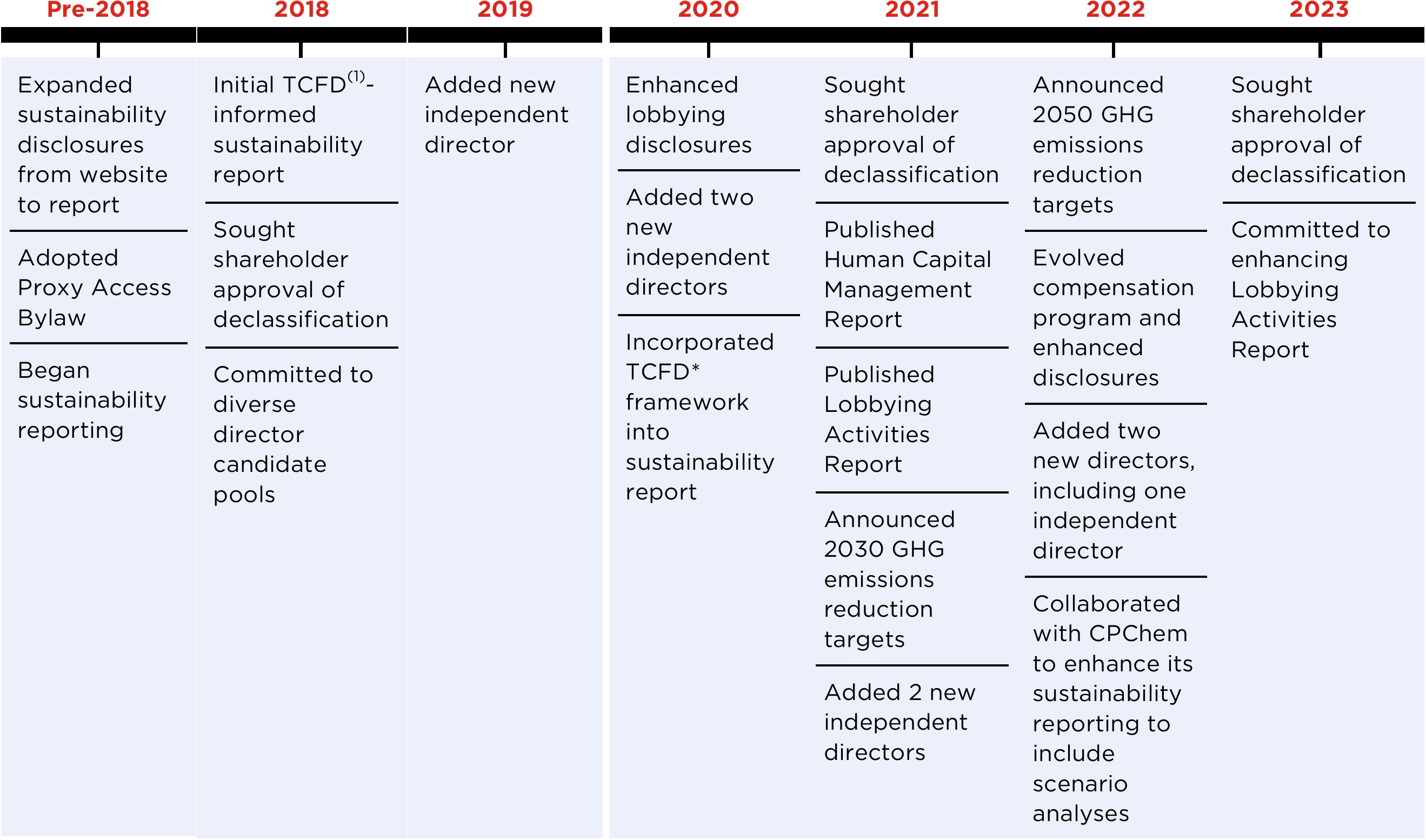
| 30 | Phillips 66 2023 Proxy Statement | ||||
•Exercises its oversight responsibility for risk assessment and risk management directly and through its committees. •Receives regular updates from its committees on individual areas of risk that fall within each committee’s area of oversight and expertise. | ||
Audit and Finance Committee | Human Resources and Compensation Committee | Nominating and Governance Committee | Public Policy and Sustainability Committee | ||||||||
Financial and accounting risks Overall ERM program and the guidelines and policies that govern the process by which ERM is handled Information technology security (including cybersecurity) and technology risk management programs | Risks associated with compensation policies and practices for executive compensation and company-wide compensation practices generally Corporate culture and human capital risks, including management succession planning | Risks associated with corporate governance policies and practices and compliance with guidelines Board composition and Board succession matters CEO succession planning | Social and political risks and trends, including lobbying activities and political spending Operational health, safety and environmental risks Corporate social responsibility and sustainability programs | ||||||||
| Corporate Governance | 31 | ||||
| 32 | Phillips 66 2023 Proxy Statement | ||||
 | The Board of Directors met seven times in 2022. All of our directors attended more than 75% of the meetings of the Board and committees on which they served. Recognizing that director attendance at the Company’s annual meeting can provide the Company’s shareholders with an opportunity to communicate with the directors about issues affecting the Company, the Company actively encourages directors to attend the annual meetings of shareholders. All of our directors then serving attended our 2022 Annual Meeting. | ||||
| Corporate Governance | 33 | ||||
| Director Compensation | |||||
| Compensation for non-employee directors is reviewed annually by the Nominating and Governance Committee and set by action of the Board. The Nominating and Governance Committee may from time to time receive the assistance of a third-party consultant in reviewing director compensation, as it deems advisable. | ||
| NON-EMPLOYEE DIRECTOR COMPENSATION | ADDITIONAL ANNUAL CASH COMPENSATION | |||||||
 |  | 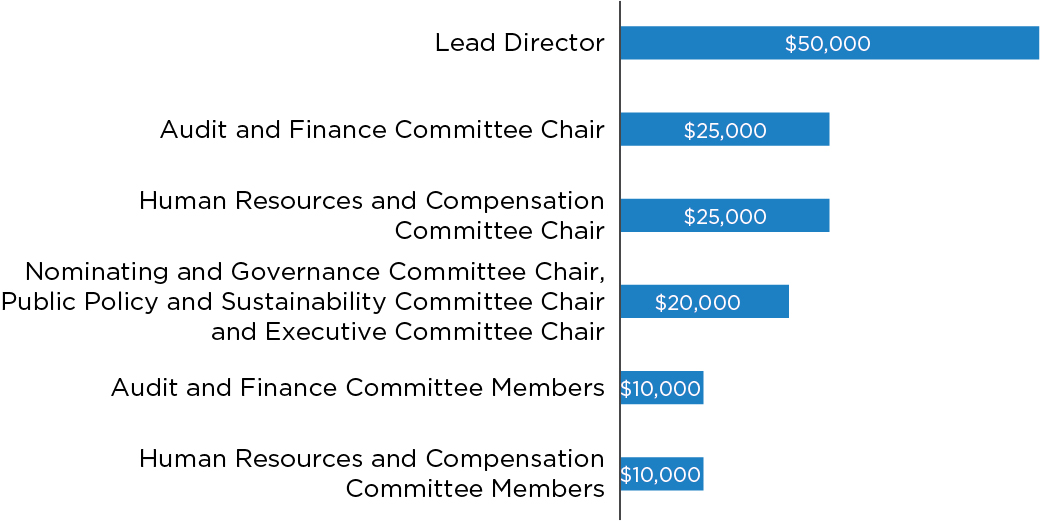 | ||||||
| 34 | Phillips 66 2023 Proxy Statement | ||||
| All directors are in compliance, or are on track to comply, with the stock ownership guidelines. | ||
| Director Compensation | 35 | ||||
| Name | Fees Earned or Paid in Cash(1) ($) | Stock Awards(2) ($) | All Other Compensation(3) ($) | Total ($) | ||||||||||
| Gary K. Adams | 135,000 | 200,010 | 49,954 | 384,964 | ||||||||||
| Julie L. Bushman | 135,000 | 200,010 | — | 335,010 | ||||||||||
| Lisa A. Davis | 135,000 | 200,010 | 16,172 | 351,182 | ||||||||||
| Gregory J. Hayes | 63,508 | 94,091 | — | 157,599 | ||||||||||
| Charles M. Holley | 135,000 | 200,010 | — | 335,010 | ||||||||||
| John E. Lowe | 150,000 | 200,010 | 78 | 350,088 | ||||||||||
| Denise L. Ramos | 155,000 | 200,010 | — | 355,010 | ||||||||||
| Denise R. Singleton | 135,000 | 200,010 | 39,089 | 374,099 | ||||||||||
| Douglas T. Terreson | 135,000 | 200,010 | 16,999 | 352,009 | ||||||||||
| Glenn F. Tilton | 205,000 | 200,010 | 15,250 | 420,260 | ||||||||||
| Marna C. Whittington | 150,000 | 200,010 | 24,220 | 374,230 | ||||||||||
| 36 | Phillips 66 2023 Proxy Statement | ||||
PROPOSAL 2  | Management Proposal to Approve the Declassification of the Board The Board recommends that you vote “FOR” the proposal to declassify the Board of Directors. | ||||
| 37 | |||||
PROPOSAL 3  | Advisory Approval of Executive Compensation The Board recommends that you vote “FOR” the advisory approval of the compensation of the Company’s named executive officers. | ||||
| 38 | Phillips 66 2023 Proxy Statement | ||||
CompensationDiscussionandAnalysis | |||||
| Our Named Executive Officers (“NEOs”) for 2022 were: | |||||||||||||||||||||||
| Table of Contents | |||||||||||||||||||||||
 | Mark Lashier President and Chief Executive Officer | 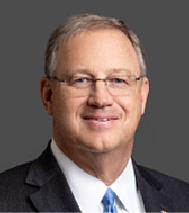 | Greg Garland Executive Chairman and former Chief Executive Officer | ||||||||||||||||||||
| 39 | |||||||||||||||||||||||
| 43 | |||||||||||||||||||||||
| 47 |  | Kevin Mitchell Executive Vice President and Chief Financial Officer |  | Vanessa Allen Sutherland Executive Vice President, Government Affairs, General Counsel & Corporate Secretary | |||||||||||||||||||
| Participants in Compensation Setting | 58 | ||||||||||||||||||||||
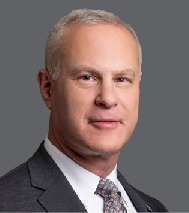 | Brian Mandell Executive Vice President, Marketing & Commercial | 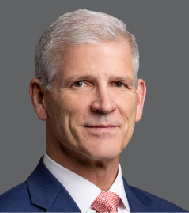 | Tim Roberts Executive Vice President, Midstream & Chemicals | ||||||||||||||||||||
| Additional Compensation Practices | 61 | ||||||||||||||||||||||
 | EXECUTIVE SUMMARY | ||||
| Our Approach to Executive Compensation | ||
 | “Our executive compensation programs, which are linked to our strategy, align pay and performance, and help us attract and retain executives. The thoughtful approach we bring to our compensation program was crucial as we implemented our succession planning and leadership transition efforts, in an effort to ensure we have the right leaders in place and that they are properly incentivized to pursue our strategic goals.” – Marna Whittington, Chair, Human Resources and Compensation Committee | ||||
| 39 | ||
| Recent Leadership Transitions | ||
 | Greg Garland Chairman & CEO, March 2012 – June 2022 Executive Chairman, July 2022 |  | Mark Lashier President & COO, April 2021 – June 2022 President & CEO, July 2022 | |||||||||||
| Qualifications include: industry leadership in safety, reliability and environmental stewardship and pioneering disciplined capital allocation in the energy business | Qualifications include: more than 30 years of experience in the energy and petrochemicals industry, track record of managerial success and demonstrated ability to lead | |||||||||||||
| 40 | Phillips 66 2023 Proxy Statement | ||||
| Shareholder Engagement on 2022 Say-on-Pay Vote Outcome | |||||
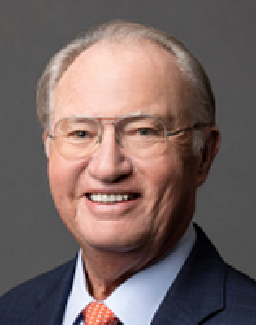 | “2022 was an important year for the Compensation Committee in terms of demonstrating our responsiveness to shareholder feedback regarding our recent executive compensation program changes. I greatly valued opportunities I had to hear directly from our shareholders, and shareholder insights from our engagement program are brought back to the full Board. We are proud to share that the feedback we received in recent months has been overwhelmingly positive.” – Glenn Tilton, Lead Independent Director & Member, Human Resources and Compensation Committee | ||||
| 2022 Shareholder Engagement by the Numbers | ||||||||
57% of shares outstanding contacted | 47% of shares outstanding engaged | 26% of shares outstanding engaged with Lead Independent Director | ||||||
| Compensation Discussion and Analysis | 41 | ||||
| Taking Action in Response to Investor Feedback | ||
| What We Heard | Actions Taken in Response | Year of Implementation | |||||||||||||||
 | Individual VCIP Modifier | •Individual VCIP modifier allows for too much discretion | •Removed positive individual performance modifier from VCIP for all executive officers | 2021 | |||||||||||||
Disclosure of Rigorous Performance Goals & Metric Selection | •Explain how performance goals are set each year to ensure goals remain rigorous even if targets decrease on absolute terms •Provide more explanation around the weighting and selection of VCIP metrics and rationale for payouts | •Enhanced disclosures on goal setting, particularly where targets decrease on a year-over-year basis •Enhanced disclosures of the weighting and selection of VCIP metrics and the rationale for payouts | 2021 | ||||||||||||||
| 2021 | |||||||||||||||||
 | Consider Absolute TSR | •Relative TSR drives 50% of the PSP, but there is no cap on payouts in the event of negative absolute TSR performance | •Capped payout at 100% on the TSR portion of PSP if absolute TSR is negative | 2021 | |||||||||||||
| Rigor of Relative TSR Goal | •Relative TSR pays at target for median performance | •Required performance above the 50th percentile relative to peer group to achieve target payout | PSP 2022 - 2024 | ||||||||||||||
Adjustments to Metrics | •Limited disclosure of rationale for significant ROCE adjustment in FY 2020 | •Enhanced disclosures of rationale for any adjustments to results | 2021 | ||||||||||||||
 | Selection & Rationale | •Provide more explanation for the use of two peer groups and how the peers are determined | •Enhanced disclosure about the peer group utilization and peer selection | 2021 | |||||||||||||
| 42 | Phillips 66 2023 Proxy Statement | ||||
 | EXECUTIVE COMPENSATION PROGRAM SUMMARY | ||||
| Compensation Program Mix | ||
| Key Elements of Pay | ||||||||||||||||||||||||||
| CEO | Other NEOs(1) | Delivered via | Performance Drivers and Weightings | |||||||||||||||||||||||
| Base Salary | Cash | •Annual fixed cash compensation to attract and retain NEOs | ||||||||||||||||||||||||
 |  | |||||||||||||||||||||||||
 |  | Annual Incentive | Variable Cash Incentive Program (VCIP) | 50% Operational Sustainability | ||||||||||||||||||||||
 |  | •Safety & Operating Excellence (25%) •Environment (15%) •High-Performing Organization (10%) | ||||||||||||||||||||||||
| 50% Financial Sustainability | ||||||||||||||||||||||||||
•Adjusted VCIP EBITDA (40%) •Adjusted Controllable Costs (10%) | ||||||||||||||||||||||||||
| Long-Term Incentives | Performance Share Program (PSP) 50% of LTI Target 3-year performance period | •Adjusted PSP ROCE (50%) •Relative TSR (50%) | ||||||||||||||||||||||||
 |  | |||||||||||||||||||||||||
Stock Option Program(2) 25% of LTI Target 3-year ratable vesting period | •Long-term stock price appreciation | |||||||||||||||||||||||||
Restricted Stock Unit (RSU) Program 25% of LTI Target 3-year cliff vesting | •Long-term stock price appreciation | |||||||||||||||||||||||||
| Compensation Discussion and Analysis | 43 | ||||
| 2022 Operating, Financial and Company Highlights that Impacted Pay Outcomes | ||
| COMBINED TOTAL RECORDABLE RATE (TRR) | TIER 1 AND 2 PROCESS SAFETY EVENT RATE | |||||||
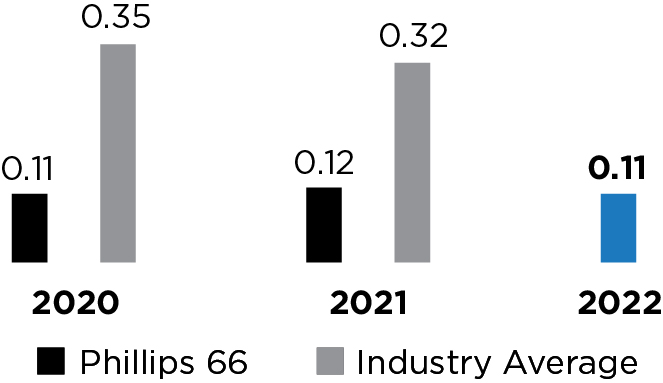 | 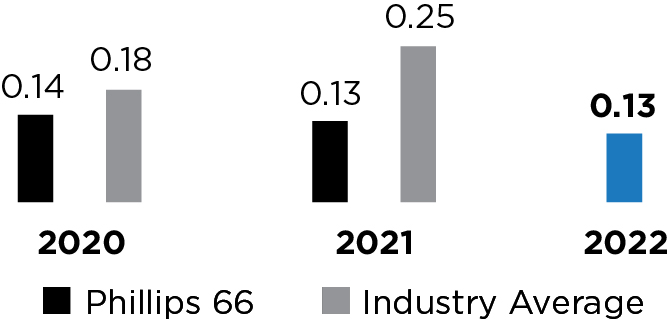 | |||||||
| NET INCOME (LOSS) | ADJUSTED VCIP EBITDA(1) | ADJUSTED PSP ROCE(1) | ||||||||||||
| ($MM) | ($MM) | (%) | ||||||||||||
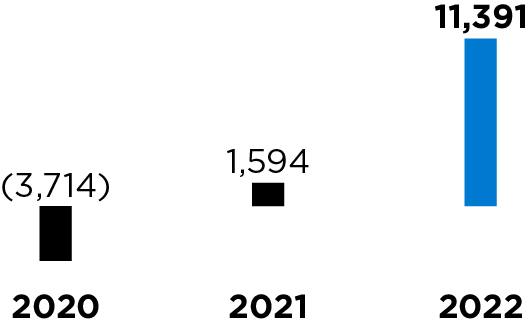 | 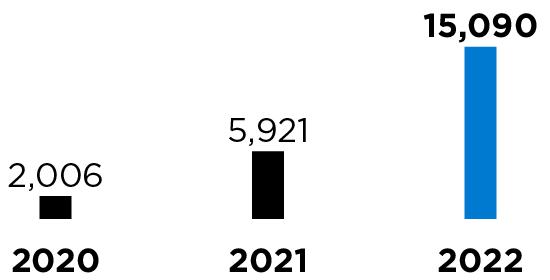 | 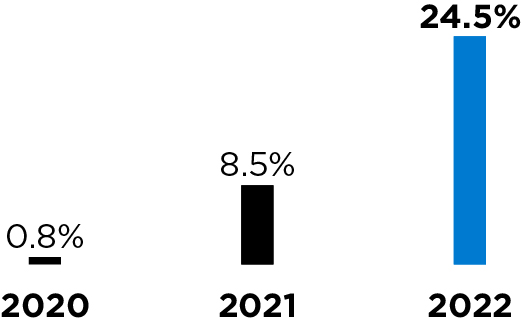 | ||||||||||||
TOTAL SHAREHOLDER RETURN(2) | |||||
 | |||||
| 44 | Phillips 66 2023 Proxy Statement | ||||
 | |||||
Achieve Operating Excellence Prioritizing safety, environmental stewardship, sustainability, reliability and cost efficiency while protecting shareholder value •Tied best-ever Tier 1 and 2 process safety event rate •Expanded Greenhouse Gas emissions reduction targets to include a 2050 emissions intensity reduction target for Scope 1 and Scope 2 emissions •Recognized by American Fuel and Petrochemical Manufacturers for exemplary safety performance •Awarded American Petroleum Institute’s large operator Distinguished Pipeline Safety Award for the second consecutive year | |||||
 | |||||
Drive Disciplined Growth Enhancing our portfolio by growing our integrated Midstream and Chemicals businesses, as well as executing our returns-focused lower-carbon strategy •Completed the acquisition of Phillips 66 Partners, LP •Increased ownership and integration of DCP Midstream to enhance our wellhead-to-market strategy •Reached a final investment decision to convert our San Francisco Refinery into one of the world’s largest renewable fuels facilities •Reached a final investment decision at CPChem, our 50-50 joint venture, in early 2023 for the construction of two world-scale petrochemical facilities that are expected to be self-funded | |||||
 | |||||
Deliver Shareholder Returns Rewarding shareholders through continued dividend growth and share repurchases •Increased the dividend by 5% in May 2022 and returned $1.8 billion in dividends to shareholders in 2022 •Resumed share repurchases in the second quarter and repurchased $1.5 billion of shares in 2022 •Authorized a $5 billion increase to the share repurchase authorization in November 2022 •Announced a target to return $10 billion to $12 billion to shareholders through dividends and share repurchases between July 2022 and year-end 2024 | |||||
 | |||||
Maintain Financial Strength & Flexibility Maintaining financial strength and disciplined capital allocation strategy to enhance resiliency •Generated $10.8 billion of operating cash flow •Ended the year with a cash balance of $6.1 billion •Paid down $2.4 billion of debt and ended the year with a net-debt-to-capital ratio of 24% •Implemented Business Transformation initiative to sustainably lower our cost structure, and captured a run-rate savings in excess of $500 million by year-end | |||||
 | |||||
Cultivate a High-Performing Organization Building capability, pursuing excellence, and doing the right thing •Responded to employee feedback by enhancing workplace benefits •Contributed $27 million to support the communities where we operate and donated over $7 million through matching gifts and volunteer grant programs •Logged 88,000 employee volunteer hours •Received six external top employer recognition awards as a great place to work | |||||
| Compensation Discussion and Analysis | 45 | ||||
| 2022 Performance-Based Compensation Outcomes | ||
| 2020 - 2022 PSP Metrics and Weightings | Performance Result | Weight | Payout | ||||||||
Adjusted Return on Capital Employed (50% Weighting)(1) Adjusted PSP ROCE performance above maximum | Above Maximum | 50% | 200% | ||||||||
Total Shareholder Return (50% Weighting) Relative TSR performance below threshold | Below Threshold | 50% | 0% | ||||||||
| Total 2020 - 2022 PSP Payout | 100% | ||||||||||
| Payout | ||||||||||||||
| 2022 VCIP Metrics and Weightings | Threshold | Target 100% Payout | Maximum 200% Payout | |||||||||||
Operational Sustainability Metrics (50% Weighting) Safety & Operating Excellence (25%) Environment (15%) High-Performing Organization (10%) |  | |||||||||||||
Financial Sustainability Metrics (50% Weighting) Adjusted Controllable Costs (10%)(1) Adjusted VCIP EBITDA (40%)(1) | ||||||||||||||
| 46 | Phillips 66 2023 Proxy Statement | ||||
 | EXECUTIVE COMPENSATION PROGRAM DETAILS | ||||
 | “Our compensation program is an outgrowth of our Company’s business strategy, values and culture. As we cultivate a high-performing organization, we are working to meet the world’s growing energy needs and ensure that all of our team members can reach their full potential. These are the building blocks for financial results that translate into shareholder returns.” – Sonya Reed, SVP, Chief Human Resources Officer | ||||
EMPHASIZING THE IMPORTANCE OF RETURNS – EMBEDDING WACC IN OUR TARGET SETTING PROCESS We use Weighted Average Cost of Capital (WACC) as part of our target-setting for the VCIP to set the non-GAAP Adjusted VCIP EBITDA targets and in our PSP to set the non-GAAP Adjusted PSP ROCE targets. WACC represents our blended cost of capital across our businesses. Results above our WACC reflect the ability of our executives to effectively manage capital and capture market opportunities, which results in value creation for our shareholders. Our executives must deliver results that are at least 1.5 percentage points above our WACC to receive a target payout for either the non-GAAP Adjusted VCIP EBITDA metric or the non-GAAP Adjusted PSP ROCE metric. | ||
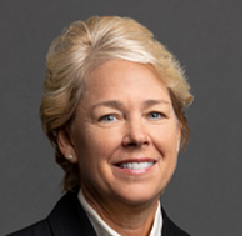 | “Our anchoring of metrics used in our compensation program around the company’s WACC reflects the Compensation Committee’s commitment to upholding shareholder value creation principles. This metric provides a point of reference to incentivize our executives throughout changing macroeconomic environments and strategic business needs.” – Lisa Davis, Member, Human Resources and Compensation Committee | ||||
| Compensation Discussion and Analysis | 47 | ||||
| Elements of Executive Compensation | ||
CEO  | Other NEOs  | Base salary is designed to provide a competitive and fixed rate of pay recognizing employees’ different levels of responsibility and performance. As the majority of our NEO compensation is performance based and tied to long-term programs, base salary represents a less significant component of total compensation. | ||||||
| Name | Salary as of 1/1/2022 ($) | Salary as of 12/31/2022 ($) | ||||||
| Mark Lashier | 1,100,000 | 1,500,000 | ||||||
| Greg Garland | 1,675,008 | 1,000,000 | ||||||
| Kevin Mitchell | 903,432 | 961,704 | ||||||
| Vanessa Allen Sutherland | — | 750,000 | ||||||
| Brian Mandell | 750,000 | 820,050 | ||||||
| Tim Roberts | 887,424 | 940,226 | ||||||
| 48 | Phillips 66 2023 Proxy Statement | ||||
| Long-Term Incentives - 2022 Program Design | ||
CEO  | Other NEOs  | |||||||
 | Restricted Stock Units (RSUs) The number of RSUs granted is determined based on the fair market value of Company stock on the date of grant. RSUs awarded to our NEOs in February 2022 cliff vest after three years. RSUs do not carry voting rights but do earn dividend equivalents during the vesting period. RSUs are typically granted in February each year. The Compensation Committee assesses the individual performance of each NEO and based on that assessment, may adjust an award by up to +/–30% of the target amount at grant. | ||||||||||
 | Stock Options These awards are inherently performance based, as the stock price must increase before the executive can realize any value. We believe stock options drive behaviors and actions that enhance long-term shareholder value. Stock options are typically granted in February each year. The number of stock options awarded is calculated based on the Black-Scholes-Merton model. The exercise price of stock options is set at 100% of the fair market value of our common stock on the date of grant. Stock options granted to our NEOs in February 2022 vest ratably over a three-year period and have a ten-year term. Stock options do not have voting rights and are not entitled to receive dividends. | ||||||||||
 | Performance Share Program (PSP) Each PSP has a three-year performance period, and therefore three overlapping PSPs are in progress at any given time. Programs in effect during 2022 were PSP 2020-2022, PSP 2021-2023, and PSP 2022-2024. The target number of shares is determined by dividing the target value by the average of the stock’s fair market value for the 20 trading days prior to the start of the performance period, less anticipated dividends during the performance period. The Compensation Committee assesses the individual performance of each NEO and based on that assessment, may adjust an award by up to +/–30% of the target amount at grant. Performance adjustments to the number of target shares are applied at the beginning of the performance period, rather than the end, so that performance-adjusted compensation is subject to Company performance and market volatility throughout the performance period, aligning executive compensation with shareholder interests. •Target shares may be adjusted during the performance period for promotions that occur during the performance period. •Executives hired after the start of the performance period may receive prorated target shares in ongoing PSP cycles, at the discretion of the Compensation Committee, so that their interests are immediately aligned with the Company’s long-term goals and shareholder interests. •Awards under the PSP programs are denominated in shares but are paid in cash using the average stock fair market value for the last 20 trading days of the performance period. | ||||||||||
| Compensation Discussion and Analysis | 49 | ||||
| Performance Share Program - Metrics and Targets | ||
CEO  | Other NEOs  | The performance metrics used for the 2020-2022 PSP are non-GAAP absolute adjusted return on capital employed (Adjusted PSP ROCE) and relative total shareholder return (TSR) based on a 20-trading day average closing price. | ||||||
 | Relative TSR The Compensation Committee recognizes that relative TSR is the most common performance metric for comparisons to peers. Our performance is assessed as compared to our Performance Peer Group and the S&P 100 Index. Starting with the 2019-2021 PSP program, we added a cap on the portion of the PSP earned based on relative TSR if absolute TSR is negative. Additionally, starting with the 2022-2024 PSP program, the portion of the PSP earned based on relative TSR requires performance above the 50th percentile relative to the peer group to achieve a target payout (this is not reflected in the target listed below, which reflects the 2020-2022 PSP). We made these changes in response to shareholder input and in order to better align pay with corporate performance and shareholder experience. | |||||||||||||
| Threshold | Above 10th percentile of Performance Peers | |||||||||||||
| Target | 50th percentile of Performance Peers | |||||||||||||
| Maximum | Above 90th percentile of Performance Peers | |||||||||||||
 | Adjusted PSP ROCE (non-GAAP) The Compensation Committee considers Adjusted PSP ROCE an important measure of Company growth, shareholder value creation and overall performance. | |||||||||||||
| Threshold | 3.4% Delivers sustaining capital and dividend payments over 3-year performance period | |||||||||||||
| Target | 8.3% Delivers WACC +1.5% over 3-year performance period | |||||||||||||
| Maximum | 9.8% Delivers WACC +3.0% over 3-year performance period | |||||||||||||
| Aligned with other peers’ practices, we have historically adjusted ROCE for “special items” that are not representative of our underlying operating performance. The Compensation Committee carefully evaluates all such adjustments to understand the impacts the adjustment would have on compensation outcomes and how the item factored into the Company’s operating and financial outcomes. | ||||||||||||||
| 50 | Phillips 66 2023 Proxy Statement | ||||
| Performance Share Program – 2020 - 2022 Payout | ||
| 2020 - 2022 PSP Metrics and Weightings | Performance Result | Weight | Payout | ||||||||
Adjusted Return on Capital Employed (50% Weighting)(1) Adjusted PSP ROCE performance above maximum | Above Maximum | 50% | 200% | ||||||||
Total Shareholder Return (50% Weighting) Relative TSR performance below threshold | Below Threshold | 50% | 0% | ||||||||
| Total 2020 - 2022 PSP Payout | 100% | ||||||||||
| Adjusted PSP ROCE Performance | |||||||||||||||||
| Metric | Threshold (3.4%) | Target (8.3%) | Maximum (9.8%) | ||||||||||||||
| Adjusted PSP ROCE |  | ||||||||||||||||
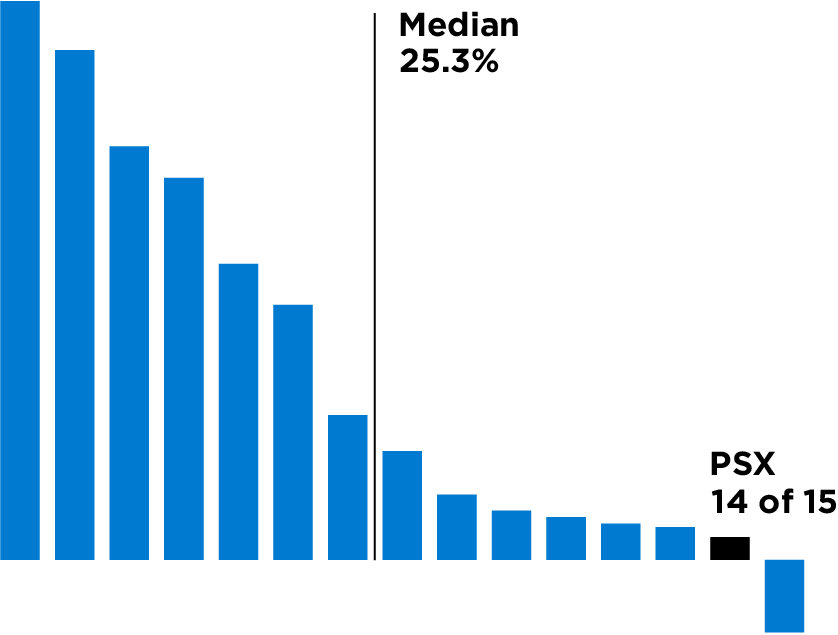
| Compensation Discussion and Analysis | 51 | ||||
PSP Developments in 2022:  Based on shareholder input and in order to create more challenging goals, starting with 2022-2024 PSP, we require relative TSR performance above the 50th percentile relative to the peer group to achieve a target payout Based on shareholder input and in order to create more challenging goals, starting with 2022-2024 PSP, we require relative TSR performance above the 50th percentile relative to the peer group to achieve a target payout For non-GAAP Adjusted PSP ROCE, the threshold achievement level is set at the historical average Adjusted PSP ROCE of 3.5% to cover sustaining capital and dividends For non-GAAP Adjusted PSP ROCE, the threshold achievement level is set at the historical average Adjusted PSP ROCE of 3.5% to cover sustaining capital and dividends Target and maximum achievement levels for non-GAAP Adjusted PSP ROCE is set at 1.5 and 3.0 percentage points above historical average WACC of 7% Target and maximum achievement levels for non-GAAP Adjusted PSP ROCE is set at 1.5 and 3.0 percentage points above historical average WACC of 7% The historical average WACC is reviewed on an annual basis by senior management to determine if it needs to be adjusted for current market conditions The historical average WACC is reviewed on an annual basis by senior management to determine if it needs to be adjusted for current market conditions | ||
New PSP Developments in 2023:  We narrowed the potential adjustment for target PSP award grants based on individual performance from +/-50% to +/-30%, which aligns with our RSU and Stock Option awards We narrowed the potential adjustment for target PSP award grants based on individual performance from +/-50% to +/-30%, which aligns with our RSU and Stock Option awards | ||
| Long-Term Incentives | ||
| Name | 2022-2024 PSP ($) | Stock Options ($) | RSUs ($) | Total Target(1) ($) | ||||||||||
| Mark Lashier | 4,869,167 | 1,975,000 | 2,126,250 | 8,970,417 | ||||||||||
| Greg Garland | 5,000,000 | 2,500,000 | 2,500,000 | 10,000,000 | ||||||||||
| Kevin Mitchell | 2,493,472 | 1,038,947 | 1,246,736 | 4,779,155 | ||||||||||
Vanessa Allen Sutherland(2) | 1,200,000 | 600,000 | 600,000 | 2,400,000 | ||||||||||
| Brian Mandell | 1,620,000 | 675,000 | 810,000 | 3,105,000 | ||||||||||
| Tim Roberts | 1,916,836 | 798,682 | 958,418 | 3,673,936 | ||||||||||
| 52 | Phillips 66 2023 Proxy Statement | ||||
| Variable Cash Incentive Program (VCIP) – Program Design | ||
| % OF TARGET COMPENSATION | ||||||||
CEO  | Other NEOs  | The VCIP, which is our annual incentive program, is designed to provide payout variability and differentiation based on corporate performance. Through our operational and financial metrics, we designed our VCIP program to align annual awards with shareholder interests and execution of our corporate strategy. The metrics are weighted to balance operational sustainability considerations and financial sustainability considerations, which we believe is appropriate in light of the annual nature of the VCIP and relatively smaller value of the VCIP versus the LTI program. We do not link executive officer VCIP awards to the performance of any individual business unit. We believe this structure serves the best interests of shareholders as it promotes collaboration across the organization. | ||||||
$ Eligible Earnings | × | % Target Percentage | × | % Payout Percentage | = | $ Total VCIP Payout | ||||||||||||||
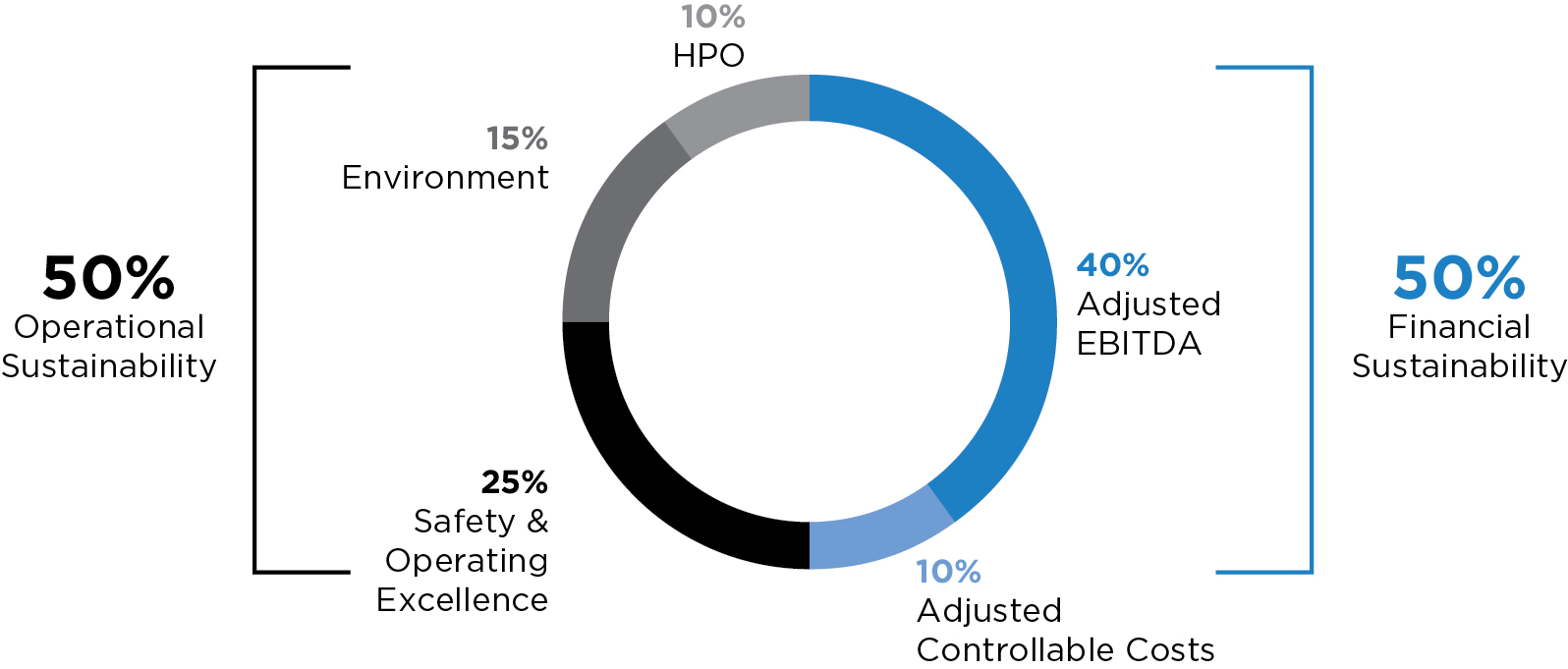
| Compensation Discussion and Analysis | 53 | ||||
| Variable Cash Incentive Program (VCIP) – Metrics and Targets | ||
Operational Sustainability 50%:Half of our VCIP is based on Operational performance because strong safety, reliability and operating excellence are fundamental to our business success. It also enables the Company to maximize market opportunities, generate higher returns and create shareholder value. | ||
 | High-Performing Organization Maintaining and enhancing a high-performing organization is critical to our success and is part of our human capital management strategy. Our employees promote our culture and are integral to achieving our strategic goals and maximizing long-term shareholder value. We measure our High-Performing Organization performance relative to the following: •Culture: foster behaviors that promote our unique culture •Capability: build depth and breadth in our skills •Performance: deliver exceptional, sustainable results | |||||||||||||
 | Environment For environmental performance, we set targets based on our historical performance for Agency Reportable Environmental Events and Spill Volumes normalized for throughput. Targets are expected to become more challenging each year to drive continuous performance improvement. Starting in 2021, we enhanced the environmental component to include two new metrics: Lower-Carbon Priorities and Greenhouse Gas Priorities. These priorities reflected efforts to advance lower-carbon investments, optimization, and innovation as well as efforts to reduce manufacturing emissions intensity and setting GHG emissions intensity reduction targets. For 2022, these metrics were combined into one metric – Lower-Carbon / GHG Priorities – weighted at 10% of the target VCIP opportunity. | |||||||||||||
 | Safety & Operating Excellence For personal and process safety performance, we measure ourselves against the top performing companies in our industry. Generally, these companies fall within the top two quartiles of all companies reported. We then establish our threshold, target, and maximum goals based on the performance (25th, 50th, and 75th percentiles) of this group of companies. For asset availability, for which comparative data is not available, we establish our threshold, target, and maximum goals based on our operating plan and historical performance with the goal of continuous improvement, incorporating the segments of our business and weighting them by adjusted EBITDA. | |||||||||||||
| 54 | Phillips 66 2023 Proxy Statement | ||||
Financial Sustainability 50%: The other half of our VCIP is based on Financial performance to ensure our executives effectively manage costs and deliver financial results above our WACC. | ||
 | Adjusted Controllable Costs (non-GAAP) For Adjusted Controllable Costs, we measure our effectiveness in managing costs and set our threshold, target, and maximum based on our annual budget. | |||||||||||||
| Threshold | $5.093 billion | |||||||||||||
| Target | $4.851 billion | |||||||||||||
| Maximum | $4.608 billion | |||||||||||||
| The 2022 Adjusted Controllable Costs target excludes turnarounds and utilities expenses, and includes $200 million in cost reductions as part of our Business Transformation. | ||||||||||||||
 | Adjusted VCIP EBITDA (non-GAAP) Adjusted VCIP EBITDA measures our ability to create shareholder value. Our threshold is the Adjusted VCIP EBITDA required to cover our budgeted sustaining capital and annualized common stock dividend payment, and target and maximum are set at Adjusted VCIP EBITDA levels that equate to ROCE levels 1.5 and 3.0 percentage points above our WACC. | |||||||||||||
| Threshold | $4.094 billion | |||||||||||||
| Target | Adjusted VCIP EBITDA equivalent to ROCE of WACC + 1.5 percentage points ($6.333 billion) | |||||||||||||
| Maximum | Adjusted VCIP EBITDA equivalent to ROCE of WACC + 3.0 percentage points ($7.044 billion) | |||||||||||||
| The 2022 Adjusted VCIP EBITDA target increased from $5.4 billion in 2021 to approximately $6.3 billion in 2022 as a result of the Company's WACC increasing to 7.0%. | ||||||||||||||
| Variable Cash Incentive Program (VCIP) – 2022 Payout | ||
| Weight | Threshold | Target | Maximum | 2022 Actual | Payout | |||||||||||||||||||||||||||||||||
 | Safety & Operating Excellence | |||||||||||||||||||||||||||||||||||||
| Total Recordable Rate (TRR) | 7.5 | % | 0.32 | 0.21 | 0.16 | 0.11 | 190 | % | ||||||||||||||||||||||||||||||
| Process Safety Event Rate – Tier 1 & 2 | 7.5 | % | 0.24 | 0.15 | 0.14 | 0.13 | 200 | % | ||||||||||||||||||||||||||||||
| Asset Availability | 10 | % | 93.2 | % | 94.7 | % | 96.2 | % | 97.4 | % | 200 | % | ||||||||||||||||||||||||||
| Environment | ||||||||||||||||||||||||||||||||||||||
| Lower-Carbon / GHG Priorities | 10 | % | - | - | - | - | 100 | % | ||||||||||||||||||||||||||||||
| Environmental Performance | 5 | % | 0.088 | 0.077 | 0.065 | 0.071 | 150 | % | ||||||||||||||||||||||||||||||
| High-Performing Organization | 10 | % | - | - | - | - | 120 | % | ||||||||||||||||||||||||||||||
 | Adjusted Controllable Costs ($MM)(1) | 10 | % | $5,093 | $4,851 | $4,608 | $4,993 | 71 | % | |||||||||||||||||||||||||||||
Adjusted VCIP EBITDA ($MM)(1) | 40 | % | $4,094 | $6,333 | $7,044 | $15,090 | 200 | % | ||||||||||||||||||||||||||||||
| TOTAL | 166 | % | ||||||||||||||||||||||||||||||||||||
| Compensation Discussion and Analysis | 55 | ||||
| Payout | |||||||||||
| Metric and Weighting | Threshold | Target | Maximum | ||||||||
| Safety & Operating Excellence (25%) |  | ||||||||||
| Payout | |||||||||||
| Metric and Weighting | Threshold | Target | Maximum | ||||||||
| Environment (15%) |  | ||||||||||
| Payout | |||||||||||
| Metric and Weighting | Threshold | Target | Maximum | ||||||||
| High-Performing Organization (10%) |  | ||||||||||
| 56 | Phillips 66 2023 Proxy Statement | ||||
| Payout | |||||||||||
| Metric and Weighting | Threshold | Target 100% Payout | Maximum | ||||||||
| Adjusted Controllable Costs (10%) |  | ||||||||||
| Payout | |||||||||||
| Metric and Weighting | Threshold | Target 100% Payout | Maximum | ||||||||
| Adjusted VCIP EBITDA (40%) |  | ||||||||||
VCIP Developments for 2021: Removed the individual performance modifier for all NEOs. New VCIP Developments for 2022: Continued to weight the target VCIP toward 50% operational and 50% financial sustainability metrics, but changes to the individual metric weightings were made to reinforce our commitment to best-in-class safety performance and progress of lower-carbon initiatives: •Safety & Operating Excellence: Total Recordable Rate and Process Safety Event Rate were weighted equally at 7.5% and Process Safety Event Rate included both Tier 1 and Tier 2 safety events. •Environmental: GHG Priorities and Lower-Carbon Priorities were combined into a single metric weighted at 10%. Environment Performance continues at a 5% weighting. We redesigned this metric in 2022 to include Agency Reportable Events and Spills normalized for throughput. | ||
| Name | 2022 Eligible Earnings ($) | Target VCIP Percentage (%) | VCIP Payout Percentage (%) | Total Payout ($) | ||||||||||
Mark Lashier(1) | 1,314,667 | 130 | % | 166 | % | 2,837,051 | ||||||||
| Greg Garland | 1,337,504 | 160 | % | 166 | % | 3,552,411 | ||||||||
| Kevin Mitchell | 951,992 | 100 | % | 166 | % | 1,580,306 | ||||||||
| Vanessa Allen Sutherland | 718,750 | 85 | % | 166 | % | 1,014,156 | ||||||||
| Brian Mandell | 808,375 | 90 | % | 166 | % | 1,207,712 | ||||||||
| Tim Roberts | 931,426 | 90 | % | 166 | % | 1,391,550 | ||||||||
| Compensation Discussion and Analysis | 57 | ||||
 | PARTICIPANTS IN COMPENSATION-SETTING | ||||
| Role of the Compensation Committee | ||
| Authority and Responsibility of the Compensation Committee | •Provides independent, objective oversight of our executive compensation programs and determines the compensation for our senior officers. •Acts as plan administrator of the compensation programs and benefit plans for our senior officers and as an avenue of appeal for current and former executive officers regarding disputes over compensation and benefits. •Oversees the Company’s executive compensation philosophy, policies, plans and programs for our executive officers. •Assists the Board in its oversight of the integrity of the Company’s Compensation Discussion and Analysis. | ||||
| Compensation Determination Process | ||
 | ||||||||||||||
FEBRUARY •Approve VCIP and PSP payouts at the end of the performance period •Approve VCIP and PSP performance goals for the performance period •Review individual executive officer performance and compensation levels | JULY •Review of compensation peer group proxies (disclosing previous compensation program) •Review compensation and performance peer groups •Receive a VCIP and PSP Performance Update | |||||||||||||
 | Compensation Committee Oversight |  | ||||||||||||
DECEMBER •Approve VCIP and LTI program design, award terms and conditions, and metrics and weightings for the following year •Review of VCIP and PSP performance goals for the following year •Approve executive salary structure (including LTI targets) for following year •Receive a VCIP and PSP Performance Update | OCTOBER •Approve compensation and performance peer groups •Review of VCIP program design/terms & conditions, and metrics and weightings •Review of RSU and Stock Options program design/terms & conditions •Review of PSP program design/terms & conditions, and metrics and weightings •Receive a VCIP and PSP Performance Update | |||||||||||||
 | ||||||||||||||
| 58 | Phillips 66 2023 Proxy Statement | ||||
| Role of the Independent Compensation Consultant | ||
| Independent Compensation Consultant | Advises the Compensation Committee on: •Compensation program design and processes relative to external corporate governance standards. •Appropriateness of our executive compensation program in comparison to those of our peers. •Effectiveness of the compensation program in accomplishing the objectives set by the Compensation Committee. | ||||
| Role of our Peer Companies | ||
| Compensation Discussion and Analysis | 59 | ||||
| 2022 COMPENSATION PEER GROUP | 2020 - 2022 PERFORMANCE PEER GROUP | ||||||||||
| Used to evaluate and determine compensation levels for our NEOs, including base salary levels and targets for our annual bonus and LTI programs | Used to evaluate our relative TSR performance for our 2020 – 2022 Performance Share Program | ||||||||||
Companies •Archer-Daniels-Midland Company •Chevron Corporation •ConocoPhillips •Dow Inc. •Ford Motor Company •General Motors Company •Halliburton Company •Honeywell International Inc. •LyondellBasell Industries N.V. •Marathon Petroleum Corporation •Occidental Petroleum Corporation •Schlumberger Limited •The Williams Companies, Inc. •Valero Energy Corporation | Companies Refining and Marketing •Delek US Holdings, Inc. •HF Sinclair Corporation(1) •Marathon Petroleum Corporation •PBF Energy Inc. •Valero Energy Corporation Midstream •Magellan Midstream Partners, L.P. •MPLX LP •ONEOK, Inc. •Targa Resources Corp. •The Williams Companies, Inc. Chemicals •Dow Inc. •LyondellBasell Industries N.V. •Westlake Corporation | ||||||||||
Criteria for Selection Our compensation peer group includes companies that are comparable to Phillips 66 based on three primary criteria — assets, market capitalization, and business operations. Revenue is an additional, secondary criterion. The compensation peer group primarily consists of large companies with which we compete for talent. While some of our compensation peers fall outside our industry, the Compensation Committee believes their size, significant capital investments, and similarly complex international operations make them appropriate peers against which to benchmark our compensation levels and practices. At the time the compensation peer group was determined, Phillips 66 was at the 41st percentile in assets, 43rd percentile in market value, and 66th percentile in revenue. | Criteria for Selection To reflect our unique portfolio of assets, we include companies operating in each of our three major segments – Refining and Marketing, Midstream and Chemicals. The performance peer group is used in the PSP program to assess relative TSR performance. We believe that our performance peer group is representative of the companies that investors use for relative performance comparisons. In addition to our performance peer group, we include the S&P 100 Index in the assessment of our relative TSR performance. The Compensation Committee believes the S&P 100 is an appropriate comparison as the index reflects companies with which we compete for capital in the broader market. | ||||||||||
Changes from 2021 to 2022 Compensation Peer Group To better position our peer group to accurately reflect businesses of our size, Exxon Mobil Corporation was removed from the compensation peer group. | Changes from 2019-2021 to 2020-2022 Performance Peer Group In order to better reflect our operating segments, Magellan Midstream Partners, L.P., MPLX LP, The Williams Companies, Inc., and Dow Inc. were added to the performance peer group and Celanese Corporation, Eastman Chemical Company, Huntsman Corporation, and Enterprise Products Partners L.P. were removed. | ||||||||||
| 60 | Phillips 66 2023 Proxy Statement | ||||
 | ADDITIONAL COMPENSATION PRACTICES | ||||
| Other Benefits and Perquisites | ||
| Compensation Discussion and Analysis | 61 | ||||
| Executive Compensation Governance | ||
| Executive | Required Salary Multiple | ||||
| Mark Lashier | 6x | ||||
| Greg Garland | 6x | ||||
| Kevin Mitchell | 4x | ||||
| Vanessa Allen Sutherland | 3x | ||||
| Brian Mandell | 4x | ||||
| Tim Roberts | 4x | ||||
| 62 | Phillips 66 2023 Proxy Statement | ||||
SUSTAINABILITY AND TRANSITION TO LOWER-CARBON FUTURE
We recognizeprograms include, but are not limited to:
| Compensation Discussion and Analysis | 63 | ||||
 We Do… We Do… |  We Do Not… We Do Not… | ||||
 Target the majority of NEO compensation to be performance based and at risk Target the majority of NEO compensation to be performance based and at risk Apply multiple performance metrics aligned with our corporate strategy Apply multiple performance metrics aligned with our corporate strategy Cap maximum payouts for VCIP and PSP Cap maximum payouts for VCIP and PSP Cap payout at 100% on the TSR portion of the PSP if absolute TSR is negative Cap payout at 100% on the TSR portion of the PSP if absolute TSR is negative Require TSR performance above the 50th percentile relative to peer group to achieve target payout Require TSR performance above the 50th percentile relative to peer group to achieve target payout Employ a “double trigger” for change in control severance benefits and equity award acceleration Employ a “double trigger” for change in control severance benefits and equity award acceleration Include absolute and relative metrics in our LTI programs Include absolute and relative metrics in our LTI programs Maintain robust stock ownership guidelines for executives — CEO and Executive Chairman 6x base salary; other NEOs 3-4x base salary Maintain robust stock ownership guidelines for executives — CEO and Executive Chairman 6x base salary; other NEOs 3-4x base salary Balance, monitor and manage compensation risk through regular assessments and robust clawback provisions Balance, monitor and manage compensation risk through regular assessments and robust clawback provisions Have extended vesting periods on stock awards, with a minimum one-year vesting period required for stock and stock option awards Have extended vesting periods on stock awards, with a minimum one-year vesting period required for stock and stock option awards Maintain a fully independent compensation committee Maintain a fully independent compensation committee Retain an independent compensation consultant Retain an independent compensation consultant Hold an annual Say-on-Pay vote and consider shareholder feedback in the design of our compensation program Hold an annual Say-on-Pay vote and consider shareholder feedback in the design of our compensation program |  Provide excise tax gross-ups to our NEOs under our CICSP Provide excise tax gross-ups to our NEOs under our CICSP Reprice stock options without shareholder approval Reprice stock options without shareholder approval Price stock option exercise prices below grant date fair market value Price stock option exercise prices below grant date fair market value Allow share recycling for stock options under our equity plan Allow share recycling for stock options under our equity plan Include evergreen provisions in our active equity plans Include evergreen provisions in our active equity plans Allow hedging or pledging of Company stock Allow hedging or pledging of Company stock Pay dividends during the performance period on unearned PSPs Pay dividends during the performance period on unearned PSPs Allow transfer of equity awards (except in the case of death) Allow transfer of equity awards (except in the case of death) Provide separate supplemental executive retirement benefits for individual NEOs Provide separate supplemental executive retirement benefits for individual NEOs Maintain individual change-in-control agreements Maintain individual change-in-control agreements Have an employment agreement with the CEO Have an employment agreement with the CEO Provide excessive perquisites Provide excessive perquisites | ||||
| 64 | Phillips 66 2023 Proxy Statement | ||||
| Human Resources and Compensation Committee Report | ||
| Compensation Discussion and Analysis | 65 | ||||
| Executive Compensation Tables | |||||
Name, Position, Year | Salary(1) ($) | Stock Awards(2) ($) | Option Awards(3) ($) | Non-Equity Incentive Plan Compensation(4) ($) | Change in Pension Value and Nonqualified Deferred Compensation Earnings(5) ($) | All Other Compensation(6) ($) | Total ($) | Total Without Change in Pension Value(7) ($) | ||||||||||||||||||
Mark Lashier(8) | ||||||||||||||||||||||||||
| President and Chief Executive Officer | ||||||||||||||||||||||||||
| 2022 | 1,314,667 | 9,260,117 | 1,976,406 | 2,837,051 | 231,983 | 668,646 | 16,288,870 | 16,056,887 | ||||||||||||||||||
| 2021 | 825,000 | 6,830,884 | 1,513,217 | 1,406,625 | 71,546 | 230,816 | 10,878,088 | 10,806,542 | ||||||||||||||||||
| Greg Garland | ||||||||||||||||||||||||||
| Executive Chairman and former Chief Executive Officer | ||||||||||||||||||||||||||
| 2022 | 1,337,504 | 9,825,510 | 2,500,700 | 3,552,411 | — | 1,013,792 | 18,229,917 | 18,229,917 | ||||||||||||||||||
| 2021 | 1,675,008 | 11,318,245 | 3,140,920 | 4,154,020 | — | 665,013 | 20,953,206 | 20,953,206 | ||||||||||||||||||
| 2020 | 1,675,008 | 9,237,623 | 3,351,180 | 3,082,015 | 6,851,884 | 791,664 | 24,989,374 | 18,137,490 | ||||||||||||||||||
| Kevin Mitchell | ||||||||||||||||||||||||||
| Executive Vice President and Chief Financial Officer | ||||||||||||||||||||||||||
| 2022 | 951,992 | 4,899,887 | 1,040,400 | 1,580,306 | 144,483 | 328,542 | 8,945,610 | 8,801,127 | ||||||||||||||||||
| 2021 | 903,432 | 4,493,056 | 1,039,424 | 1,400,320 | 164,332 | 216,301 | 8,216,865 | 8,052,533 | ||||||||||||||||||
| 2020 | 897,360 | 3,024,331 | 998,560 | 1,256,304 | 258,546 | 245,367 | 6,680,468 | 6,421,922 | ||||||||||||||||||
Vanessa Allen Sutherland(8) | ||||||||||||||||||||||||||
| Executive Vice President, Government Affairs, General Counsel & Corporate Secretary | ||||||||||||||||||||||||||
| 2022 | 718,750 | 5,358,106 | 600,100 | 1,014,156 | — | 109,181 | 7,800,293 | 7,800,293 | ||||||||||||||||||
Brian Mandell(8) | ||||||||||||||||||||||||||
| Executive Vice President, Marketing & Commercial | ||||||||||||||||||||||||||
| 2022 | 808,375 | 3,183,449 | 676,600 | 1,207,712 | — | 266,584 | 6,142,720 | 6,142,720 | ||||||||||||||||||
| Tim Roberts | ||||||||||||||||||||||||||
| Executive Vice President, Midstream & Chemicals | ||||||||||||||||||||||||||
| 2022 | 931,426 | 3,766,815 | 799,000 | 1,391,550 | 191,842 | 289,679 | 7,370,312 | 7,178,470 | ||||||||||||||||||
| 2021 | 887,424 | 3,453,979 | 799,832 | 1,237,956 | 342,146 | 182,659 | 6,903,996 | 6,561,850 | ||||||||||||||||||
| 2020 | 881,188 | 2,531,427 | 766,300 | 1,110,297 | 297,744 | 204,254 | 5,791,210 | 5,493,466 | ||||||||||||||||||
| 66 | Phillips 66 2023 Proxy Statement | ||||
| Name | Company Contributions to Nonqualified Defined Contribution Plans(a) ($) | Executive Group Life Insurance Premiums(b) ($) | Executive Health Physical(c) ($) | Financial Counseling(d) ($) | Matching Contributions under the Tax-Qualified Savings Plan(e) ($) | Matching Gift Program(f) ($) | Miscellaneous Perquisites and Tax Protection(g) ($) | Personal Use of Company Aircraft(h) ($) | ||||||||||||||||||
| M. Lashier | 298,155 | 10,412 | 2,183 | 16,280 | 24,400 | — | 50,866 | 266,350 | ||||||||||||||||||
| G. Garland | 641,333 | 20,384 | 1,860 | 16,270 | 24,400 | 15,000 | 41,851 | 252,694 | ||||||||||||||||||
| K. Mitchell | 257,295 | 4,912 | 1,860 | 16,270 | 24,400 | 15,000 | 8,805 | — | ||||||||||||||||||
| V. A. Sutherland | 54,350 | 1,898 | — | 12,258 | 24,400 | 15,000 | 1,275 | — | ||||||||||||||||||
| B. Mandell | 197,455 | 4,171 | 1,860 | 16,270 | 24,400 | 7,500 | 14,928 | — | ||||||||||||||||||
| T. Roberts | 235,398 | 7,377 | 1,860 | — | 24,400 | 15,000 | 5,644 | — | ||||||||||||||||||
| Executive Compensation Tables | 67 | ||||
| 68 | Phillips 66 2023 Proxy Statement | ||||
Estimated Future Payouts under Non-Equity Incentive Plan Awards(2) | Estimated Future Payouts under Equity Incentive Plan Awards(3) | All other Stock Awards: Number of Shares of Stock or Units(4) (#) | All other Option Awards: Number of Securities Underlying Options (#) | Exercise or Base Price of Option Awards ($/SH) | Grant Date Fair Value of Stock and Option Awards(5) ($) | |||||||||||||||||||||||||||||||||
| Name | Grant Date(1) | Threshold ($) | Target ($) | Maximum ($) | Threshold (#) | Target ($) | Maximum ($) | |||||||||||||||||||||||||||||||
| Mark Lashier | — | 1,709,067 | 3,418,134 | — | — | — | — | — | — | — | ||||||||||||||||||||||||||||
| 2/8/2022 | — | — | — | — | — | — | 18,683 | — | — | 1,663,721 | ||||||||||||||||||||||||||||
| 7/1/2022 | — | — | — | — | — | — | 5,594 | — | — | 462,512 | ||||||||||||||||||||||||||||
| 2/8/2022 | — | — | — | — | 80,111 | 160,222 | — | — | — | 7,133,884 | ||||||||||||||||||||||||||||
| 2/8/2022 | — | — | — | — | — | — | — | 89,000 | 89.05 | 1,513,000 | ||||||||||||||||||||||||||||
| 7/1/2022 | — | — | — | — | — | — | — | 26,300 | 82.68 | 463,406 | ||||||||||||||||||||||||||||
| Greg Garland | — | 2,140,006 | 4,280,012 | — | — | — | — | — | — | — | ||||||||||||||||||||||||||||
| 2/8/2022 | — | — | — | — | — | — | 28,074 | — | — | 2,499,990 | ||||||||||||||||||||||||||||
| 2/8/2022 | — | — | — | — | 82,263 | 164,526 | — | — | — | 7,325,520 | ||||||||||||||||||||||||||||
| 2/8/2022 | — | — | — | — | — | — | — | 147,100 | 89.05 | 2,500,700 | ||||||||||||||||||||||||||||
| Kevin Mitchell | — | 951,992 | 1,903,984 | — | — | — | — | — | — | — | ||||||||||||||||||||||||||||
| 2/8/2022 | — | — | — | — | — | — | 14,000 | — | — | 1,246,700 | ||||||||||||||||||||||||||||
| 2/8/2022 | — | — | — | — | 41,024 | 82,048 | — | — | — | 3,653,187 | ||||||||||||||||||||||||||||
| 2/8/2022 | — | — | — | — | — | — | — | 61,200 | 89.05 | 1,040,400 | ||||||||||||||||||||||||||||
| Vanessa Allen Sutherland | — | 610,938 | 1,221,876 | — | — | — | — | — | — | — | ||||||||||||||||||||||||||||
| 1/17/2022 | — | — | — | — | — | — | 34,258 | — | — | 2,999,973 | ||||||||||||||||||||||||||||
| 2/8/2022 | — | — | — | — | — | — | 6,738 | — | — | 600,019 | ||||||||||||||||||||||||||||
| 2/8/2022 | — | — | — | — | 19,743 | 39,486 | — | — | — | 1,758,114 | ||||||||||||||||||||||||||||
| 2/8/2022 | — | — | — | — | — | — | — | 35,300 | 89.05 | 600,100 | ||||||||||||||||||||||||||||
| Brian Mandell | — | 727,538 | 1,455,076 | — | — | — | — | — | — | — | ||||||||||||||||||||||||||||
| 2/8/2022 | — | — | — | — | — | — | 9,096 | — | — | 809,999 | ||||||||||||||||||||||||||||
| 2/8/2022 | — | — | — | — | 26,653 | 53,306 | — | — | — | 2,373,450 | ||||||||||||||||||||||||||||
| 2/8/2022 | — | — | — | — | — | — | — | 39,800 | 89.05 | 676,600 | ||||||||||||||||||||||||||||
| Tim Roberts | — | 838,283 | 1,676,566 | — | — | — | — | — | — | — | ||||||||||||||||||||||||||||
| 2/8/2022 | — | — | — | — | — | — | 10,763 | — | — | 958,445 | ||||||||||||||||||||||||||||
| 2/8/2022 | — | — | — | — | 31,537 | 63,074 | — | — | — | 2,808,370 | ||||||||||||||||||||||||||||
| 2/8/2022 | — | — | — | — | — | — | — | 47,000 | 89.05 | 799,000 | ||||||||||||||||||||||||||||
| Executive Compensation Tables | 69 | ||||
Option Awards(1) | Stock Awards | |||||||||||||||||||||||||||||||
| Name | Grant Date | Number of Securities Underlying Unexercised Options Exercisable(2) (#) | Number of Securities Underlying Unexercised Options Unexercisable (#) | Option Exercise Price ($) | Option Expiration Date | Number of Shares or Units of Stock that Have not Vested(3) (#) | Market Value of Shares or Units of Stock that Have not Vested ($) | Equity Incentive Plan Awards: Number of Unearned Shares, Units or Other Rights that Have not Vested(4) (#) | Equity Incentive Plan Awards: Market or Payout Value of Unearned Shares, Units or Other Rights that Have not Vested ($) | |||||||||||||||||||||||
| Mark Lashier | 4/1/2021 | 36,366 | 72,734 | 81.910 | 4/1/2031 | — | — | — | — | |||||||||||||||||||||||
| 2/8/2022 | — | 89,000 | 89.050 | 2/8/2032 | — | — | — | — | ||||||||||||||||||||||||
| 7/1/2022 | — | 26,300 | 82.680 | 7/1/2032 | — | — | — | — | ||||||||||||||||||||||||
| — | — | — | — | 47,592 | 4,953,375 | 297,908 | 31,006,265 | |||||||||||||||||||||||||
| Greg Garland | 2/2/2016 | 169,400 | — | 78.62 | 2/2/2026 | — | — | — | — | |||||||||||||||||||||||
| 2/7/2017 | 174,000 | — | 78.475 | 2/7/2027 | — | — | — | — | ||||||||||||||||||||||||
| 2/6/2018 | 147,000 | — | 94.850 | 2/6/2028 | — | — | — | — | ||||||||||||||||||||||||
| 2/5/2019 | 178,700 | — | 94.968 | 2/5/2029 | — | — | — | — | ||||||||||||||||||||||||
| 2/4/2020 | 141,400 | 70,700 | 89.570 | 2/4/2030 | — | — | — | — | ||||||||||||||||||||||||
| 2/9/2021 | 87,833 | 175,667 | 74.700 | 2/9/2031 | — | — | — | — | ||||||||||||||||||||||||
| 2/8/2022 | — | 147,100 | 89.050 | 2/8/2032 | — | — | — | — | ||||||||||||||||||||||||
| — | — | — | — | 103,505 | 10,772,801 | 383,472 | 39,911,767 | |||||||||||||||||||||||||
| Kevin Mitchell | 2/3/2015 | 9,900 | — | 74.135 | 2/3/2025 | — | — | — | — | |||||||||||||||||||||||
| 2/2/2016 | 30,800 | — | 78.620 | 2/2/2026 | — | — | — | — | ||||||||||||||||||||||||
| 2/7/2017 | 31,700 | — | 78.475 | 2/7/2027 | — | — | — | — | ||||||||||||||||||||||||
| 2/6/2018 | 43,600 | — | 94.850 | 2/6/2028 | — | — | — | — | ||||||||||||||||||||||||
| 2/5/2019 | 53,300 | — | 94.968 | 2/5/2029 | — | — | — | — | ||||||||||||||||||||||||
| 2/4/2020 | 42,133 | 21,067 | 89.570 | 2/4/2030 | — | — | — | — | ||||||||||||||||||||||||
| 2/9/2021 | 29,066 | 58,134 | 74.700 | 2/9/2031 | — | — | — | — | ||||||||||||||||||||||||
| 2/8/2022 | — | 61,200 | 89.050 | 2/8/2032 | — | — | — | — | ||||||||||||||||||||||||
| — | — | — | — | 41,665 | 4,336,493 | 168,964 | 17,585,773 | |||||||||||||||||||||||||
| Vanessa Allen Sutherland | 2/8/2022 | — | 35,300 | 89.050 | 2/8/2032 | — | — | — | — | |||||||||||||||||||||||
| — | — | — | — | 40,996 | 4,266,864 | 66,210 | 6,891,137 | |||||||||||||||||||||||||
| Brian Mandell | 2/3/2015 | 3,000 | — | 74.135 | 2/3/2025 | — | — | — | — | |||||||||||||||||||||||
| 2/2/2016 | 9,800 | — | 78.620 | 2/2/2026 | — | — | — | — | ||||||||||||||||||||||||
| 2/7/2017 | 14,100 | — | 78.475 | 2/7/2027 | — | — | — | — | ||||||||||||||||||||||||
| 2/6/2018 | 12,100 | — | 94.850 | 2/6/2028 | — | — | — | — | ||||||||||||||||||||||||
| 2/5/2019 | 25,500 | — | 94.968 | 2/5/2029 | — | — | — | — | ||||||||||||||||||||||||
| 2/4/2020 | 28,533 | 14,267 | 89.570 | 2/4/2030 | — | — | — | — | ||||||||||||||||||||||||
| 2/9/2021 | 18,900 | 37,800 | 74.700 | 2/9/2031 | — | — | — | — | ||||||||||||||||||||||||
| 2/8/2022 | — | 39,800 | 89.050 | 2/8/2032 | — | — | — | — | ||||||||||||||||||||||||
| — | — | — | — | 26,305 | 2,737,824 | 105,068 | 10,935,478 | |||||||||||||||||||||||||
| Tim Roberts | 2/6/2018 | 25,900 | — | 94.850 | 2/6/2028 | — | — | — | — | |||||||||||||||||||||||
| 2/5/2019 | 31,500 | — | 94.968 | 2/5/2029 | — | — | — | — | ||||||||||||||||||||||||
| 2/4/2020 | 32,333 | 16,167 | 89.570 | 2/4/2030 | — | — | — | — | ||||||||||||||||||||||||
| 2/9/2021 | 22,366 | 44,734 | 74.700 | 2/9/2031 | ||||||||||||||||||||||||||||
| 2/8/2022 | — | 47,000 | 89.050 | 2/8/2032 | — | — | — | — | ||||||||||||||||||||||||
| — | — | — | — | 32,578 | 3,390,718 | 129,890 | 13,518,951 | |||||||||||||||||||||||||
| 70 | Phillips 66 2023 Proxy Statement | ||||
| Executive Compensation Tables | 71 | ||||
| Option Awards | Stock Awards(1) | ||||||||||||||||
| Name | Number of Shares Acquired on Exercise (#) | Value Realized Upon Exercise ($) | Number of Shares Acquired on Vesting (#) | Value Realized Upon Vesting ($) | |||||||||||||
| Mark Lashier | — | — | 27,139 | 2,671,478 | |||||||||||||
| Greg Garland | 273,000 | 7,265,523 | 98,617 | 9,660,109 | |||||||||||||
| Kevin Mitchell | — | — | 32,480 | 3,178,973 | |||||||||||||
| Vanessa Allen Sutherland | — | — | — | — | |||||||||||||
| Brian Mandell | — | — | 20,358 | 2,007,564 | |||||||||||||
| Tim Roberts | 59,100 | 1,662,629 | 24,827 | 2,451,756 | |||||||||||||
| 72 | Phillips 66 2023 Proxy Statement | ||||
| Title I | Title II(1) | Title IV | |||||||||
| Current Eligibility | Mr. Garland | Mr. Lashier, Mr. Mitchell, Ms. Sutherland, Mr. Roberts | Mr. Mandell | ||||||||
| Normal Retirement | Age 65 | Age 65 | Age 65 | ||||||||
Early Retirement(2) | Age 55 with five years of service or if laid off during or after the year in which the participant reaches age 50 | Executives may receive their vested benefit upon termination of employment at any age | Age 50 with ten years of service | ||||||||
Benefit Calculation(2) | Calculated as the product of 1.6% times years of credited service multiplied by the final average eligible earnings | Based on monthly pay and interest credits to a nominal cash balance account created on the first day of the month after an executive’s hire date. Pay credits are equal to a percentage of total salary and annual bonus. | Calculated as the product of 1.6% times years of credited service multiplied by the final average eligible earnings | ||||||||
| Final Average Earnings Calculation | Calculated using the three highest compensation years in the last ten calendar years before retirement plus the year of retirement | N/A | Calculated using the higher of the highest three years of compensation or the highest 36 months of compensation | ||||||||
Eligible Pension Compensation(3) | Includes salary and annual bonus | Includes salary and annual bonus | Includes salary and annual bonus | ||||||||
| Benefit Vesting | All participants are vested in this title | Employees vest after three years of service | All participants are vested in this title | ||||||||
| Payment Types | Allows payments in the form of several annuity types or a single lump sum | ||||||||||
| IRS limitations | Benefits under all Titles are limited by the IRC. In 2022, the compensation limit was $305,000. The IRC also limits the annual benefit available under these Titles expressed as an annuity. In 2022, that limit was $245,000 (reduced actuarially for ages below 62). | ||||||||||
| Executive Compensation Tables | 73 | ||||
| Name | Plan Name | Number of Years Credited Service(1) (#) | Present Value of Accumulated Benefit ($) | Payments During Last Fiscal Year ($) | ||||||||||
| Mark Lashier | Retirement Plan - Title II | 33 | 51,371 | — | ||||||||||
KESRP(2) | 252,157 | — | ||||||||||||
| Greg Garland | Retirement Plan - Title I | 33 | 1,716,484 | — | ||||||||||
KESRP(2) | 40,272,369 | — | ||||||||||||
| Kevin Mitchell | Retirement Plan - Title II | 9 | 204,082 | — | ||||||||||
KESRP(2) | 1,047,610 | — | ||||||||||||
| Vanessa Allen Sutherland | Retirement Plan - Title II | — | — | — | ||||||||||
KESRP(2) | — | — | ||||||||||||
| Brian Mandell | Retirement Plan - Title IV | 32 | 1,714,995 | — | ||||||||||
KESRP(2) | 9,226,348 | — | ||||||||||||
| Tim Roberts | Retirement Plan - Title II | 30 | 182,876 | — | ||||||||||
KESRP(2) | 900,730 | — | ||||||||||||
| Understanding the Annual Change in Pension Value | |||||
| No modifications to pension | •There were no modifications to our existing pension program in 2022 | ||||
| Change in value | •The value of traditional pension plans is particularly sensitive to interest rate movement, which is outside of the Company's control •While our short-term and long-term incentive programs are based entirely on performance, pension value is not performance based and does not reflect or reward Company performance | ||||
| Pension plan going forward | •The Compensation Committee will continue to assess our pension program to ensure viability as an attraction and retention tool | ||||
| 74 | Phillips 66 2023 Proxy Statement | ||||
| Name | Applicable Plan(1) | Beginning Balance ($) | Executive Contributions in Last Fiscal Year ($) | Company Contributions in the Last Fiscal Year(2) ($) | Aggregate Earnings (Loss) in Last Fiscal Year(3) ($) | Aggregate Withdrawals/ Distributions ($) | Aggregate Balance at Last Fiscal Year End(4) ($) | ||||||||||||||||
| Mark Lashier | DCMP | 43,606 | — | 298,155 | (13,998) | — | 327,763 | ||||||||||||||||
| KEDCP | — | — | — | — | — | — | |||||||||||||||||
| Greg Garland | DCMP | 3,610,490 | — | 641,333 | (188,039) | — | 4,063,784 | ||||||||||||||||
| KEDCP | 1,360,786 | — | — | 560,857 | — | 1,921,643 | |||||||||||||||||
| Kevin Mitchell | DCMP | 1,036,805 | — | 257,295 | (153,219) | — | 1,140,881 | ||||||||||||||||
| KEDCP | — | — | — | — | — | — | |||||||||||||||||
| Vanessa Allen Sutherland | DCMP | — | — | 54,350 | 1,355 | — | 55,705 | ||||||||||||||||
| KEDCP | — | — | — | — | — | — | |||||||||||||||||
| Brian Mandell | DCMP | 863,962 | — | 197,455 | (166,545) | — | 894,871 | ||||||||||||||||
| KEDCP | 4,689,190 | — | (1,101,515) | — | 3,587,675 | ||||||||||||||||||
| Tim Roberts | DCMP | 739,012 | — | 235,398 | (149,420) | — | 824,990 | ||||||||||||||||
| KEDCP | 1,377,453 | 1,188,085 | — | (416,517) | — | 2,149,020 | |||||||||||||||||
| |||||
| Executive Compensation Tables | 75 | ||||
| |||||
| 76 | Phillips 66 2023 Proxy Statement | ||||
PROPOSAL 3: RATIFICATION OF THE APPOINTMENT OF ERNST & YOUNG
| Executive Compensation Tables | 77 | ||||
| Executive Benefits and Payments Upon Termination | ||||||||||||||
| Involuntary Not-For- Cause Termination (Not CIC) ($) | Involuntary or Good Reason Termination (CIC) ($) | Death ($) | Disability ($) | |||||||||||
| Mark Lashier | ||||||||||||||
| Severance Payment | 8,404,649 | 12,606,974 | — | — | ||||||||||
| Accelerated Equity | — | — | 5,213,304 | 5,213,304 | ||||||||||
| Life Insurance | — | — | 3,000,000 | — | ||||||||||
| TOTAL | 8,404,649 | 12,606,974 | 8,213,304 | 5,213,304 | ||||||||||
| Greg Garland | ||||||||||||||
| Severance Payment | 7,850,876 | 17,830,366 | — | — | ||||||||||
| Accelerated Equity | — | — | 5,707,955 | 5,707,955 | ||||||||||
| Life Insurance | — | — | 2,000,000 | — | ||||||||||
| TOTAL | 7,850,876 | 17,830,366 | 7,707,956 | 5,707,955 | ||||||||||
| Kevin Mitchell | ||||||||||||||
| Severance Payment | 4,225,966 | 7,438,774 | — | — | ||||||||||
| Accelerated Equity | — | — | 2,372,092 | 2,372,092 | ||||||||||
| Life Insurance | — | — | 1,923,407 | — | ||||||||||
| TOTAL | 4,225,966 | 7,438,774 | 4,295,499 | 2,372,092 | ||||||||||
| Vanessa Allen Sutherland | ||||||||||||||
| Severance Payment | 2,806,248 | 4,209,371 | — | — | ||||||||||
| Accelerated Equity | 4,302,762 | 4,797,423 | 6,762,079 | 6,762,079 | ||||||||||
| Life Insurance | — | — | 1,500,000 | — | ||||||||||
| TOTAL | 7,109,010 | 9,006,794 | 8,262,079 | 6,762,079 | ||||||||||
| Brian Mandell | ||||||||||||||
| Severance Payment | 4,444,343 | 7,022,671 | — | — | ||||||||||
| Accelerated Equity | — | — | 1,541,125 | 1,541,125 | ||||||||||
| Life Insurance | — | — | 1,640,100 | — | ||||||||||
| TOTAL | 4,444,343 | 7,022,671 | 3,181,225 | 1,541,125 | ||||||||||
| Tim Roberts | ||||||||||||||
| Severance Payment | 3,927,165 | 6,874,518 | — | — | ||||||||||
| Accelerated Equity | — | — | 1,823,541 | 1,823,541 | ||||||||||
| Life Insurance | — | — | 1,880,452 | — | ||||||||||
| TOTAL | 3,927,165 | 6,874,518 | 3,703,993 | 1,823,541 | ||||||||||
| 78 | Phillips 66 2023 Proxy Statement | ||||
| CEO Pay Ratio | |||||
| 79 | |||||
| Pay versus Performance | |||||
| Year | Summary Compensation Table Total for First PEO1 ($) | Summary Compensation Table Total for Second PEO1 ($) | Compensation Actually Paid to First PEO2 $) | Compensation Actually Paid to Second PEO2 ($) | Average Summary Compensation Table Total for Non-PEO NEOs3 ($) | Average Compensation Actually Paid to Non-PEO NEOs2,3 ($) | Value of Initial Fixed $100 Investment Based On: | GAAP Net Income ($ MM) | Annual Adjusted PSP ROCE5 (%) | |||||||||||||||||||||||
Total Shareholder Return4 ($) | Peer Group Total Shareholder Return4 ($) | |||||||||||||||||||||||||||||||
| (a) | (b) | (b) | (c) | (c) | (d) | (e) | (f) | (g) | (h) | (i) | ||||||||||||||||||||||
| 2022 | 18,229,917 | 16,288,870 | 36,488,607 | 24,349,594 | 7,564,734 | 12,019,418 | 108.84 | 140.02 | 11,391 | 24.5 | ||||||||||||||||||||||
| 2021 | 20,953,206 | — | 21,535,633 | — | 8,163,303 | 7,817,258 | 72.45 | 106.53 | 1,594 | 8.5 | ||||||||||||||||||||||
| 2020 | 24,989,374 | — | 2,700,837 | — | 6,290,976 | 2,618,978 | 66.45 | 78.79 | (3,714) | 0.8 | ||||||||||||||||||||||
| Compensation Actually Paid to PEO | 2022 (Mr. Garland) | 2022 (Mr. Lashier) | 2021 (Mr. Garland) | 2020 (Mr. Garland) | ||||||||||
| Summary Compensation Table Total | 18,229,917 | 16,288,870 | 20,953,206 | 24,989,374 | ||||||||||
Less, value of “Stock Awards” and “Option Awards” reported in Summary Compensation Table | (12,326,210) | (11,236,523) | (14,459,165) | (12,588,803) | ||||||||||
Less, Change in Pension Value reported in Summary Compensation Table | — | (231,983) | — | (6,851,884) | ||||||||||
Plus, year-end fair value of outstanding and unvested equity awards granted in the year | 15,794,483 | 14,260,576 | 14,662,552 | 9,514,060 | ||||||||||
Plus, fair value as of vesting date of equity awards granted and vested in the year(a) | 89,225 | 59,342 | 114,921 | 85,470 | ||||||||||
Plus (less), year over year change in fair value of outstanding and unvested equity awards granted in prior years | 9,650,492 | 4,073,013 | 470,710 | (6,371,181) | ||||||||||
| Plus (less), year over year change in fair value of equity awards granted in prior years that vested in the year | 3,803,161 | 910,182 | (1,835,338) | (7,136,027) | ||||||||||
| Plus, the value of dividends or other earnings paid on equity awards in the year | 398,405 | 178,639 | 394,928 | 357,826 | ||||||||||
| Plus, pension service cost for services rendered during the year | 849,133 | 47,478 | 1,233,818 | 702,002 | ||||||||||
| Compensation Actually Paid to PEO | 36,488,607 | 24,349,594 | 21,535,633 | 2,700,837 | ||||||||||
| 80 | Phillips 66 2023 Proxy Statement | ||||
| Average Compensation Actually Paid to Non-PEO NEOs | 2022 | 2021 | 2020 | ||||||||
| Summary Compensation Table Total | 7,564,734 | 8,163,303 | 6,290,976 | ||||||||
| Less, value of “Stock Awards” and “Option Awards” reported in Summary Compensation Table | (5,081,089) | (5,575,650) | (3,332,826) | ||||||||
| Less, Change in Pension Value reported in Summary Compensation Table | (84,081) | (196,955) | (765,023) | ||||||||
| Plus, year-end fair value of outstanding and unvested equity awards granted in the year | 6,388,526 | 5,407,971 | 2,531,727 | ||||||||
Plus, fair value as of vesting date of equity awards granted and vested in the year(a) | 26,925 | 38,733 | 16,332 | ||||||||
| Plus (less), year over year change in fair value of outstanding and unvested equity awards granted in prior years | 2,188,370 | 102,802 | (1,578,875) | ||||||||
| Plus (less), year over year change in fair value of equity awards granted in prior years that vested in the year | 735,558 | (359,892) | (821,489) | ||||||||
| Plus, the value of dividends or other earnings paid on equity awards in the year | 135,895 | 150,681 | 133,668 | ||||||||
| Plus, pension service cost for services rendered during the year | 144,581 | 86,265 | 144,488 | ||||||||
| Compensation Actually Paid to Non-PEO NEOs | 12,019,418 | 7,817,258 | 2,618,978 | ||||||||
| RELATIONSHIP BETWEEN COMPENSATION ACTUALLY PAID AND PERFORMANCE | ||
| Pay versus Performance | 81 | ||||

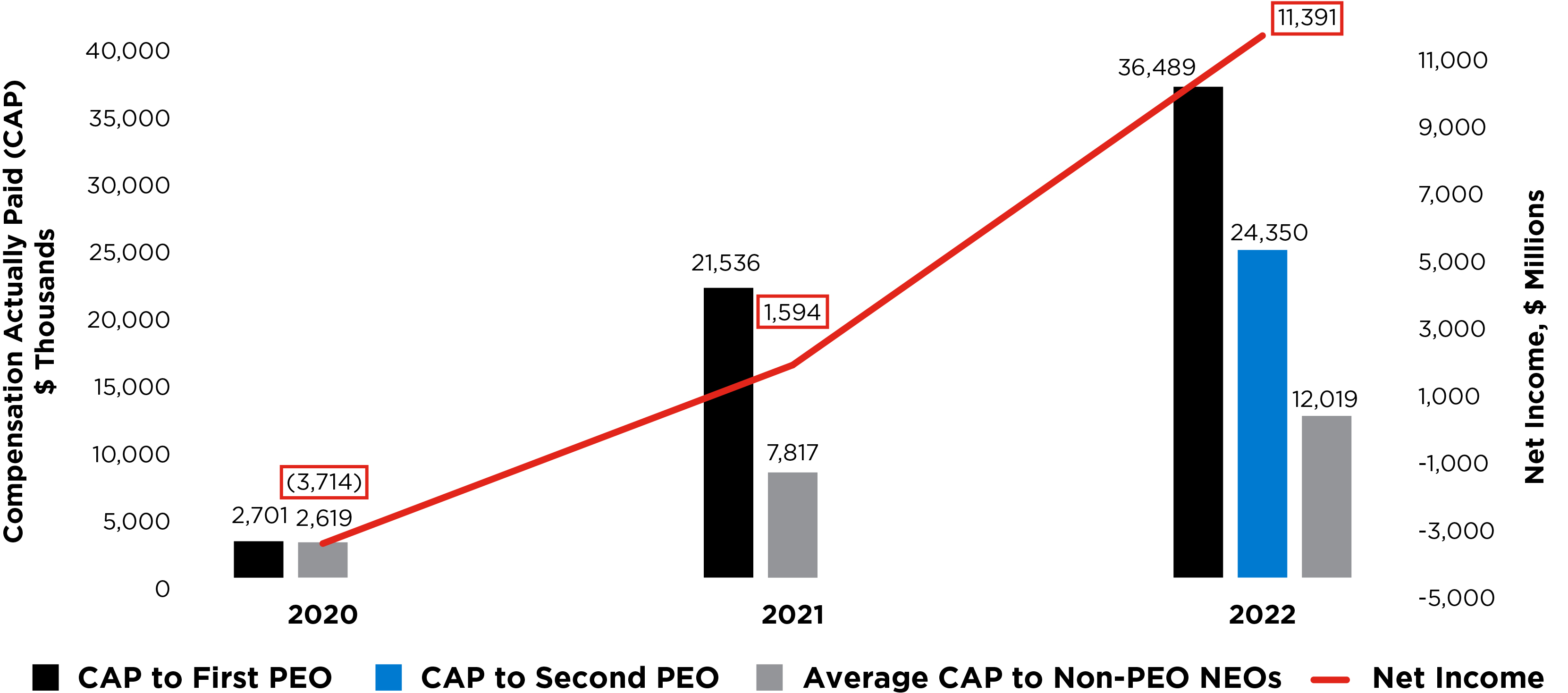
| 82 | Phillips 66 2023 Proxy Statement | ||||
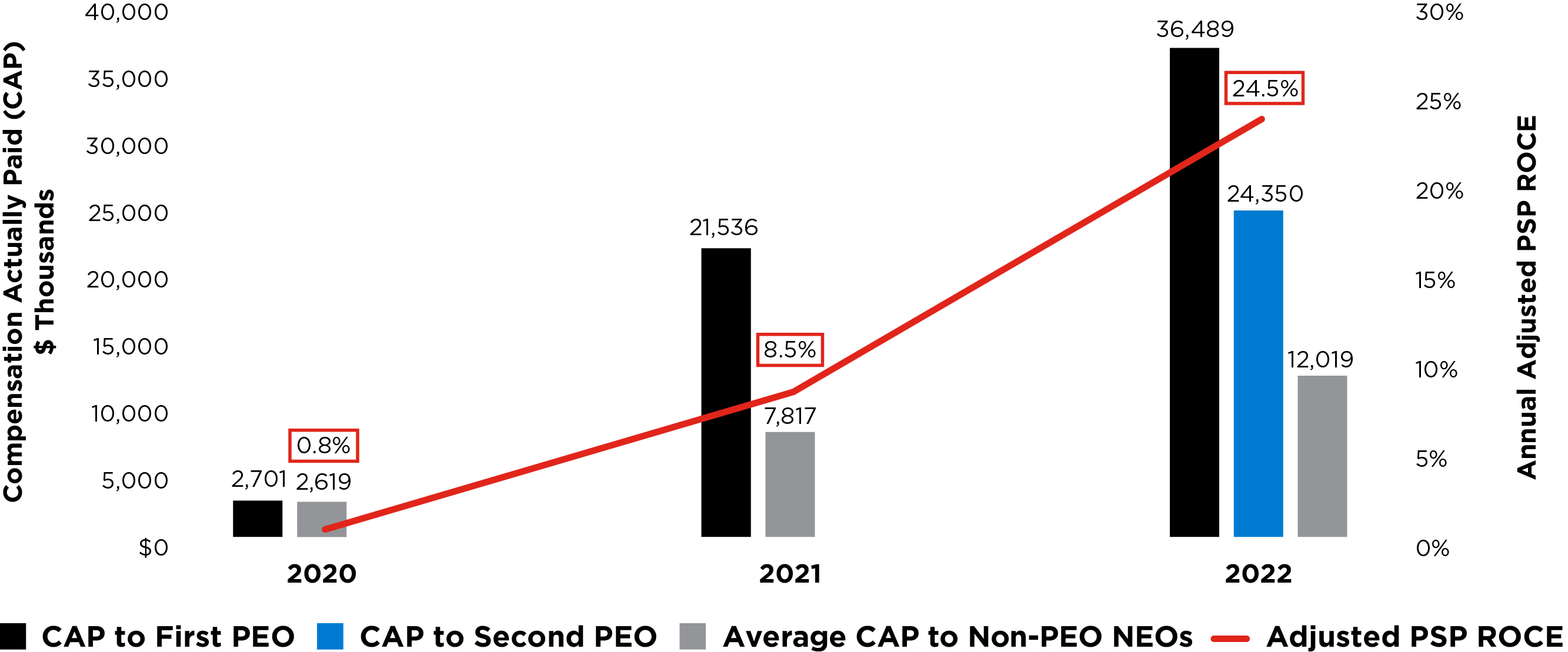
| Most Important Performance Measures | •Adjusted EBITDA | ||||
•Adjusted Controllable Costs | |||||
•Adjusted PSP ROCE | |||||
•3-Year Relative TSR | |||||
| Pay versus Performance | 83 | ||||
| Equity Compensation Plan Information | |||||
| Plan Category | Number of Securities to be Issued upon Exercise of Outstanding Options, Warrants and Rights(1,2) | Weighted-Average Exercise Price of Outstanding Options, Warrants and Rights(3) | Number of Securities Remaining Available for Future Issuance Under Equity Compensation Plans (Excluding Securities Reflected in Column (a)(4) | ||||||||
| Equity compensation plans approved by security holders | 10,266,486 | $84.97 | 14,867,234 | ||||||||
| Equity compensation plans not approved by security holders | — | — | — | ||||||||
| Total | 10,266,486 | $84.97 | 14,867,234 | ||||||||
| 84 | Phillips 66 2023 Proxy Statement | ||||
PROPOSAL 4  | Ratification of the Appointment of Ernst & Young The Board recommends that you vote “FOR” the proposal to ratify the appointment of Ernst & Young LLP for fiscal year 2023. | ||||
|
| Proposal 4: Ratification of the Appointment of Ernst & Young | 85 | ||||
| Fees (in millions) | 2020 | 2019 |
| Audit Fees(1) | $11.4 | $13.0 |
| Audit-Related Fees(2) | 1.0 | 1.2 |
| Tax Fees(3) | 0.1 | 0.1 |
| All Other Fees | 0.2 | 0.2 |
Total | $12.7 | $14.5 |
|
| Fees (in millions) | 2022 | 2021 | ||||||
Audit Fees(1) | $ | 12.2 | $ | 11.4 | ||||
Audit-Related Fees(2) | $ | 0.5 | $ | 0.6 | ||||
Tax Fees(3) | $ | 0.3 | $ | — | ||||
| All Other Fees | $ | 0.1 | $ | 0.2 | ||||
| Total | $ | 13.1 | $ | 12.2 | ||||
|
One or more representatives of Ernst & Young are expected to be present at the Annual Meeting. The representatives will have an opportunity to make a statement if they desire and will be available to respond to appropriate questions from shareholders.
|
|
2022.
| 86 | Phillips 66 2023 Proxy Statement | ||||
2022.
Victoria J. Tschinkel
|
|
PROPOSAL 4: ADVISORY APPROVAL OF EXECUTIVE COMPENSATION
In accordance with Section 14A of the Securities Exchange Act of 1934, as amended, shareholders are being asked to vote on the following advisory (non-binding) resolution:
RESOLVED, that the shareholders approve the compensation of Phillips 66's Named Executive Officers (NEOs) as described in this Proxy Statement in the COMPENSATION DISCUSSION AND ANALYSIS section and in the EXECUTIVE COMPENSATION TABLES (together with the accompanying narrative disclosures).
|
Approval of this proposal requires the affirmative vote of a majority of the shares present in person or represented by proxy at the meeting and entitled to vote on the proposal.
As required by SEC rules, Phillips 66 is providing shareholders with the opportunity to vote on an advisory resolution, commonly known as “Say-on-Pay,” considering approval of the compensation of its NEOs.
The Compensation Committee, which is responsible for the compensation of our CEO and Senior Officers (as defined in ROLE OF THE HUMAN RESOURCES AND COMPENSATION COMMITTEE), has overseen the development of compensation programs designed to attract, retain and motivate executives who enable us to achieve our strategic and financial goals. The COMPENSATION DISCUSSION AND ANALYSIS and the EXECUTIVE COMPENSATION TABLES, together with the accompanying narrative disclosures, allow you to view the trends in compensation and application of our compensation philosophies and practices for the years presented.
The Board of Directors believes that the Phillips 66 executive compensation programs align the interests of our executives with those of our shareholders. Our compensation programs are guided by the philosophy that the Company's ability to provide value is driven by superior individual performance. The Board believes that a company must offer competitive compensation to attract and retain experienced, talented and motivated employees. In addition, the Board believes employees in leadership roles within the organization are motivated to perform at their highest levels when performance-based pay represents a significant portion of their compensation. The Board believes that our philosophy and practices have resulted in executive compensation decisions that are aligned with Company and individual performance, are appropriate in value, and have benefited the Company and its shareholders.
Because your vote is advisory, it will not be binding upon the Board of Directors. Nevertheless, the Compensation Committee and the Board will consider the outcome of the vote when evaluating future executive compensation arrangements. However, votes for or against our compensation programs will not necessarily inform the Compensation Committee and the Board about which elements of those programs shareholders approve or disapprove. For this reason, the Board encourages shareholders to engage with us to allow the Compensation Committee to understand shareholders' views and consider that feedback when making decisions.
|
|
COMPENSATION DISCUSSION AND ANALYSIS
Our performance results and strategic highlights are presented below. The compensation decisions reflected in this Compensation Discussion and Analysis (“CD&A”) demonstrate the Compensation Committee’s disciplined and rigorous application of the Phillips 66 compensation philosophy, program structure and performance standards relative to the 2020 performance of Phillips 66 and the named executive officers. Some of these results are not measures of financial performance under U.S. generally accepted accounting principles (GAAP), for which more information is available in Appendix B.
| ||
| ||
|
| |
| ||
| ||
|
| |
| ||
| ||
| ||
| ||
|
|
COVID-19 Response
COVID-19 has had significant, far-reaching impacts on the global economy and its citizens. Our top priority has been the health and safety of our Company, our employees and their families, and the communities in which we live and work. Highlights of our efforts are presented below:
|
|
|
|
|
|
No Change to Compensation Programs Related to COVID-19
This year tested the resilience and effectiveness of our compensation program design and targets, particularly in a challenging economic environment. As the year progressed, the Compensation Committee monitored the Company’s performance relative to the originally approved targets and determined that the programs were functioning as intended and no adjustments were warranted. Specifically, we are pleased to highlight that we did not:
| Proposal 4: Ratification of the Appointment of Ernst & Young | 87 | ||||
The payouts for our 2020 VCIP and Performance Share Program 2018 – 2020 described in this CD&A were based on the Company’s performance relative to the originally approved metrics with no adjustments.
EXECUTIVE COMPENSATION PROGRAM SUMMARY
Since our inception in 2012, our strategy is unchanged and we have operated with clear objectives − enable our high-performing workforce to execute our corporate strategy efficiently and effectively, while remaining vigilant and focused on safety and operating excellence, in order to deliver profitable growth, enhance returns, and provide a secure, competitive and growing dividend.
We operate in a volatile industry and the events of 2020, including the COVID-19 pandemic, social unrest and natural disasters, challenged the resiliency of our diversified portfolio, our strategy and our employees. Through our
|
|
disciplined approach to capital management, we took measures to secure additional liquidity and reduce our controllable costs.
Our Named Executive Officers (“NEOs”) for 2020 were:
Compensation and Benefits Philosophy and Guiding Principles
Our Compensation and Benefits Philosophy and Guiding Principles form the foundation upon which our compensation and benefits programs are developed in alignment with our corporate vision, strategy and values. The Compensation Committee regularly reviews our Compensation Philosophy and Guiding Principles. Our programs are designed to attract, retain, develop and reward a high-performing workforce to successfully execute our corporate strategy. Embedded in our talent management strategy is the longstanding commitment to equal opportunity in all aspects of employment.
Executive Compensation Best Practices
|
|
New Executive Compensation Developments For 2021
Compensation Programs
The following table summarizes the principal elements of our executive compensation program and the performance drivers of each element.
| |||
| |||
|
| ||
|
|
| |
| |||
|
Compensation Mix Puts Significant Pay at Risk
Consistent with our philosophy that executive compensation should be linked to Company performance and directly aligned with shareholder value creation, a significant portion of NEO compensation is at risk and based on performance metrics tied to our corporate strategy. "At risk" means there is no guarantee that the target value of the awards will be realized. Based on its evaluation of performance, the Compensation Committee has authority to reduce, and even award nothing for, the performance-based payouts and individual performance adjustments under each of the VCIP and PSP. Stock options can expire with zero value if the Company stock price does not appreciate above the grant date price over the 10-year term of the options. RSUs may lose value depending on stock price performance. Therefore, for NEOs to earn and sustain competitive compensation, the Company must meet its strategic objectives, perform well relative to peers, and deliver market-competitive returns to shareholders. Further detail on the alignment of compensation and shareholder outcomes is described in CEO PAY ALIGNED WITH COMPANY PERFORMANCE.
CEO target compensation mix is 91% at risk and 74% performance-based. The average target mix for the other NEOs is 84% at risk and 69% performance-based. Further, LTI awards make up 76% of the CEO and 69% of other NEOs target compensation mix. For both the CEO and other NEOs, target mix percentages are commensurate with their levels of responsibility. Further detail on these programs is provided in EXECUTIVE COMPENSATION PROGRAM DETAILS.
|
|
The target mix of the compensation program elements for the CEO and other NEOs is shown below. The charts outline the relative size, in percentage terms, of each element of target compensation.
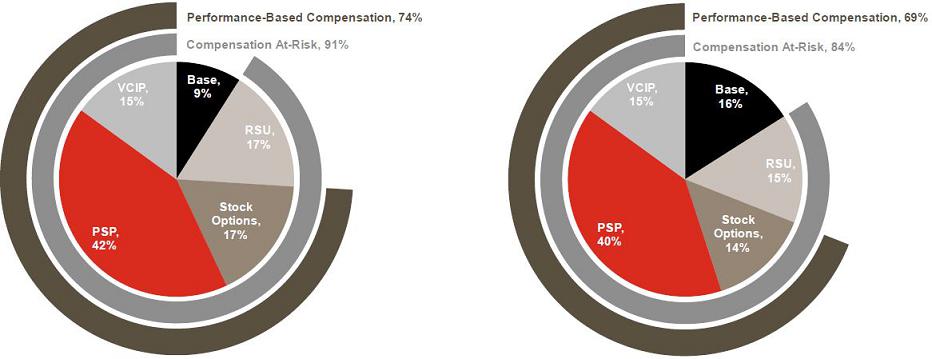
Aligned with Best Practices
The following best practices are reflected in our executive compensation programs:
| ||
| ||
| ||
| ||
| ||
| ||
| ||
| ||
| ||
| ||
| ||
| ||
| ||
| ||
| ||
| ||
| ||
| ||
| ||
|
|
| |
| |
|
EXECUTIVE COMPENSATION PROGRAM DETAILS
Base Salary
Base salary is designed to provide a competitive and fixed rate of pay recognizing employees' different levels of responsibility and performance. As the majority of our NEO compensation is performance-based and tied to long-term programs, base salary represents a less significant component of total compensation. In setting each NEO's base salary, the Compensation Committee considers factors including, but not limited to, the responsibility level for the position held, market data from the compensation peer group for comparable roles, experience and expertise, individual performance and business results.
Below is a summary of the annualized base salary for each NEO for 2020. Because these amounts reflect each NEO's annualized salary as of the dates indicated, this information may vary from the information provided in the SUMMARY COMPENSATION TABLE, which reflects actual base salary earnings in 2020, including the effect of salary changes during the year.
| Name | Salary as of 1/1/2020 ($) | Salary as of 12/31/2020 ($) | ||
| Greg Garland | 1,675,008 | 1,675,008 | (1) | |
| Kevin Mitchell | 867,000 | 903,432 | ||
| Robert Herman | 850,008 | 870,432 | ||
| Paula Johnson | 805,416 | 836,040 | ||
| Tim Roberts | 850,008 | 887,424 | ||
Annual base salary increases were effective March 1, 2020, as part of the annual merit cycle for all employees. Base salary increases realign the NEO with the respective compensation peer group levels and reflect each NEO's achievement of established performance objectives corresponding to his or her role. The Compensation Committee determined the adjustments that were made were appropriate to maintain our competitiveness in the market.
Variable Cash Incentive Program (VCIP)
The VCIP, which is our annual incentive program, is designed to provide variability and differentiation based on corporate and individual performance. Through our operational and financial metrics, we designed our VCIP program to align annual awards with shareholder interests and execution of our corporate strategy. We do not tie NEO VCIP awards to the performance of any individual business unit. We believe this structure serves the best interests of shareholders as it promotes collaboration across the organization.
Eligible earnings, which is base salary earned during the year, are multiplied by a VCIP target percentage that is based on each NEO's salary grade level to derive the NEO's target VCIP award. At the end of the performance period, the Compensation Committee reviews the Company's performance to determine the Corporate Payout Percentage. This percentage is based on a mix of operational and financial metrics, the details and weighting of which are described below. The Compensation Committee can award a Corporate Payout Percentage of zero up to the maximum of 200%.
The target award is multiplied by the Corporate Payout Percentage, after which the Compensation Committee takes into account the individual accomplishments of each NEO when determining applicable Individual Performance Adjustments. Individual Performance Adjustments can range from +/–50% of the target award. Adjustments are based on measurable performance of the individual NEO that drives shareholder value.
|
|
|
|
|
|
|
The Compensation Committee reviews metric selection annually to ensure continued alignment with our strategy. For 2020, the Committee used the same metrics as it has in prior years as they believe these metrics were the most appropriate to align compensation with our corporate strategy at this time. This mix of financial and operational metrics, and the rigorous goals set annually by the Compensation Committee, is designed to ensure a balanced view of the Company performance and drive results and continued improvement over the near term.

Adjusted EBITDA
We believe Adjusted EBITDA is effective in evaluating our annual core operating performance and is how we determine enterprise value. Our threshold represents the Adjusted EBITDA required to cover our sustaining capital and shareholder dividend commitments. To ensure we continue to deliver on our growth strategy, the target and maximum for Adjusted EBITDA represent returns that are 1.5% and 3.0% above our Weighted Average Cost of Capital (WACC), respectively.
Based on actual Company performance being 68% below target and below threshold, the Compensation Committee determined that no payout was earned for this metric. Adjusted EBITDA, as used for VCIP, is a non-GAAP financial measure. See Appendix B for additional information.

Operating Excellence
Operating excellence, including personal and process safety, environmental stewardship and asset availability, is foundational in meeting our corporate strategy of growth, returns and distributions. Strong operating excellence is essential in demonstrating our focus on Environment, Social and Governance matters, which we view as driving shareholder value creation. We measure ourselves against other companies in our industry for personal and process safety metrics and target sustained performance in environmental stewardship and effective management of unplanned downtime for asset availability.
For metrics for which comparative data was available, like Total Recordable Rate (TRR), Lost Workday Case Rate (LWCR), and Process Safety Event (PSE) Rate, we benchmarked ourselves against companies with the strongest
|
|
safety records in our industry. Generally, these companies fall within the top two quartiles of all companies reported. We then established our threshold, target, and maximum goals based on the 25th, 50th, and 75th percentiles of this group of companies.
Where comparative data was not available, like for asset availability and environmental events, we established our threshold, target, and maximum goals based on our own historical performance, with the goal of continuous improvement. For asset availability, we incorporate the lines of our business and weight them by EBITDA.
In 2020, we exceeded or tied our previously best performance for TRR, LWCR, PSE Rate, and Environmental Events. For Asset Availability, we exceeded our target level of performance. As a result, the Compensation Committee approved an overall payout for Operating Excellence of 194% of target.
| Payout Levels Based on Performance | 2020 Results | Payout % | ||||
| 0% | 50% | 100% | 200% | |||
| Combined TRR | > 0.37 | 0.37 | 0.21 | 0.16 | 0.11 | 200% |
| Combined LWCR | > 0.13 | 0.13 | 0.06 | 0.05 | 0.02 | 200% |
| Process Safety Event Rate | > 0.09 | 0.09 | 0.07 | 0.04 | 0.02 | 200% |
| Environmental Events | > 122 | 122 | 115 | < 109 | 75 | 200% |
| Asset Availability | < 93.6% | 93.6% | 95.3% | 97.0% | 96.8% | 188% |
| Combined Operating Excellence | 194% | |||||

Adjusted Controllable Costs
Adjusted Controllable Costs focuses on maintaining or reducing costs. We operate in an industry where a substantial portion of operating costs are market driven and this metric drives a culture of cost discipline. Our targets for threshold, target, and maximum are based on our budget for the year. For threshold performance, Adjusted Controllable Costs could not exceed budget by more than 3%, target performance was based on achieving budget, and maximum performance required Adjusted Controllable Costs to be 3% under budget.
|
|
Given the economic environment during 2020, we quickly adapted to the market conditions and reduced our adjusted controllable costs by 6% versus our approved budget, resulting in a payout of 200%. Adjusted Controllable Costs is a non-GAAP financial measure. See Appendix B for additional information.

High-Performing Organization (HPO)
We believe maintaining and enhancing a high-performing organization is critical to our success and is part of our human capital management strategy. Our employees promote our culture and are integral to achieving our strategic goals and maximizing long-term shareholder value. We measure our High-Performing Organization performance relative to the following:
|
|
|
|
|
|
| ||
We strive for continuous improvement of our high-performing organization, as we believe it is our employees that differentiate us in the market. Based on our superior performance, the Compensation Committee determined that 180% of target was earned for High-Performing Organization.

|
|
Total Corporate Payout
The formulaic result of our individual metrics was a Total Corporate Payout of 115%, as summarized in the following table.
| Metric | Payout Percentage | Weight | Corporate Amount | |||
| Adjusted EBITDA | 0% | 40% | 0% | |||
| Operating Excellence | 194% | 35% | 67% | |||
| Adjusted Controllable Costs | 200% | 15% | 30% | |||
| High-Performing Organization | 180% | 10% | 18% | |||
| Total Corporate Payout | 115% | |||||
Individual Performance Highlights
The Compensation Committee has the authority to adjust our NEOs' individual VCIP payouts by +/–50% of the formula-based target payout. The Compensation Committee may apply an individual performance adjustment to reflect project-based accomplishments that drove or detracted from shareholder value or for market-based considerations to more closely align the payout with shareholder returns. This flexibility allows us to reflect our unique business strategy and portfolio of assets as well as differentiate individual executive performance. The Compensation Committee adjusted the individual VCIP payouts for NEOs based on their responsibility for the success of projects and initiatives that led to the execution of our strategy. These projects and initiatives, as shown in the following table, contributed to the execution of our strategy and produced the results as shown in our Company Performance Summary.
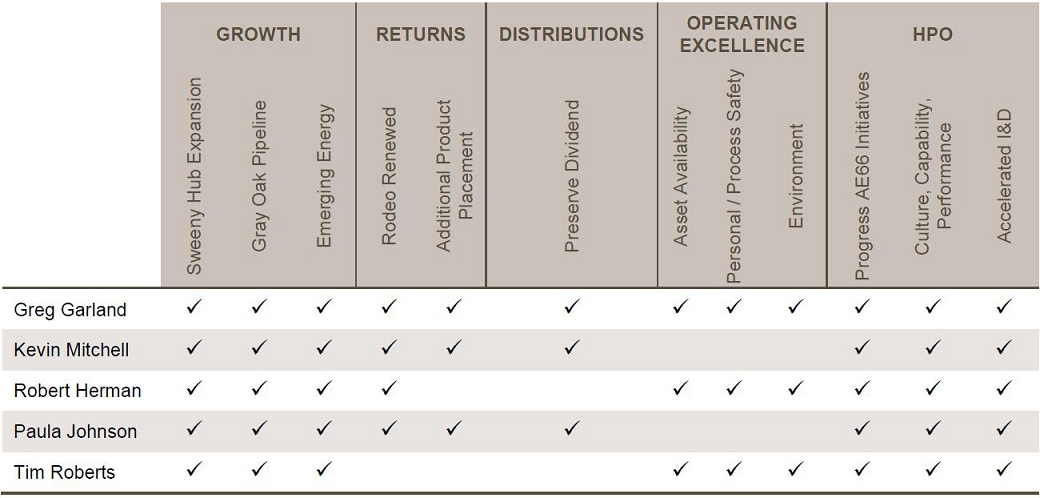
|
|
Total VCIP payouts for each of our NEOs are shown in the table below.
| 2020 Eligible Earnings ($) | Target VCIP Percentage (%) | Corporate Payout Percentage (%) | Individual Performance Adjustment (%) | Total Payout ($) | ||||||
| Greg Garland | 1,675,008 | 160 | % | 115 | % | 0 | % | 3,082,015 | ||
| Kevin Mitchell | 897,360 | 100 | % | 115 | % | 25 | % | 1,256,304 | ||
| Robert Herman | 867,028 | 90 | % | 115 | % | 25 | % | 1,092,455 | ||
| Paula Johnson | 830,936 | 90 | % | 115 | % | 15 | % | 972,195 | ||
| Tim Roberts | 881,188 | 90 | % | 115 | % | 25 | % | 1,110,297 | ||
The Compensation Committee concluded that, due to the challenging economic environment and our TSR performance, it was not appropriate to make a positive individual performance adjustment on Mr. Garland’s 2020 VCIP award despite significant achievements during the year.
Variable Cash Incentive Program – Increased Focus on Sustainable Performance in 2021
At Phillips 66, we provide energy that improves lives and meets the world’s growing needs. At the same time, we know that climate change is a complex, global issue that requires long-term commitment, action by every segment of society, technology development and free-markets solutions.
Our commitment to providing energy and improving lives includes advancing the global effort to transition to a lower-carbon economy. To demonstrate this commitment, we have enhanced our 2021 VCIP design to increase the weighting of our Environment metric from 5% to 15% to include two new metrics, each weighted 5%:
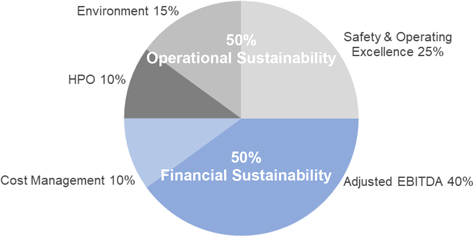
These enhancements deliver a VCIP design that equally weights our Operational Sustainability and Financial Sustainability performance – both essential as we execute our corporate strategy and maximize shareholder value.
Long-Term Incentive Programs Link Pay Outcomes to Company Performance
We deliver 50% of long-term target value as awards from our Performance Share Program, 25% in the form of stock options, and 25% in the form of RSUs.
We believe this mix of awards is aligned with our compensation philosophy, reflects the cyclical nature of our
|
|
business, promotes retention of our high-performing talent, supports succession planning and is consistent with market practice.
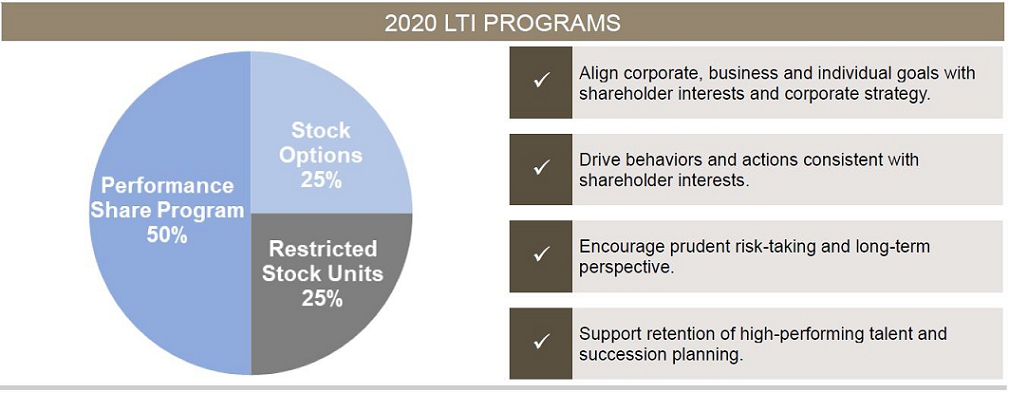
Performance Share Program (PSP)
Each PSP has a three-year performance period, and therefore three PSPs are in progress at any time. Programs in effect during 2020 were PSP 2018-2020, PSP 2019-2021, and PSP 2020-2022. By delivering 50% of LTI through the PSP, a significant portion of NEO compensation is tied to long-term Company performance, incentivizing continued outperformance relative to peers and aligning management interests with those of shareholders.
Target Shares at Beginning of Performance Period. The Compensation Committee uses the Compensation Peer Group to benchmark LTI and establish base salary multiples for similar roles at peer organizations. The number of target shares is determined by dividing the multiple by the average of the stock's fair market value for the 20 days prior to the start of the performance period, less anticipated dividends during the performance period.
The Compensation Committee assesses the individual performance of each NEO and, based on that assessment, may adjust an award by up to +/–30% of the target amount at grant. The CEO provides input regarding awards made to all NEOs (other than himself) and the Compensation Committee evaluates the individual performance of the CEO. The Compensation Committee believes in applying performance adjustments to the number of target shares at the beginning of the performance period, rather than the end, so that performance-adjusted compensation is subject to Company performance and market volatility throughout the performance period, aligning executive compensation with shareholder interests.
Performance Metrics. The performance metrics used for all three current PSP programs are after-tax return on capital employed (ROCE) and total shareholder return (TSR) based on a 20-day average closing price. After-tax ROCE accounts for 50% and is equally weighted between absolute and relative performance (for the PSP 2020-2022, only absolute ROCE is used). The remaining 50% is our TSR performance relative to peers.
The Compensation Committee considers ROCE an important measure of Company growth and overall performance. When establishing the Absolute ROCE performance metrics, the Compensation Committee reviews the corporate strategy, operating targets, and past performance to set metrics that are expected to be rigorous, demand strong performance, and reward for delivering results above the Company’s WACC.
|
|
The Compensation Committee also recognizes that relative TSR is the most common standard for relative comparisons to peers. Our performance is evaluated as compared to our Performance Peer Group and the S&P 100 Index. Further information regarding our Performance Peer Group is provided in Peer Group Comparisons.
These metrics translate into the following goals:
|
|
| ||
|
|
| ||
|
|
| ||
Settlement. Awards under the PSP programs are denominated in shares but are paid in cash at the end of their respective performance periods. Performance can range from 0-200% of target.
PSP 2018-2020 Payout. After the close of the PSP 2018-2020, the Compensation Committee considered the following results when approving the payout of 125% of target.

|
|


The Compensation Committee approved payouts for our NEOs for PSP 2018-2020. The payment was made in February 2021 and is described further below and in the footnotes of the SUMMARY COMPENSATION TABLE.
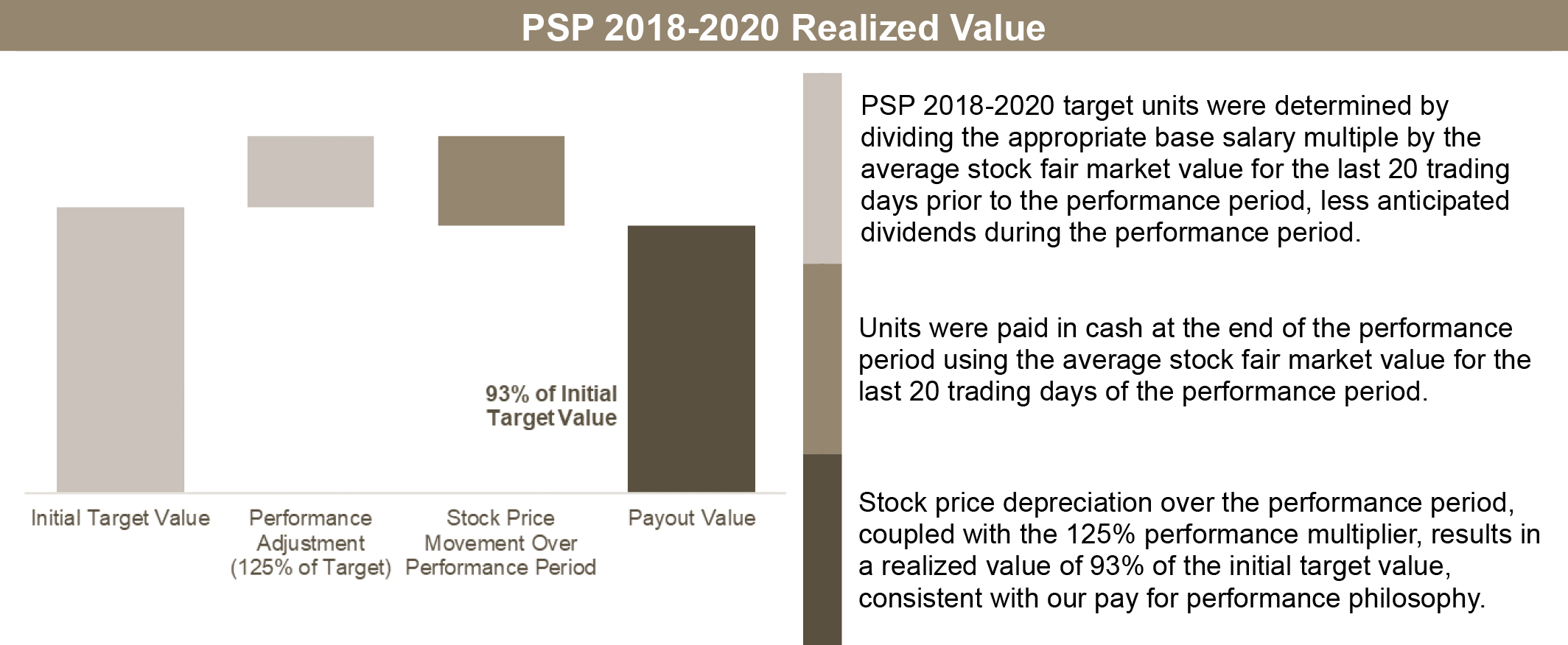
Stock Option Program
In 2020, 25% of the LTI target value was delivered to executives in the form of stock options. These awards are inherently performance-based, as the stock price must increase before the executive can realize any value. We believe stock options drive behaviors and actions that enhance long-term shareholder value.
Stock options are typically granted in February each year. The number of options awarded is calculated based on the Black-Scholes-Merton model. The exercise price of stock options is set at 100% of the fair market value of our common stock on the date of grant. Stock options granted to our NEOs in February 2020 vest ratably over a three-year period and have a ten-year term. Stock options do not have voting rights and are not entitled to receive dividends.
Restricted Stock Units (RSUs)
In 2020, 25% of the LTI target value was delivered to executives in the form of RSUs. The Compensation Committee believes maintaining RSUs in our LTI program complements the overall compensation mix by:
|
|
RSUs are typically granted in February each year. The Compensation Committee assesses the individual performance of each NEO and based on that assessment, may adjust an award by up to +/–30% of the target amount at grant. The CEO provides input regarding awards made to all NEOs (other than himself). The Compensation Committee evaluates the individual performance of the CEO. The number of RSUs is determined based on the fair market value of Company stock on the date of grant. RSUs awarded to our NEOs in February 2020 cliff vest after three years. RSUs do not carry voting rights but do earn dividend equivalents during the vesting period.
2020 LTI Compensation
The Compensation Committee approved the following LTI for the NEOs for 2020. The Compensation Committee considered the individual performance of each NEO as outlined above when determining the target values. These values may not match the accounting values presented in the GRANTS OF PLAN-BASED AWARDS table.
| NAME | PSP 2020-2022 ($) | STOCK OPTIONS ($) | RSUs ($) | TOTAL TARGET (1) ($) | ||||
| Greg Garland | 6,700,032 | 3,350,016 | 3,350,016 | 13,400,064 | ||||
| Kevin Mitchell | 2,193,510 | 997,050 | 1,096,755 | 4,287,315 | ||||
| Robert Herman | 1,683,016 | 765,007 | 841,508 | 3,289,531 | ||||
| Paula Johnson | 1,594,724 | 724,874 | 797,362 | 3,116,960 | ||||
| Tim Roberts | 1,836,017 | 765,007 | 918,009 | 3,519,033 | ||||
CEO Pay Aligned with Company Performance
A significant portion of CEO pay is delivered in long-term incentives, which are designed to tie share price performance and achievement of our long-term financial goals. Mr. Garland’s pay as reported in the SUMMARY COMPENSATION TABLE (“SCT”) reflects the accounting value of long-term incentives at the time of grant and not the actual value received from these grants. When evaluating the compensation program each year, the Compensation Committee reviews outstanding awards and the value earned under the long-term incentive program in prior periods to confirm that the payouts are aligned with performance and intended incentives. As such, we believe it is useful to compare Mr. Garland’s “Adjusted SCT Pay” in the context of his “Realized Pay” to provide a clear picture of the value being delivered to Mr. Garland and how it relates to Company performance.
For purposes of the information in this section, we define:
As demonstrated in the chart below, Adjusted SCT Pay and Realized Pay differ meaningfully and demonstrate the intended link between our compensation program and outcomes for shareholders. During periods of strong stock price performance, our equity-linked long-term incentives may deliver more value to executives than is rendered in
|
|
the Summary Compensation Table. When stock price declines, the value of our executive’s equity-linked long-term compensation declines and realized compensation may lag the value rendered in the Summary Compensation Table, consistent with the intended alignment between investor outcomes and compensation outcomes.
The charts and information included below are not substitutes for the information included in the SUMMARY COMPENSATION TABLE, but are meant to provide additional insight into our CEO pay:
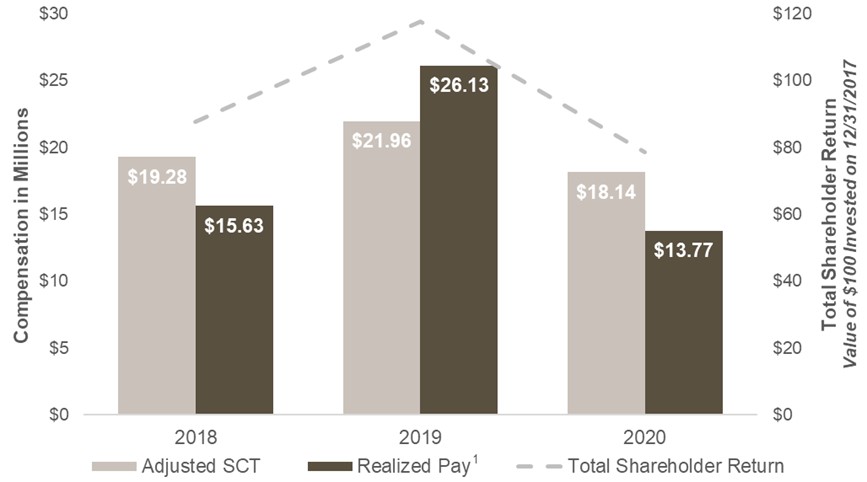
(1) We have not included the Performance Share Programs that had a 5-year restriction period after the performance period for Realized Pay purposes. Specifically, we did not include the lapsing of restrictions of PSP 2010-2012 in 2018, PSP 2011-2013 in 2019, and PSP 2012-2014 in 2020.
2021 Chairman and Chief Executive Officer Compensation
At its February 4, 2021 meeting, the Compensation Committee approved a reduction to the 2021 target compensation for Greg Garland, Chairman and Chief Executive Officer to better align with our compensation peer group and the changing market conditions. The Compensation Committee also decided not to increase Mr. Garland’s base salary, which has remained unchanged since March 1, 2017.
| YEAR | BASE SALARY ($) | VCIP ($) | PSP ($) | STOCK OPTIONS ($) | RSUs ($) | TOTAL TARGET ($) |
| 2020 | 1,675,008 | 2,680,013 | 6,700,032 | 3,350,016 | 3,350,016 | 17,755,085 |
| 2021 | 1,675,008 | 2,680,013 | 6,281,280 | 3,140,640 | 3,140,640 | 16,917,581 |
The reduction in total target compensation is approximately $800,000 or 5%.
Peer Group Comparisons
We utilize both a compensation peer group and a performance peer group due to the size of our Company and diversification of assets. The Compensation Committee reviews these peer groups annually and adjusts as necessary. We benchmark against large companies, as measured by asset value and market capitalization, to set target compensation using the compensation peer group. We assess our relative performance against peers in the industries in which we operate using the performance peer group. While our unique portfolio of assets provides an advantage to investors, it does necessitate using two peer groups to appropriately align compensation and assess performance.
|
|
Compensation Peer Group
Relative analysis. We use the compensation peer group to evaluate and determine compensation levels for our NEOs, including base salary adjustments and targets for our annual bonus and LTI programs.
Criteria for selection. Our compensation peer group consists of companies that have similar jobs and job scope as our NEOs. The compensation peer group primarily consists of large companies with significant capital investments and complex international operations.
Our compensation peer group includes companies that are comparable to Phillips 66 based on three primary criteria – assets, market capitalization, and business operations. Revenue is a secondary criterion due to the nature of our operations. The Compensation Committee believes each of these criteria is necessary to fully reflect the complex nature of our business and determine the optimal group of companies with which to compare Phillips 66.
Companies included. The table below shows the companies in our 2020 compensation peer group. At the time the compensation peer group was determined, we were at the 43rd percentile in assets, 63rd percentile in market value, and 65th percentile in revenue.
| ||
| ||
Performance Peer Group
Relative analysis. The performance peer group is used to evaluate relative business results in our Performance Share Program. This includes both relative TSR and relative ROCE. We also evaluate our relative TSR performance against the S&P 100 Index, which the Compensation Committee believes is an appropriate comparison for performance purposes because the index reflects the companies with which we compete for capital in the broader market.
Criteria for selection. Phillips 66 is uniquely positioned in the energy industry, with a large refining and marketing base, a growing midstream NGL business and significant petrochemical exposure. To reflect our unique portfolio of assets, we include companies operating in each of our three major businesses. We believe that our performance peer group is representative of the companies that investors use for relative performance comparisons.
Companies included. The table below shows the performance peer group that was established for evaluating both relative TSR and relative ROCE for the three-year performance period ended December 31, 2020.
Marathon Petroleum Corporation acquired Andeavor during the performance period. Each of Marathon Petroleum Corporation and Andeavor was previously in our performance peer group; after the acquisition we included the combined company.
Changes for 2020. For performance periods beginning in 2020, the Compensation Committee reviewed the current performance peers and approved the following changes:
|
|
OTHER BENEFITS AND PERQUISITES
Below is a summary of other compensation elements available to our NEOs:
Broad-Based Employee Benefit Programs
NEOs participate in the same basic benefits package available to our other U.S. salaried employees. This package includes qualified pension; 401(k) plan; medical, dental, vision, life, and accident insurance plans, as well as flexible spending arrangements for health care and dependent care expenses; and our matching gift program.
Additional Executive Perquisites
Consistent with our compensation philosophy to provide compensation and benefits aligned with market practice, we provide our NEOs financial planning and executive health benefits. These benefits were imputed to the executives and included in All Other Compensation in the SUMMARY COMPENSATION TABLE. We did not provide a gross-up for these benefits.
Comprehensive Security Program
The Board has adopted a comprehensive security program to address the increased security risks for certain senior executives. Mr. Garland was the only NEO in 2020 designated by the Board as requiring increased security under this program. The program allows for certain additional security measures in specific situations when the senior executive is traveling by car or airplane. An additional security review of the NEO's personal residences is also included. Any additional costs to the Company for these activities are reported as All Other Compensation and included in the SUMMARY COMPENSATION TABLE.
Executive Retirement Plans
We maintain the following supplemental retirement plans for our NEOs.
Executive Life Insurance
We provide life insurance policies to all U.S.-based employees with a face value approximately equal to their annual base salary. For our NEOs, the face value of this coverage is approximately two times their annual base salary.
Executive Severance and Change in Control Plans
We do not maintain individual severance or change in control (CIC) agreements with our executives. However, we maintain the Phillips 66 Executive Severance Plan (ESP) and the Phillips 66 CICSP to accomplish several specific objectives, including:
|
|
Executives may not participate in both plans as a result of the same severance event. Among other benefits, the ESP provides a payment equal to one and one-half or two times the executive's base salary, depending on salary grade level, and the executive's current target annual bonus if he or she is involuntarily terminated without cause. The CICSP provides a payment equal to two or three times the sum of the executive's base salary and the greater of his or her target bonus or average of the last two bonus payments, depending on salary grade level. The executive must be involuntarily terminated without cause in connection with a change in control or terminate employment for good reason within two years after the change in control to be eligible for a CICSP payment. We believe this "double trigger" requirement is in the best interest of shareholders and is considered a best practice.
Details of potential payments under these plans are outlined in the POTENTIAL PAYMENTS UPON TERMINATION OR CHANGE IN CONTROL section. These plans do not provide any excise tax gross-up protections.
Personal Use of Company Aircraft
The primary purpose of our corporate aircraft is to facilitate Company business. In the course of conducting Company business, executives may occasionally invite a family member or other personal guest to travel with them to attend a meeting or function. When such travel is deemed taxable to the executive, we provide further payments to reimburse the costs of the inclusion of this item in his or her taxable income.
EXECUTIVE COMPENSATION GOVERNANCE
Clawback Provisions
Short- and long-term compensation, deferred compensation and nonqualified retirement benefits received by any executive are subject to clawback provisions if financial or other data is materially misstated due to negligence or misconduct on the part of the executive, as determined by the Compensation and Audit Committees.
Stock Ownership
The Compensation Committee believes requiring executives to retain shares of Phillips 66 common stock helps align executive performance with shareholder value creation and mitigates compensation risk. Our stock ownership guidelines require executives to own Phillips 66 common stock, valued as a multiple of the executive's base salary, within five years from the date the executive becomes subject to the guidelines, as shown below:
Shares of Phillips 66 common stock owned and RSUs are included when determining whether an executive has met the required ownership levels. Compliance with the stock ownership guidelines is reviewed annually. All NEOs currently comply with these stock ownership guidelines or are on track to comply within the applicable five-year period.
Tax Considerations—Internal Revenue Code Section 162(m)
IRC Section 162(m) places a $1 million limit on compensation that we may deduct for federal income tax purposes in any one year with respect to certain “covered employees.” Prior to the passage of the Tax Cuts and Jobs Act in
|
|
December 2017, such covered employees included our chief executive officer and our three other most highly compensated executive officers (excluding our chief financial officer). The $1 million deduction limitation was subject to an exemption for performance-based compensation.
With the enactment of the Tax Cuts and Jobs Act, the Section 162(m) performance-based compensation exemption has been repealed and the $1 million deduction limit now applies to our chief financial officer, as well as our chief executive officer and our three other most highly compensated executive officers. Further, once an executive officer becomes a “covered employee” the $1 million deduction limit continues to apply to compensation paid to such executive officer at any time, including any future roles within the Company, any termination or retirement payments, and payments occurring after their death. The Tax Cuts and Jobs Act rules generally applied to us starting with our taxable year that commenced January 1, 2018, but do not apply to compensation provided pursuant to written binding contracts in effect on November 2, 2017, that are not materially modified after that date.
We monitor the application of Section 162(m) and the associated Treasury regulations on an ongoing basis and the advisability of qualifying executive compensation for deductibility. Notwithstanding the repeal of the exemption for "performance-based compensation," the Compensation Committee intends to maintain its commitment to structuring the Company's executive compensation programs in a manner designed to align pay with performance.
Trading Policies
Our insider trading policy prohibits all employees and directors from trading Company stock while in possession of material, non-public information. This policy requires executives and directors, as well as employees with regular access to insider information, to follow specific pre-clearance procedures before entering into transactions in our stock.
Hedging or Pledging of Company Stock
Our insider trading policy also prohibits hedging transactions and pledging of our stock. These prohibitions apply to all employees and directors of the Company, and cover any transactions in our stock, whether acquired pursuant to our compensation plans, owned directly, or otherwise. The prohibitions on hedging transactions include purchasing any financial instruments, or otherwise engaging in any transactions, that hedge or offset any decrease in the market value of our stock or limit an employee or director’s ability to profit from an increase in the market value of our stock. The prohibition on pledging includes holding Phillips 66 stock in a margin account or pledging our stock as collateral for a loan.
Independent Compensation Consultant
The primary role of the independent executive compensation consultant retained by the Compensation Committee is to advise the Compensation Committee on:
In 2020, the Compensation Committee retained Mercer as its independent executive compensation consultant. The Compensation Committee evaluated whether Mercer's work raised any conflict of interest and determined that no such conflict existed. During 2020, fees paid to Mercer in its role as the independent compensation consultant for the Compensation Committee totaled $222,528. In addition, the Company paid fees to Mercer totaling $1,890,075 during 2020 for all other services performed for the Company. These services can be broken down as 32% related to administration of pension liabilities in international locations that have been sold, 18% related to administration of ongoing international benefit plans, 11% related to Human Resources consulting engagements, and 39% related to insurance and surety bonds.
|
COMPENSATION DISCUSSION AND ANALYSIS
Compensation Risk Assessment
The Compensation Committee oversees management's risk assessment of all elements of our compensation programs, policies and practices for all employees. Management has concluded that our compensation programs, policies and practices are not reasonably likely to have a material adverse effect on the Company. Relevant provisions of our programs include, but are not limited to:
The Compensation Committee considers senior management succession planning a core part of the Company’s risk management program. The Compensation Committee regularly reviews with the CEO succession planning for senior leadership positions (other than the CEO position itself, for which succession planning is reviewed by the Nominating and Governance Committee), and the timing and development required to ensure continuity of leadership over the short- and long-terms, to manage risk in this area.
ROLE OF THE HUMAN RESOURCES AND COMPENSATION COMMITTEE
Authority and Responsibilities
The Compensation Committee is responsible for providing independent, objective oversight of our executive compensation programs and determining the compensation for our CEO and anyone who meets our definition of a Senior Officer. Currently, our internal guidelines define a Senior Officer as an officer of the Company who reports directly to the CEO or any other officer of the Company who is either a Senior Vice President or above or a reporting officer under Section 16(b) of the Exchange Act. As of December 31, 2020, we had 10 Senior Officers. In addition, the Compensation Committee acts as plan administrator of the compensation programs and benefit plans for our CEO and Senior Officers and as an avenue of appeal for current and former Senior Officers regarding disputes over compensation and benefits.
The Compensation Committee oversees the Company's executive compensation philosophy, policies, plans and programs for our CEO and Senior Officers to ensure:
|
COMPENSATION DISCUSSION AND ANALYSIS
One of the Compensation Committee's responsibilities is to assist the Board in its oversight of the integrity of the Company's COMPENSATION DISCUSSION AND ANALYSIS. The HUMAN RESOURCES AND COMPENSATION COMMITTEE REPORT summarizes certain Compensation Committee activities concerning compensation earned during 2020 by our NEOs.
A complete listing of the authority and responsibilities of the Compensation Committee is set forth in its written charter adopted by the Board of Directors, which is available in the "Investors" section of our website under the caption "Corporate Governance."
Members
The Compensation Committee consists of five members who meet all requirements for "non-employee," "independent" and "outside" director status under the Exchange Act, NYSE listing standards, and the IRC, respectively. The members of the Compensation Committee and the member to be designated as Chair, like the members and Chairs of all the Board committees, are reviewed periodically by the Nominating and Governance Committee, which recommends committee appointments to the full Board. The Board of Directors has final approval of the committee structure of the Board.
Meetings
The Compensation Committee holds regularly scheduled meetings in association with regular Board meetings and meets by teleconference between such meetings as necessary to discharge its duties. The Compensation Committee reserves time at each regularly scheduled meeting to review matters in executive session without management present except as specifically requested by the Compensation Committee. In 2020, the Compensation Committee had five regularly scheduled meetings and one additional telephonic meeting. More information regarding the Compensation Committee's activities at such meetings can be found in the COMPENSATION DISCUSSION AND ANALYSIS.
Continuous Improvement
The Compensation Committee is committed to a process of continuous improvement in exercising its responsibilities. To that end, the Compensation Committee:
HUMAN RESOURCES AND COMPENSATION COMMITTEE REPORT
Review with Management. The Human Resources and Compensation Committee has reviewed and discussed with management the COMPENSATION DISCUSSION AND ANALYSIS presented in this proxy statement.
Discussions with Independent Executive Compensation Consultant. The Human Resources and Compensation Committee has discussed with Mercer, an independent executive compensation consulting firm, the executive compensation programs of the Company, as well as specific compensation decisions made by the Human Resources and Compensation Committee for 2020. Mercer was retained directly by the Human Resources and
|
COMPENSATION DISCUSSION AND ANALYSIS
Compensation Committee, independent of the management of the Company. The Human Resources and Compensation Committee has received written disclosure from Mercer confirming the consultant's independence, has discussed with Mercer its independence from Phillips 66, and believes Mercer to be independent of management.
Recommendation to the Phillips 66 Board of Directors. Based on its review and discussions noted above, the Human Resources and Compensation Committee recommended to the Board of Directors that the COMPENSATION DISCUSSION AND ANALYSIS be included in the Phillips 66 proxy statement on Schedule 14A and the Phillips 66 Annual Report on Form 10-K for the year ended December 31, 2020.
HUMAN RESOURCES AND COMPENSATION COMMITTEE
Dr. Marna C. Whittington, Chair
Gary K. Adams
Lisa A. Davis
Harold W. McGraw III
Glenn F. Tilton
|
EXECUTIVE COMPENSATION TABLES
The following tables and accompanying narrative disclosures provide information concerning total compensation earned by our CEO and other NEOs as of December 31, 2020, for services to Phillips 66 or any of our subsidiaries during 2020, 2019 and 2018.
The following table summarizes the compensation for our NEOs for fiscal years 2020, 2019 and 2018.
| NAME, POSITION, YEAR | SALARY (1) ($) | STOCK (2) ($) | OPTION AWARDS (3) ($) | NON-EQUITY INCENTIVE PLAN COMPENSATION (4) ($) | CHANGE IN (5) ($) | ALL OTHER COMPENSATION (6) ($) | TOTAL ($) | TOTAL (7) ($) | |||||||
Greg Garland Chairman and Chief Executive Officer | |||||||||||||||
| 2020 | 1,675,008 | 9,237,623 | 3,351,180 | 3,082,015 | 6,851,884 | 791,664 | 24,989,374 | 18,137,490 | |||||||
| 2019 | 1,675,008 | 10,806,257 | 3,141,546 | 5,226,025 | 9,936,893 | 1,115,149 | 31,900,878 | 21,963,985 | |||||||
| 2018 | 1,675,008 | 9,353,917 | 3,041,430 | 4,958,024 | — | 249,956 | 19,278,335 | 19,278,335 | |||||||
Kevin Mitchell Executive Vice President, Finance and Chief Financial Officer | |||||||||||||||
| 2020 | 897,360 | 3,024,331 | 998,560 | 1,256,304 | 258,546 | 245,367 | 6,680,468 | 6,421,922 | |||||||
| 2019 | 861,172 | 3,542,763 | 937,014 | 1,722,344 | 264,245 | 354,754 | 7,682,292 | 7,418,047 | |||||||
| 2018 | 826,696 | 3,046,107 | 902,084 | 1,777,396 | 138,280 | 116,580 | 6,807,143 | 6,668,863 | |||||||
Robert Herman Executive Vice President, Refining | |||||||||||||||
| 2020 | 867,028 | 2,320,490 | 766,300 | 1,092,455 | 318,450 | 214,446 | 5,579,169 | 5,260,719 | |||||||
| 2019 | 781,558 | 2,575,994 | 553,770 | 1,293,153 | 340,714 | 441,201 | 5,986,390 | 5,645,676 | |||||||
| 2018 | 710,820 | 1,819,033 | 537,940 | 1,299,024 | 124,871 | 652,145 | 5,143,833 | 5,018,962 | |||||||
Paula Johnson Executive Vice President, Legal and Government Affairs, General Counsel and Corporate Secretary | |||||||||||||||
| 2020 | 830,936 | 2,198,675 | 725,220 | 972,195 | 2,185,352 | 200,680 | 7,113,058 | 4,927,706 | |||||||
| 2019 | 800,500 | 2,422,811 | 641,670 | 1,440,900 | 2,108,413 | 272,165 | 7,686,459 | 5,578,046 | |||||||
| 2018 | 771,544 | 2,093,245 | 618,631 | 1,388,779 | 368,541 | 81,585 | 5,322,325 | 4,953,784 | |||||||
Tim Roberts Executive Vice President, Midstream | |||||||||||||||
| 2020 | 881,188 | 2,531,427 | 766,300 | 1,110,297 | 297,744 | 204,254 | 5,791,210 | 5,493,466 | |||||||
| 2019 | 781,558 | 2,385,489 | 553,770 | 1,395,244 | 29,621 | 275,030 | 5,420,712 | 5,391,091 | |||||||
| 2018 | 710,260 | 1,810,213 | 535,871 | 1,298,000 | 107,410 | 75,521 | 4,537,275 | 4,429,865 | |||||||
(1) Includes any amounts that were voluntarily deferred under our KEDCP.
(2) Amounts shown represent the aggregate grant date fair value of RSU and PSP awards determined in accordance with U.S. GAAP. Assumptions used in calculating these amounts are included in Note 20—Share-Based Compensation Plans in the Notes to Consolidated Financial Statements in our Annual Report on Form 10-K for the year ended December 31, 2020 (our "2020 Form 10-K").
The PSP target award included in 2018 has a performance period that ended on December 31, 2020. The PSP target award included in 2019 has a performance period that ends in 2021. The PSP target award included in 2020 has a performance period that ends in 2022.
|
EXECUTIVE COMPENSATION TABLES
Amounts shown relating to PSP are targets because target is the probable outcome for the applicable performance period, consistent with the accounting treatment under GAAP. If the maximum payout were used for the PSP awards, the amounts shown relating to PSP would double, although the value of the actual payout would depend on the stock price at the time of the payout. If the minimum payout were used, the amounts for PSP awards would be reduced to zero. Actual payouts with regard to the targets set for the performance period that ended in 2020 were approved by the Compensation Committee at its February 2021 meeting. Those payouts were as follows (with values shown at fair market value on the date of payout): Mr. Garland, $5,672,888; Mr. Mitchell, $1,847,329; Mr. Herman, $1,247,575; Ms. Johnson, $1,269,459; and Mr. Roberts, $1,244,507.
Earned payouts under the PSP 2018-2020 have been, and under the PSP 2019-2021 and PSP 2020-2022 are expected to be, made in cash at the end of the applicable performance period and will be forfeited if the NEO is terminated prior to the end of the performance period (other than for death or following disability or after a change in control). If the NEO retires after age 55 and with five years of service, the NEO is entitled to a prorated award for any ongoing program in which he or she participated for at least 12 months.
(3) Amounts shown represent the aggregate grant date fair value of awards determined in accordance with GAAP. Assumptions used in calculating these amounts are included in Note 20—Share-Based Compensation Plans in the Notes to Consolidated Financial Statements in our 2020 Form 10-K.
(4) These are amounts paid under our annual bonus program (VCIP), including bonus amounts that were voluntarily deferred under our KEDCP. These amounts were paid in February 2021, following the performance year.
(5) Reflects the actuarial increase in the present value of the benefits under our pension plans determined using interest rate and mortality rate assumptions consistent with those used in our financial statements. There are no deferred compensation earnings reported in this column, as our nonqualified deferred compensation plans do not provide above-market or preferential earnings.
(6) We offer limited perquisites to our NEOs, which, together with Company contributions to our qualified savings and nonqualified defined contribution plans, are reflected in the All Other Compensation column as summarized below:
| NAME | COMPANY CONTRIBUTIONS TO NONQUALIFIED DEFINED CONTRIBUTION PLANS (a)($) | EXECUTIVE GROUP LIFE INSURANCE PREMIUMS (b)($) | WELLNESS PROGRAMS AND EXECUTIVE HEALTH PHYSICAL (c)($) | FINANCIAL COUNSELING (d)($) | MATCHING CONTRIBUTIONS UNDER THE TAX- QUALIFIED SAVINGS PLAN (e)($) | MATCHING GIFT PROGRAM (f)($) | MISCELLANEOUS PERQUISITES AND TAX PROTECTION (g)($) | PERSONAL USE OF COMPANY AIRCRAFT (h)($) | ||||||||
| Greg Garland | 534,983 | 13,266 | — | 16,270 | 14,250 | 15,000 | 22,017 | 175,878 | ||||||||
| Kevin Mitchell | 192,294 | 2,477 | 732 | 16,270 | 17,100 | 15,000 | 1,494 | — | ||||||||
| Robert Herman | 155,612 | 6,867 | 787 | 16,270 | 17,100 | 15,000 | 2,810 | — | ||||||||
| Paula Johnson | 164,494 | 4,288 | — | — | 17,100 | 10,000 | 4,798 | — | ||||||||
| Tim Roberts | 164,827 | 4,547 | — | — | 17,100 | 15,000 | 2,780 | — |
(a) Under the terms of our nonqualified defined contribution plans, we make contributions to the accounts of all eligible employees, including the NEOs. See the NONQUALIFIED DEFERRED COMPENSATION table and accompanying narrative and notes for more information.
(b) We maintain life insurance policies and/or death benefits for all our U.S.-based salaried employees (at no cost to the employee) with a face value approximately equal to the employee's annual salary. We maintain group life insurance policies on each of our NEOs equal to approximately two times his or her annual salary. The amounts shown are for premiums paid by us to provide the additional group life insurance above what is provided to the broad-based employees.
(c) Costs associated with executive physicals.
(d) Costs associated with financial counseling and estate planning services with approved provider.
(e) Under the terms of our tax-qualified defined contribution plans, we make contributions to the accounts of all eligible employees, including the NEOs.
(f) We maintain a Matching Gift Program under which certain gifts by employees to qualified educational or charitable institutions are matched by the Company. The program matches up to $15,000 annually. The amounts shown reflect the actual payments made by us in 2020, which due to processing delays can include contributions in 2019 that were matched by the Company in 2020 and are therefore reported in this proxy statement.
(g) The amounts shown primarily reflect payments by us relating to certain taxes incurred by the NEOs. Mr. Herman received tax assistance after he exercised stock options that he had been granted while an expatriate employee prior
|
EXECUTIVE COMPENSATION TABLES
to becoming an NEO ($1,237). All expatriate employees receive this tax assistance. We also provide tax assistance when we request family members or other guests to accompany an NEO to a Company function and, as a result, the NEO is deemed to make personal use of Company assets such as Company aircraft and thereby incurs imputed income. We believe this type of expense is appropriately characterized as a business expense and, if the NEO incurs imputed income in accordance with applicable tax laws, we will generally reimburse the NEO for any increased tax costs (Mr. Garland $5,131; Mr. Mitchell $1,494; Mr. Herman $1,494; Ms. Johnson $4,798; and Mr. Roberts $2,701). We also occasionally provide small gifts with tax assistance (such as duffel bags, jackets, and ornaments received as a member of the Board or the Executive Leadership Team) and companion travel expenses. The total cost of these benefits and their tax assistance are as follows: Mr. Garland $79; Mr. Herman $79; and Mr. Roberts $79.
Also included are benefits required for employees covered under our Comprehensive Security Program, which currently includes only Mr. Garland. Under the Comprehensive Security Program, Mr. Garland is provided with the use of a car and driver when security deems it required and home security fees that are in excess of the cost of a system typical for homes in his neighborhood ($16,807).
(h) The Phillips 66 Comprehensive Security Program requires in certain circumstances that Mr. Garland fly on Company aircraft. The amount presented above represents the approximate incremental cost to Phillips 66 for personal use of the aircraft. Approximate incremental cost has been determined by calculating the variable costs for each aircraft during the year, dividing that amount by the total number of miles flown by that aircraft, and multiplying the result by the miles flown for personal use during the year. Incremental costs for flights to the hangar or other locations without passengers, commonly referred to as "deadhead" flights, are included in the calculation.
(7)To show how year-over-year changes in pension value impact total compensation, as determined under SEC rules, we included this column to show total compensation without pension value changes. The amounts reported in this column are calculated by subtracting the change in pension value, as described in footnote 6 to this table, from the amounts reported in the Total column. The amounts reported in this column differ substantially from, and are not a substitute for, the amounts reported in the Total column.
|
EXECUTIVE COMPENSATION TABLES
The following table provides additional information about plan-based compensation disclosed in the SUMMARY COMPENSATION TABLE. This table includes both equity and non-equity awards.
| ESTIMATED FUTURE PAYOUTS UNDER NON-EQUITY INCENTIVE PLAN AWARDS (2) | ESTIMATED FUTURE PAOUTS UNDER EQUITY INCENTIVE PLAN AWARDS (3) | ALL OTHER STOCK AWARDS: NUMBER OF SHARES OF STOCK OR UNITS (4) (#) | ALL OTHER OPTION AWARDS: NUMBER OF SECURITIES | EXERCISE OR BASE PRICE OF | GRANT DATE FAIR VALUE OF STOCK AND OPTION AWARDS (5) ($) | ||||||
| NAME | GRANT DATE (1) | THRESHOLD ($) | TARGET ($) | MAXIMUM ($) | THRESHOLD (#) | TARGET (#) | MAXIMUM (#) | ||||
| Greg Garland | — | 2,680,013 | 6,700,033 | — | — | — | — | — | — | — | |
| 2/4/2020 | — | — | — | — | — | — | 37,401 | — | — | 3,350,008 | |
| 2/4/2020 | — | — | — | — | 65,732 | 131,464 | — | — | — | 5,887,615 | |
| 2/4/2020 | — | — | — | — | — | — | — | 212,100 | 89.57 | 3,351,180 | |
| Kevin Mitchell | — | 897,360 | 2,243,400 | — | — | — | — | — | — | — | |
| 2/4/2020 | — | — | — | — | — | — | 12,245 | — | — | 1,096,785 | |
| 2/4/2020 | — | — | — | — | 21,520 | 43,040 | — | — | — | 1,927,546 | |
| 2/4/2020 | — | — | — | — | — | — | — | 63,200 | 89.57 | 998,560 | |
| Robert Herman | — | 780,325 | 1,950,813 | — | — | — | — | — | — | — | |
| 2/4/2020 | — | — | — | — | — | — | 9,395 | — | — | 841,510 | |
| 2/4/2020 | — | — | — | — | 16,512 | 33,024 | — | — | — | 1,478,980 | |
| 2/4/2020 | — | — | — | — | — | — | — | 48,500 | 89.57 | 766,300 | |
| Paula Johnson | — | 747,842 | 1,869,605 | — | — | — | — | — | — | — | |
| 2/4/2020 | — | — | — | — | — | — | 8,902 | — | — | 797,352 | |
| 2/4/2020 | — | — | — | — | 15,645 | 31,290 | — | — | — | 1,401,323 | |
| 2/4/2020 | — | — | — | — | — | — | — | 45,900 | 89.57 | 725,220 | |
| Tim Roberts | — | 793,069 | 1,982,673 | — | — | — | — | — | — | — | |
| 2/4/2020 | — | — | — | — | — | — | 10,249 | — | — | 918,003 | |
| 2/4/2020 | — | — | — | — | 18,013 | 36,026 | — | — | — | 1,613,424 | |
| 2/4/2020 | — | — | — | — | — | — | — | 48,500 | 89.57 | 766,300 | |
(1) The grant date shown is the date on which the Compensation Committee approved the target awards.
(2) Threshold and maximum awards are based on the provisions in the VCIP. Actual awards earned can range from 0 to 200% of the target awards, with a further possible adjustment of +/–50% of the target award depending on individual performance. The Compensation Committee retains the authority to make awards under the program and to use its judgment in adjusting awards, including making awards greater than the amounts shown in the table above, provided the award does not exceed amounts permitted under the 2013 Omnibus Stock and Performance Incentive Plan of Phillips 66. Actual payouts under the annual bonus program for 2020 are calculated using base salary earned in 2020 and reflected in the "Non-Equity Incentive Plan Compensation" column of the SUMMARY COMPENSATION TABLE.
(3) Threshold and maximum awards are based on the provisions of the PSP. Actual awards earned range from 0 to 200% of the target. Performance periods under the PSP cover a three-year period, and because a new three-year period commences each year, there could be three overlapping performance periods ongoing. In 2020, targets were set with respect to an award for the performance period beginning in 2020 and ending in 2022. The Compensation Committee retains authority to make awards under the PSP using its judgment, including making awards greater than the maximum payout shown in the table above, provided the award does not exceed amounts permitted under the 2013 Omnibus Stock and Performance Incentive Plan of Phillips 66.
(4) RSUs were granted in 2020 and will vest in 2023.
|
EXECUTIVE COMPENSATION TABLES
(5) For equity incentive plan awards, these amounts represent the grant date fair value at target level under the PSP as determined in accordance with GAAP. For Stock Option awards, these amounts represent the grant date fair value of the option awards using a Black-Scholes-Merton-based methodology. Actual value realized upon option exercise depends on market prices at the time of exercise. For other stock awards, these amounts represent the grant date fair value of the RSU awards determined in accordance with GAAP. See Note 20—Share-Based Compensation Plans in the Notes to Consolidated Financial Statements in our 2020 Form 10-K, for a discussion of the relevant assumptions used in this determination.
OUTSTANDING EQUITY AWARDS AT FISCAL YEAR END
The following table lists outstanding Phillips 66 equity grants for each NEO as of December 31, 2020.
| OPTION AWARDS (1) | STOCK AWARDS | |||||||||||||
| NAME | GRANT DATE | NUMBER OF SECURITIES UNDERLYING UNEXERCISED OPTIONS EXERCISABLE (2)(#) | NUMBER OF SECURITIES UNDERLYING UNEXERCISED OPTIONS UNEXERCISABLE(#) | OPTION EXERCISE PRICE ($) | OPTION EXPIRATION DATE | NUMBER OF SHARES OR UNITS OF STOCK THAT HAVE NOT VESTED (3)(#) | MARKET VALUE OF SHARES OR UNITS OF STOCK THAT HAVE NOT VESTED ($) | EQUITY INCENTIVE PLAN AWARDS: NUMBER OF UNEARNED SHARES, UNITS OR OTHER RIGHTS THAT HAVE NOT VESTED (4) (#) | EQUITY INCENTIVE PLAN AWARDS: MARKET OR PAYOUT VALUE OF UNEARNED SHARES, UNITS OR OTHER RIGHTS THAT HAVE NOT VESTED ($) | |||||
| Greg Garland | 2/7/2013 | 158,500 | — | 62.170 | 2/7/2023 | — | — | — | — | |||||
| 2/6/2014 | 126,300 | — | 72.255 | 2/6/2024 | — | — | — | — | ||||||
| 2/3/2015 | 146,700 | — | 74.135 | 2/3/2025 | — | — | — | — | ||||||
| 2/2/2016 | 169,400 | — | 78.620 | 2/2/2026 | — | — | — | — | ||||||
| 2/7/2017 | 174,000 | — | 78.475 | 2/7/2027 | — | — | — | — | ||||||
| 2/6/2018 | 98,000 | 49,000 | 94.850 | 2/6/2028 | — | — | — | — | ||||||
| 2/5/2019 | 59,566 | 119,134 | 94.968 | 2/5/2029 | — | — | — | — | ||||||
| 2/4/2020 | — | 212,100 | 89.570 | 2/4/2030 | — | — | — | — | ||||||
| — | — | — | — | 98,698 | 6,902,938 | 292,900 | 20,485,426 | |||||||
| Kevin Mitchell | 2/3/2015 | 9,900 | — | 74.135 | 2/3/2025 | — | — | — | — | |||||
| 2/2/2016 | 30,800 | — | 78.620 | 2/2/2026 | — | — | — | — | ||||||
| 2/7/2017 | 31,700 | — | 78.475 | 2/7/2027 | — | — | — | — | ||||||
| 2/6/2018 | 29,066 | 14,534 | 94.850 | 2/6/2028 | — | — | — | — | ||||||
| 2/5/2019 | 17,766 | 35,534 | 94.968 | 2/5/2029 | — | — | — | — | ||||||
| 2/4/2020 | — | 63,200 | 89.570 | 2/4/2030 | ||||||||||
| — | — | — | — | 33,525 | 2,344,739 | 95,966 | 6,711,862 | |||||||
| Robert Herman | 2/7/2013 | 12,300 | — | 62.170 | 2/7/2023 | — | — | — | — | |||||
| 2/6/2014 | 11,400 | — | 72.255 | 2/6/2024 | — | — | — | — | ||||||
| 2/3/2015 | 23,500 | — | 74.135 | 2/3/2025 | — | — | — | — | ||||||
| 2/2/2016 | 28,800 | — | 78.620 | 2/2/2026 | — | — | — | — | ||||||
| 2/7/2017 | 30,700 | — | 78.475 | 2/7/2027 | — | — | — | — | ||||||
| 2/6/2018 | 17,333 | 8,667 | 94.850 | 2/6/2028 | — | — | — | — | ||||||
| 2/5/2019 | 10,500 | 21,000 | 94.968 | 2/5/2029 | — | — | — | — | ||||||
| 2/4/2020 | — | 48,500 | 89.570 | 2/4/2030 | ||||||||||
| — | — | — | — | 69,177 | 4,838,239 | 73,284 | 5,125,483 | |||||||
| Paula Johnson | 2/7/2013 | 12,000 | — | 62.170 | 2/7/2023 | — | — | — | — | |||||
| 2/6/2014 | 19,600 | — | 72.255 | 2/6/2024 | — | — | — | — | ||||||
| 2/3/2015 | 25,100 | — | 74.135 | 2/3/2025 | — | — | — | — | ||||||
| 2/2/2016 | 32,800 | — | 78.620 | 2/2/2026 | — | — | — | — | ||||||
| 2/7/2017 | 34,300 | — | 78.475 | 2/7/2027 | — | — | — | — | ||||||
| 2/6/2018 | 19,933 | 9,967 | 94.850 | 2/6/2028 | — | — | — | — | ||||||
| 2/5/2019 | 12,166 | 24,334 | 94.968 | 2/5/2029 | — | — | — | — | ||||||
| 2/4/2020 | — | 45,900 | 89.570 | 2/4/2030 | ||||||||||
| — | — | — | — | 22,612 | 1,581,483 | 67,484 | 4,719,831 | |||||||
| Tim Roberts | 4/4/2016 | 28,400 | — | 85.973 | 4/4/2026 | — | — | — | — | |||||
| 2/7/2017 | 30,700 | — | 78.475 | 2/7/2027 | — | — | — | — | ||||||
| 2/6/2018 | 17,266 | 8,634 | 94.850 | 2/6/2028 | — | — | — | — | ||||||
| 2/5/2019 | 10,500 | 21,000 | 94.968 | 2/5/2029 | — | — | — | — | ||||||
| 2/4/2020 | — | 48,500 | 89.570 | 2/4/2030 | ||||||||||
| — | — | — | — | 22,864 | 1,599,108 | 73,440 | 5,136,394 | |||||||
|
EXECUTIVE COMPENSATION TABLES
OPTION EXERCISES AND STOCK VESTED FOR 2020
The following table summarizes the value received from stock option exercises and stock grants vested during 2020:
| OPTION AWARDS | STOCK AWARDS (1) | |||
| NAME | NUMBER OF SHARES ACQUIRED ON EXERCISE (#) | VALUE REALIZED UPON EXERCISE ($) | NUMBER OF SHARES ACQUIRED ON VESTING (#) | VALUE REALIZED UPON VESTING ($) |
| Greg Garland | — | — | 319,292 | 26,857,890 |
| Kevin Mitchell | — | — | 33,931 | 2,461,625 |
| Robert Herman | — | — | 25,618 | 1,895,314 |
| Paula Johnson | — | — | 54,035 | 4,443,795 |
| Tim Roberts | — | — | 24,871 | 1,839,209 |
(1) Stock awards include RSUs that vested during the year, as well as the PSP 2018-2020 award that vested on December 31, 2020 and was paid out in cash in early 2021. The PSP awards were as follows: Mr. Garland, 83,208 units valued at
|
EXECUTIVE COMPENSATION TABLES
$5,672,888; Mr. Mitchell, 27,096 units valued at $1,847,329; Mr. Herman, 18,299 units valued at $1,247,575; Ms. Johnson, 18,620 units valued at $1,269,459; and Mr. Roberts, 18,254 units valued at $1,244,507.
PENSION BENEFITS AS OF DECEMBER 31, 2020
Our defined benefit pension plan covering NEOs, the Phillips 66 Retirement Plan, consists of multiple titles with different terms. NEOs are only eligible to participate in one title at any time but may have frozen benefits under one or more other titles.
|
EXECUTIVE COMPENSATION TABLES
The following table lists the pension program participation and actuarial present value of each NEO's defined benefit pension as of December 31, 2020.
| NAME | PLAN NAME | NUMBER OF YEARS CREDITED SERVICE (1) (#) | PRESENT VALUE OF ACCUMULATED BENEFIT ($) | PAYMENTS DURING LAST FISCAL YEAR ($) |
| Greg Garland | Phillips 66 Retirement Plan - Title I | 31 | 2,076,817 | — |
| Phillips 66 Key Employee Supplemental Retirement Plan (2) | — | 51,817,577 | — | |
| Kevin Mitchell | Phillips 66 Retirement Plan - Title II | 7 | 165,494 | — |
| Phillips 66 Key Employee Supplemental Retirement Plan (2) | — | 777,384 | — | |
| Robert Herman | Phillips 66 Retirement Plan - Title II | 15 | 431,255 | — |
| Phillips 66 Retirement Plan - Title III | 23 | 716,291 | — | |
| Phillips 66 Key Employee Supplemental Retirement Plan (2) | — | 1,244,447 | — | |
| Paula Johnson | Phillips 66 Retirement Plan - Title IV | 18 | 1,115,296 | — |
| Phillips 66 Key Employee Supplemental Retirement Plan (2) | — | 8,042,831 | — | |
| Tim Roberts | Phillips 66 Retirement Plan - Title II | 5 | 96,489 | — |
| Phillips 66 Key Employee Supplemental Retirement Plan (2) | — | 453,129 | — |
(1)Years of credited service include service recognized under the predecessor ConocoPhillips plans from which these plans were spun off effective May 1, 2012. Credited Service displays the number of years the NEO was in each applicable formula.
(2) The Phillips 66 Key Employee Supplemental Retirement Plan restores Company-sponsored benefits capped under the qualified defined benefit pension plan due to IRC limits. All employees, including our NEOs, are eligible to participate in the plan.
Understanding the Annual Change in Pension Value
NONQUALIFIED DEFERRED COMPENSATION
Our NEOs are eligible to participate in two nonqualified deferred compensation plans, the Phillips 66 KEDCP and the Phillips 66 DCMP.
The KEDCP allows NEOs to defer up to 50% of their salary and up to 100% of their VCIP. The default distribution option is a lump sum payment paid at least six months after separation from service. NEOs may elect to defer payments from one to five years, and to receive annual, semiannual or quarterly payments for a period of up to fifteen years. NEOs may also elect to defer their VCIP to a specific date in the future.
The DCMP is a nonqualified restoration plan for employer contributions that cannot be made to our 401(k) plan either due to an NEO's salary deferral under the KEDCP or due to the IRC annual limit on compensation that may be taken into account under a qualified plan. Distributions are made as a lump sum six months after separation
|
EXECUTIVE COMPENSATION TABLES
from service, unless the NEO elects to receive one to fifteen annual payments beginning at least one year after separation from service.
Each NEO directs investments of his or her individual accounts under the KEDCP and DCMP. Both plans provide a broad range of market-based investments, that may be changed daily. No investment provides above-market returns. The aggregate performance of these investments is reflected in the NONQUALIFIED DEFERRED COMPENSATION table below.
Benefits due under these plans are paid from our general assets, although we also maintain rabbi trusts that may be used to pay benefits. The trusts and the funds held in them are Company assets. In the event of our bankruptcy, NEOs would be unsecured general creditors.
The following table provides information on nonqualified deferred compensation as of December 31, 2020:
| NAME | APPLICABLE PLAN (1) | BEGINNING BALANCE (2) ($) | EXECUTIVE CONTRIBUTIONS IN LAST FISCAL YEAR ($) | COMPANY CONTRIBUTIONS IN THE LAST FISCAL YEAR (3) ($) | AGGREGATE EARNINGS IN LAST FISCAL YEAR (4) ($) | AGGREGATE WITHDRAWALS/ DISTRIBUTIONS ($) | AGGREGATE BALANCE AT LAST FISCAL YEAR END (5) ($) |
| Greg Garland | Phillips 66 Defined Contribution Make-Up Plan | 2,385,595 | — | 534,983 | 24,002 | — | 2,944,579 |
| Phillips 66 Key Employee Deferred Compensation Plan | 1,435,135 | — | — | (383,312) | — | 1,051,822 | |
| Kevin Mitchell | Phillips 66 Defined Contribution Make-Up Plan | 471,936 | — | 192,294 | 82,716 | — | 746,937 |
| Phillips 66 Key Employee Deferred Compensation Plan | — | — | — | — | — | — | |
| Robert Herman | Phillips 66 Defined Contribution Make-Up Plan | 740,799 | — | 155,612 | (4,175) | — | 892,236 |
| Phillips 66 Key Employee Deferred Compensation Plan | 2,525,254 | — | — | 362,366 | — | 2,887,620 | |
| Paula Johnson | Phillips 66 Defined Contribution Make-Up Plan | 609,842 | — | 164,494 | 67,150 | — | 841,486 |
| Phillips 66 Key Employee Deferred Compensation Plan | — | — | — | — | — | — | |
| Tim Roberts | Phillips 66 Defined Contribution Make-Up Plan | 333,783 | — | 164,827 | 64,577 | — | 563,188 |
| Phillips 66 Key Employee Deferred Compensation Plan | — | 697,622 | — | 58,845 | — | 756,467 |
(1) We have two defined contribution deferred compensation programs for our executives -- the DCMP and the KEDCP. As of December 31, 2020, participants in these plans had 36 investment options -- 28 of the options were the same as those available in our 401(k) plan and the remaining options were other mutual funds approved by the plan administrator.
(2) The beginning balance includes the final Company contribution of fiscal year 2019 (DCMP $6,792 and KEDCP $4,542 for Mr. Garland; DCMP $7,779 for Mr. Mitchell; DCMP $5,051 and KEDCP $22,806 for Mr. Herman; DCMP $6,495 for Ms. Johnson; and DCMP $5,907 for Mr. Roberts).
(3) These amounts represent Company contributions under the DCMP. These amounts are also included in the "All Other Compensation" column of the SUMMARY COMPENSATION TABLE.
(4) These amounts represent earnings on plan balances from January 1 to December 31, 2020. These amounts are not included in the SUMMARY COMPENSATION TABLE.
(5) The total reflects contributions by our NEOs, contributions by us, and earnings on balances prior to 2020; plus contributions by our NEOs, and earnings from January 1, 2020, through December 31, 2020 (shown in the appropriate columns of this table, with amounts that are included in the SUMMARY COMPENSATION TABLE). The total includes all contributions by our NEOs and by us reported in this proxy statement and our proxy statements from prior years as follows: $2,106,109 for Mr. Garland; $580,697 for Mr. Mitchell; $466,016 for Mr. Herman; $750,079 for Ms. Johnson; and $1,115,552 for Mr. Roberts.
|
EXECUTIVE COMPENSATION TABLES
POTENTIAL PAYMENTS UPON TERMINATION OR CHANGE IN CONTROL
Our programs are designed to pay out amounts earned during employment unless the employee voluntarily resigns prior to becoming retirement-eligible or is terminated for cause. Although normal retirement age under our benefit plans is 65, early retirement provisions allow receipt of benefits at earlier ages if vesting requirements are met. For our incentive compensation programs (VCIP, RSU, Stock Options, and PSP), early retirement is generally defined as termination at or after the age of 55 with five years of service.
As of December 31, 2020, Mr. Garland, Mr. Herman, and Ms. Johnson were retirement-eligible under both our benefit plans and our compensation programs. Therefore, as of December 31, 2020, a voluntary resignation of Mr. Garland, Mr. Herman, or Ms. Johnson, would have been treated as a retirement, and each would have retained all awards earned under the current and earlier programs. As such, awards under these programs are not included in the amounts reflected in the table below. Please see the OUTSTANDING EQUITY AWARDS AT FISCAL YEAR END table for more information. Our compensation programs provide for the following upon retirement:
Cash Payments. Cash payments include VCIP earned during the fiscal year, amounts contributed and vested under our defined contribution plans, and amounts accrued and vested under our pension plans.
Equity. Equity considerations include grants under the PSP for ongoing performance periods in which the executive participated for at least one year, previously granted restricted stock and RSUs, and previously granted stock option awards exercisable through the original term.
The table at the end of this section summarizes the potential additional value of the benefits to be received by each NEO as of December 31, 2020, through the Phillips 66 ESP due to an involuntary termination without cause or through the Phillips 66 CICSP due to a change in control event. Benefits that would be available generally to all or substantially all salaried employees on the U.S. payroll are not included in the amounts shown. Executives are not entitled to receive benefits under both the ESP and the CICSP as a result of the same event. These two plans have the following in common:
Executive Severance Plan
The ESP provides that if a NEO separates due to an involuntary termination without cause, the executive will receive the following benefits, which may vary depending on salary grade level.
Cash Severance Payments. ESP cash severance payments include:
|
EXECUTIVE COMPENSATION TABLES
Accelerated Equity. Layoff treatment under our compensation plans generally allows the executive to retain a prorated portion of grants held less than one year and full grants held for one year or more of Restricted Stock, RSUs, and Stock Options, and maintain eligibility for prorated PSP awards for ongoing periods in which he or she had participated for at least one year.
Change in Control Severance Plan
The CICSP provides that if, within two years of a change in control of the Company, an executive's employment is terminated by the employer other than for cause, or by the executive for good reason, the executive will receive the following benefits, which may vary depending on salary grade level. CICSP benefits include:
Cash Severance Payments. CICSP cash severance payments include:
Accelerated Equity. CICSP benefits include the vesting of all equity awards and lapsing of any restrictions.
|
EXECUTIVE COMPENSATION TABLES
Death or Disability
For completeness, payments that would be payable to each NEO upon separation as a result of disability or to each NEO’s estate as a result of death are likewise provided.
| EXECUTIVE BENEFITS AND PAYMENTS UPON TERMINATION | ||||
| INVOLUNTARY NOT-FOR-CAUSE TERMINATION (NOT CIC) ($) | INVOLUNTARY OR GOOD REASON TERMINATION (CIC) ($) | DEATH ($) | DISABILITY ($) | |
| Greg Garland | ||||
| Severance Payment | 12,303,066 | 25,690,632 | — | — |
| Accelerated Equity | — | — | — | — |
| Life Insurance | — | — | 3,350,016 | — |
| TOTAL | 12,303,066 | 25,690,632 | 3,350,016 | — |
| Kevin Mitchell | ||||
| Severance Payment | 3,970,421 | 8,494,946 | — | — |
| Accelerated Equity (1) | 6,006,409 | 6,074,923 | 6,006,409 | 6,006,409 |
| Life Insurance | — | — | 1,806,864 | — |
| TOTAL | 9,976,830 | 14,569,869 | 7,813,273 | 6,006,409 |
| Robert Herman | ||||
| Severance Payment | 3,635,878 | 6,991,915 | — | — |
| Accelerated Equity | — | — | — | — |
| Life Insurance | — | — | 1,740,864 | — |
| TOTAL | 3,635,878 | 6,991,915 | 1,740,864 | — |
| Paula Johnson | ||||
| Severance Payment | 5,367,208 | 9,803,192 | — | — |
| Accelerated Equity | — | — | — | — |
| Life Insurance | — | — | 1,672,080 | — |
| TOTAL | 5,367,208 | 9,803,192 | 1,672,080 | — |
| Tim Roberts | ||||
| Severance Payment | 3,638,964 | 7,102,266 | — | — |
| Accelerated Equity (1) | 4,251,583 | 4,308,928 | 4,251,583 | 4,251,583 |
| Life Insurance | — | — | 1,774,848 | — |
| TOTAL | 7,890,547 | 11,411,194 | 6,026,431 | 4,251,583 |
Restricted Stock and RSU amounts reflect the closing price of our common stock as reported on the NYSE on December 31, 2020 ($69.94).
Stock Option amounts reflect the intrinsic value as if the options had been exercised on December 31, 2020, but only for options the NEO would have retained for the specific termination event.
|
EXECUTIVE COMPENSATION TABLES
As required by Section 953(b) of the Dodd-Frank Wall Street Reform and Consumer Protection Act, and Item 402(u) of Regulation S-K, we are providing the following information about the ratio of the annual total compensation, calculated in accordance with the requirements of Item 402(c)(2)(x) of Regulation S-K, of our median employee and the annual total compensation of our CEO.
For 2020, the annual total compensation of our CEO was 149 times that of the median of the annual total compensation of all employees, based on annual total compensation of $25,016,843 for the CEO and $167,382 for the median employee.
This ratio is based on an October 1, 2020, employee population of 14,316, which excluded 413 non-U.S. employees in Germany (260), Singapore (75), Austria (42), Canada (32), China (3), and the United Arab Emirates (1). The median employee was identified using annual base pay, overtime pay, annual bonus, and target LTI compensation using data as of September 30, 2020. The annual total compensation for our CEO includes both the amount reported in the “Total” column of the SUMMARY COMPENSATION TABLE of $24,989,374 and the estimated value of our CEO’s health and welfare benefits of $27,469.
The SEC’s rules for identifying the median compensated employee and calculating the pay ratio based on that employee’s annual total compensation allow companies to adopt a variety of methodologies, to apply certain exclusions, and to make reasonable estimates and assumptions that reflect their employee populations and compensation practices. As a result, the pay ratio reported by other companies may not be comparable to the pay ratio reported above, as other companies have different employee populations and compensation practices and may utilize different methodologies, exclusions, estimates and assumptions in calculating their own pay ratios.
|
DIRECTOR COMPENSATION
The primary elements of our non-employee director compensation program are equity compensation and cash compensation.
Compensation for non-employee directors is reviewed annually by the Nominating and Governance Committee, with the assistance of such third-party consultants as the Nominating and Governance Committee deems advisable, and set by action of the Board of Directors. The Board's goal in designing such compensation is to provide a competitive package that will enable it to attract and retain highly skilled individuals with relevant experience and reflects the time and talent required to serve on the board of a complex, multinational corporation. The Board seeks to provide sufficient flexibility in the form of payment to meet individual needs while ensuring that a substantial portion of director compensation is linked to the long-term success of the Company. In furtherance of our commitment to be a socially responsible member of the communities in which we participate, the Board believes that it is appropriate to extend the Phillips 66 matching gift program to charitable contributions made by individual directors.
Equity Compensation
In 2020, each non-employee director received a grant of RSUs with an aggregate value of $200,000 on the date of grant. Restrictions on the units issued to a non-employee director will lapse in the event of retirement, disability, death, or a change of control, unless the director has elected to receive the underlying shares after a stated period of time. Directors forfeit the units if, prior to the lapse of restrictions, the Board finds sufficient cause for forfeiture (although no such finding can be made after a change in control). Before the restrictions lapse, directors cannot sell or otherwise transfer the units, but the units are credited with dividend equivalents in the form of additional RSUs. When restrictions lapse, directors will receive unrestricted shares of Company stock as settlement of the RSUs.
Cash Compensation
In 2020, each non-employee director received $125,000 in cash compensation for service as a director. Non-employee directors serving in specified committee or leadership positions also received the following additional cash compensation:
| LEAD / CHAIR | MEMBER | |
| Lead Director | $50,000 | N/A |
| Audit and Finance Committee | $25,000 | $10,000 |
| Human Resources and Compensation Committee | $25,000 | $10,000 |
| All Other Committees | $20,000 | N/A |
The total annual cash compensation is payable in monthly cash installments. Directors may elect, on an annual basis, to receive all or part of their cash compensation in unrestricted stock or in RSUs (such unrestricted stock or RSUs are issued on the first business day of the month valued using the average of the high and low prices of Phillips 66 common stock as reported on the NYSE on such date), or to have the amount credited to the director's deferred compensation account as described below. The RSUs issued in lieu of cash compensation are subject to the same restrictions as the annual RSUs described above.
Deferral of Compensation
Non-employee directors can elect to defer their cash compensation under the Phillips 66 Deferred Compensation Program for non-Employee Directors (the “Director Deferral Plan”). Deferred amounts are deemed to be invested in various mutual funds and similar investment choices (including Phillips 66 common stock) selected by the director from a list of investment choices available under the Director Deferral Plan.
|
DIRECTOR COMPENSATION
The future payment of any compensation deferred by non-employee directors of Phillips 66 may be funded in a grantor trust designed for this purpose.
Directors' Matching Gift Program
All active and retired non-employee directors are eligible to participate in the Directors' Annual Matching Gift Program. This provides a dollar-for-dollar match of gifts of cash or securities, up to a maximum during any one calendar year of $15,000 per donor for active directors and $7,500 per donor for retired directors, to charities and educational institutions (excluding certain religious, political, fraternal, or collegiate athletic organizations) that are tax-exempt under Section 501(c)(3) of the IRC or meet similar requirements under the applicable law of other countries. Amounts representing these matching contributions are contained in the “All Other Compensation” column of the DIRECTOR COMPENSATION TABLE.
Other Compensation
The Board believes that it is important for significant others of directors and executives to attend certain meetings to enhance the collegiality of the Board. The cost of such attendance is treated by the Internal Revenue Service as income and is taxable to the recipient. The Company reimburses directors for the cost of resulting income taxes. Amounts representing this reimbursement are contained in the “All Other Compensation” column of the DIRECTOR COMPENSATION TABLE.
Stock Ownership
Each director is expected to own an amount of Company stock equal to at least the aggregate value of the annual equity grants during their first five years on the Board. Directors are expected to reach this level of target ownership within five years of joining the Board. Actual shares of stock, Restricted Stock, or RSUs, including deferred stock units, may be counted in satisfying the stock ownership guidelines. All current directors are in compliance, or on track to comply, with the guidelines.
Phillips 66 benchmarks its non-employee director compensation design and pay levels against a group of peer companies. The Company targets the median of this peer group for all elements of non-employee director compensation.
The following table summarizes the compensation for our non-employee directors for 2020 (for compensation paid to our sole employee director, Mr. Garland, please see EXECUTIVE COMPENSATION TABLES).
| NAME | FEES EARNED OR PAID IN CASH (1) ($) | STOCK AWARDS (2) ($) | ALL OTHER COMPENSATION (3) ($) | TOTAL ($) |
| Gary K. Adams | 135,000 | 200,073 | 15,000 | 350,073 |
| Julie L. Bushman (4) | 64,960 | 96,255 | 16,241 | 177,456 |
| Lisa A. Davis (4) | 31,210 | 46,253 | — | 77,463 |
| J. Brian Ferguson | 87,500 | 200,073 | 4,836 | 292,409 |
| Charles M. Holley | 135,000 | 200,073 | 12,498 | 347,571 |
| John E. Lowe | 152,917 | 200,073 | 1,515 | 354,505 |
| Harold W. McGraw III | 135,000 | 200,073 | — | 335,073 |
| Denise L. Ramos | 143,333 | 200,073 | — | 343,406 |
| Glenn F. Tilton | 205,000 | 200,073 | 15,870 | 420,943 |
| Victoria J. Tschinkel | 135,000 | 200,073 | 20,527 | 355,600 |
| Marna C. Whittington | 150,000 | 200,073 | 15,925 | 365,998 |
(1) Reflects 2020 base cash compensation of $125,000 payable to each non-employee director. In 2020, non-employee directors serving in specified committee positions also received the additional cash compensation described previously.
|
DIRECTOR COMPENSATION
Compensation amounts reflect adjustments related to various changes in committee assignments by Board members throughout the year, if any. Amounts shown include any amounts that were voluntarily deferred to the Director Deferral Plan.
(2) Amounts represent the grant date fair market value of RSUs. Under our non-employee director compensation program, non-employee directors received a 2020 grant of RSUs with an aggregate value of $200,000 on the date of grant, based on the average of the high and low prices for Phillips 66 common stock, as reported on the NYSE, on such date. These grants are made in whole shares with fractional share amounts rounded up, resulting in shares with a value of $200,073 being granted on January 15, 2020 ($96,255 granted on July 8, 2020 for Ms. Bushman's pro-rated grant and $46,253 granted on October 8, 2020 for Ms. Davis’ pro-rated grant).
(3) All Other Compensation is made up primarily of certain gifts by directors to charities and educational institutions (excluding certain religious, political, fraternal, or collegiate athletic organizations) that are tax-exempt under Section 501(c)(3) of the IRC or meet similar requirements under the applicable law of other countries that we match under our Matching Gifts Program (Mr. Adams $15,000; Ms. Bushman $15,000; Mr. Holley $10,000; Ms. Tschinkel $15,000; and Dr. Whittington $15,000). For active directors, the program matches up to $15,000 with regard to each program year. The amounts shown reflect the actual payments made by us in 2020. All Other Compensation also includes any personal flights, automobile transportation expenses, smaller gifts (such as books, ornaments, and jackets) as well as associated tax protection, and tax assistance when we request family members or other guests to accompany a director to a Company function and, as a result, the director is deemed to make personal use of Company assets such as Company aircraft and thereby incurs imputed income.
(4) Amounts shown represent compensation paid to Ms. Bushman and Ms. Davis following election to the Board in July 2020 and October 2020, respectively.
EQUITY COMPENSATION PLAN INFORMATION
The following table sets forth information about Phillips 66 common stock that may be issued under all existing equity compensation plans as of December 31, 2020:
| PLAN CATEGORY | NUMBER OF SECURITIES WARRANTS AND RIGHTS (1,2) | WEIGHTED-AVERAGE EXERCISE PRICE OF OUTSTANDING OPTIONS, WARRANTS AND | NUMBER OF SECURITIES AVAILABLE FOR FUTURE ISSUANCE |
| Equity compensation plans approved by security holders | 9,700,131 | 78.49 | 29,010,540 |
| Equity compensation plans not approved by security holders | |||
| Total | 9,700,131 | 78.49 | 29,010,540 |
|
SHAREHOLDER PROPOSALS
We communicate proactively and transparently on issues of interest to the Company and our shareholders, including the topics presented in the shareholder proposals on the following pages. You can read more about our engagement with our shareholders under the CORPORATE RESPONSIBILITY section of this Proxy Statement.Shareholder Outreach and Responsiveness. As discussed in that section, we communicate with shareholders throughout the year to gather feedback and enhance our disclosures or other practices on an ongoing basis. When we receive shareholder proposals, our process includes contacting the proponent to discuss the proposal, the concerns raised, and whether additional engagements could resolve the proponent’s concerns. This engagement seeks to understand the proponent’s interests and how the Company can address or alleviate concerns raised in the proposal, either by discussion of actions and efforts the Company has planned or underway, or by providing information of which the proponent may not be aware. We followed our normal practice of engagement with the proponents of the proposals included on the following pages.
The proposals we received relate to environmental, sustainability, or governance issues, and request that we take particular action, which may include preparing a report. We share some of the concerns addressed in the proposals, and we have taken actions that we believe address many of the underlying concerns of the proposals. However, we disagree with how the proposal seeks to prescribe the manner in which we approach or report on the issue. The Board generally opposes proposals requesting specially developedspecially-developed reports or initiatives as theythat it believes are overly prescriptive, since these do not necessarily add shareholder value and may not reflect the actions we are already taking to address such issues, the decisions we have made in prioritizing our initiatives, or the unique and evolving nature of our operations. Additionally, producing special reports is often not a good use of our resources when the issues are addressed through existing communications. Moreover, we believe that shareholders benefit from reading about these issues in the context of Phillips 66’s other activities rather than in isolation.limited company resources. Many of the issues raised in the following proposals are already discussed in the sustainability report issued by our 50-50 joint venture CPChem, our Sustainability Report, our Annual Report on Form 10-K, this Proxy Statement and other information on our website at www.phillips66.com.
We encourage you to read Information on our website is not incorporated by reference into this Proxy Statement, ourStatement.
| 88 | Phillips 66 2023 Proxy Statement | ||||
PROPOSAL 5  | Shareholder Proposal Requesting Audited Report on Impact to Chemicals Business under the System Change Scenario The Board recommends that you vote “AGAINST” proposal 5. | ||||
We will promptly provide each shareholder proponent’s name, address,requirements of Rule 14a-8.
|
SHAREHOLDER PROPOSALS
PROPOSAL 5: SHAREHOLDER PROPOSAL REGARDING GHG EMISSIONS TARGETS
WHEREAS: We,crisis levels.
RESOLVED: Shareholders request the Company to set and publish emissions reduction targets covering the greenhouse gas (GHG) emissionslargest component of the Company’s operations11 million metric tons of plastic ending up in waterways annually.
You have our support.
SUPPORTING STATEMENT:
The policiesmajor packaging brands are beginning to drive reductions in virgin plastic use.
Fiduciary duty
As shareholders, we understand this supportwidely respected Breaking the Plastic Wave report, which finds that plastic leakage into the ocean can be reduced 80 percent under its System Change Scenario (SCS), which includes a significant absolute reduction of virgin SUPs.
Afossil fuels is rapidly expanding. As partial owner of CPChem, Phillips 66 faces growing international consensus has emerged among financial institutions that climate-related risks are a source of financial risk and therefore limiting global warming is essential to risk management and responsible stewardship of the economy.
We therefore support the company to set emissions reduction targets for all emissions: the emissions of the company’s operations and the emissions of its energy products (Scope 1, 2, and 3). Reducing emissions from the use of energy products (Scope 3) is essential to limiting global warming.
Increasing number of investors insists on targets for all emissions
Shell, BP, Equinor, and Total have already adopted Scope 3 ambitions. Backing from investors that insist on targets for all emissions continues to gain momentum;CPChem’s continued investment in 2020, an unprecedented number of shareholders voted for climate targets resolutions. It is evident that a growing group of investors across the energy sector unites behind visible and unambiguous support for targets for all emissions.
virgin plastic production infrastructure.
Nothing in this resolution shall limit
| Shareholder Proposals | 89 | ||||
We believe that the company could lead and thrive in the energy transition. We therefore encourage you to set targetsuse recycling technologies that are inspirational for society, employees, shareholders,cost-effective, process and the energy sector, allowing the company to meet an increasing demand for energy while reducing GHG emissions to levels consistent with the curbing climate change.
You have our support.
| |||||
| 90 | Phillips 66 | ||||
SHAREHOLDER PROPOSALS
BOARD OF DIRECTOR’SDIRECTORS’ RESPONSE TO SHAREHOLDER PROPOSAL 5
REQUESTING AUDITED REPORT ON IMPACT TO CHEMICALS BUSINESS UNDER THE BOARD RECOMMENDS THAT YOU VOTE “AGAINST” PROPOSAL 5.
SYSTEM CHANGE SCENARIO
Earlier this year we announced that we are working towards setting GHG reduction targets tiedlower emissions and participate in circular solutions.
| Shareholder Proposals | 91 | ||||
| 92 | Phillips 66 2023 Proxy Statement | ||||
PROPOSAL 6  | Shareholder Proposal Requesting Audited Report on Asset Retirement Obligations of Assets with Indeterminate Lives The Board recommends that you vote “AGAINST” proposal 6. | ||||
The Company manages GHG emissions, use of renewable energy, energy efficiency andtheir investment nor deploy capital investments on a facility-by-facility basis. The array of assets within our diversified portfolio makes this management approach most efficient. Experience with each facilities’ configuration is an important factor in determining the best way to reduce emissions. Over the last several years, local facility management has integrated a variety of energy efficiency practices into operations to reduce energy consumption and reduce GHG emissions.
For example, at our refineries, we capitalize on opportunities such as improvements in heat exchange or recovery, furnace controls and steam optimization. Over the last five years, five of our refineries have received U.S. Environmental Protection Agency ENERGY STAR® certifications for being among the most energy-efficient plants in our industry. Seven of our refineries have associated cogeneration units. Cogeneration is the use of a single fuel source to produce both electricity and heat simultaneously. The process helps us meet our manufacturing needs and convert heat that would otherwise be lost to the environment into thermal energy to power our process equipment. We also voluntarily achieved Leadership in Energy & Environmental Design (LEED) Platinum certification, the highest level of such certification, for our headquarters building in Houston, Texas, demonstrating energy savings, carbon dioxide emissions reduction, and water efficiency.
We believe that setting a company-wide goal for the reduction of GHG emissions, as requested by the proposal, does not allow local facility management the full flexibility that is necessary to reduce environmental impact, increase energy efficiency and employ renewable energy at their facilities in an economic and efficient manner. We believe that our current approach, which allows local management to institute the best initiatives for their facilities and is focused on specific projects that will lower emissions, is more meaningful than setting aspirational and possibly arbitrary company-wide targets.
Our commitment to advancing a lower-carbon future is reflected in changes to our compensation programs.
As described in the Compensation Discussion and Analysis beginning on page 27, the Compensation Committee of our Board introduced two new metrics into our annual compensation program, “Low-Carbon Priorities” and “GHG Priorities.” The first metric is focused on lower-carbon investments, optimization and innovation, while the second metric is focused on manufacturing emissions intensity. These changes were made to reinforce our focused efforts to advance a lower-carbon economy. Our compensation programs are designed to drive desired behaviors and results, and we believe that including these metrics in our Variable Compensation Incentive Program, including for 2021 performance, demonstrates our commitment in these areas.
We are making investments that advance a lower carbon future and are focusing on technologies that support energy transition.
We agree with the proponent that action by companies is needed and that Phillips 66 can thrive in the energy transition. To that end, we have already acted and invested, with plans to continue and build on what we have already done. Earlier in 2021, we announced a new organization within Phillips 66, Emerging Energy, tasked with establishing a lower-carbon, sustainable business platform. The organization is meant to coordinate on an
|
SHAREHOLDER PROPOSALS
enterprise-wide basis all of our existing investments, work with our Energy Research and Innovation team to commercialize and implement energy technology within our operations and portfolio of assets, and build on those efforts. Outlined below are examples of our work to support the energy transition and lower our Scope 1, Scope 2 or Scope 3 emissions that are already completed or underway.
Operations:
Products:
Implementing the proposal would not provide incremental benefits to the Company or its shareholders.
Phillips 66 recognizes the climate challenge and agrees with the proponent that the reduction of GHG emissions is an important issue. The Company maintains its commitment to the reduction of GHG emissions by (i) making investments and growing our business to support a lower carbon future; (ii) pursuing internal efforts to reduce emissions through energy efficiency; (iii) including new metrics in our annual compensation program that support low carbon and GHG priorities; (iv) continuing to develop innovative technologies that can play a role in the energy transition; and (v) voluntarily reporting our Scope 1 and Scope 2 GHG emissions.
In light of our evidenced continuing commitment to GHG reductions and reporting, the Board believes implementing the proposal would not be additive to the work already underway and is unnecessary to further these efforts. The Board recommends a vote “AGAINST” this proposal.
|
SHAREHOLDER PROPOSALS
PROPOSAL 6: SHAREHOLDER PROPOSAL REGARDING REPORT ON CLIMATE LOBBYING
Resolved: Shareholders request that the Board of Directors conductissue an evaluationaudited report that describes the undiscounted expected value to settle obligations for AROs with indeterminate settlement dates. The Board should obtain and issue aensure publication of the report within the next year (atby February 2024 at reasonable cost and omitting proprietary information) describing if, and how, Phillips 66’s lobbying activities (direct and through trade associations) align withinformation. To allow maximum flexibility, nothing in this resolution shall serve to micromanage the goal of limiting average global warmingCompany by seeking to well below 2 degrees Celsius (the Paris Climate Agreement’s goal). The report should also address the risks presented by any misaligned lobbying and the company’s plans, if any, to mitigate these risks.
Supporting Statement: According to the November 2019 “Emissions Gap Report” issued by the United Nations Environment Programme, critical gaps remain between the commitments national governments have made and the actions required to prevent the worst effects of climate change. Companies have an important and constructive role to playimpose methods for implementing complex policies in enabling policy- makers to close these gaps.
Corporate lobbying activities that are inconsistent with meeting the goalsplace of the Paris Climate Agreement, however, present regulatory, reputational, legal and financial risks to investors. These efforts also exacerbate systemic risks to our economies,ongoing judgement of management as delays in implementationoverseen by its Board of the Paris Climate Agreement increase the physical risks of climate change - as we have seen in abundance in 2020 with wildfires and severe storms - and introduce uncertainty and volatility into our portfolios. We believe that Paris Climate Agreement-aligned climate lobbying helps to mitigate these risks, and contributes positively to the long-term value of our investment portfolios.
Of particular concern are the trade associations and other politically active organizations that speak for business but, unfortunately, too often present forceful obstacles to progress in addressing the climate crisis.
As investors, we view fulfillment of the Paris Climate Agreement’s agreed goal—to hold the increase in the global average temperature to “well below” 2°C above preindustrial levels, and to pursue efforts to limit the temperature increase to 1.5°C—as an imperative. We are convinced that unabated climate change will have a devastating impact on our clients, plan beneficiaries, and the value of their portfolios. We see future “business as usual” scenarios of a 3-4°C or greater increase in the global average temperature as both unacceptable and uninvestable.
Directors.
Thus, we urge the Board and managementmanagement’s reasonable discretion we recommend such report also include: (1) a range of potential settlement dates based on each asset’s estimated economic life, (2) probabilities associated with the potential settlement dates, with due consideration given to assess the company’s climate related lobbyingpotential impact of the energy transition away from fossil fuels, and report to shareholders.
| |||||
| Shareholder Proposals | 93 | ||||
SHAREHOLDER PROPOSALS
BOARD OF DIRECTOR’SDIRECTORS' RESPONSE TO SHAREHOLDER PROPOSAL 6
THE BOARD RECOMMENDS THAT YOU VOTE “AGAINST” PROPOSAL 6.
REQUESTING AUDITED REPORT ON ASSET RETIREMENT OBLIGATIONS OF ASSETS WITH INDETERMINATE LIVES
Phillips 66’s governance policies provide for effective oversight of its political activities.
The Company follows an internal review and oversight process to ensure its public policy positions are aligned with its lobbying activities. Regular reviews of public policy issues of significance are provided to senior management and to the PPSC. Company positionstimeframe in which such costs will be incurred, depend on key issues are made public through a variety of sources, including our Sustainability Report, with climate change disclosures and analysis, SEC filings, and press releases, allfactors, many of which are available on our websiteoutside of management’s control and indeterminable at www.phillips66.com. Our lobbyingthis time
Our Political Giving and Activities Policy, which also is publicly available on our website, clearly provides that only certain employees are authorized to execute the Company’s political activities, including lobbying. Our well-established processes provide effective oversight of our political activities, including lobbying.
Phillips 66 already provides comprehensive political and lobbying disclosure.
Phillips 66 publicly reports, on a quarterly basis, to the U.S. Congress its federal lobbying expenses and the specific issues lobbied. The total figure reported in Phillips 66’s public Lobbying Disclosure Act (LDA) filings includes expenses associated with the costs of employee federal lobbying, as well as those portions of payments to trade associations, coalitions and think tanks that are spent on federal lobbying. The LDA filings disclose Phillips 66’s lobbying expenditures, describe legislation and general issues that were the topic of communication, and identify the individual who lobbied on behalf of Phillips 66. All of these filings are accessible to the general public on the U.S. Senate website at www.senate.gov. Phillips 66 also files similar periodic reports with state agencies and publicly provides links to Company filings or state search tools if direct links are not possible. Furthermore, Phillips 66, and its employees involved in lobbying, file lobby disclosure reports at the federal, state and local level,made in accordance with generally accepted accounting principles (“US GAAP”) as established and interpreted by the Financial Accounting Standards Board (“FASB”) and consistent with industry practice.
As partmaterial respects, its consolidated financial position and the consolidated results of its operations and its cash flows in conformity with US GAAP.
| 94 | Phillips 66 2023 Proxy Statement | ||||
Requiring additional disclosure would hold Phillips 66 to a different standard than other groups engaging in similar lobbying activities.
Phillips 66 participation in the political process is in the best interestuseful lives of shareholders.
We recognize that among trade association members there cancertain assets beyond what may be viable viewpoints that differ from ours. When this occurs, we seek to workcurrently conceivable.
|
SHAREHOLDER PROPOSALS
trade association takes on an issue and from time to time our corporate positions may differ from those of the trade association of which we are members. Annually, the Company reviews the merits of each organization in which it is involved and assesses whether to sustain or withdraw support.
Phillips 66 is committed to adheringparticipating in the energy transition. This commitment includes the Company’s investment in technology to increase the highest standardsefficiency of ethicsits operations, lower the emissions intensity of its operations, and enhance the resiliency of its assets.
| Shareholder Proposals | 95 | ||||
| Beneficial Ownership of Phillips 66 Securities | |||||
| Name and Address | Number of Shares | Percent of Class | ||||||
The Vanguard Group(1) 100 Vanguard Blvd. Malvern, PA 19335 | 50,216,131 | 10.62 | % | |||||
BlackRock, Inc.(2) 55 East 52nd Street New York, NY 10055 | 37,326,049 | 7.90 | % | |||||
State Street Corporation(3) One Lincoln Street Boston, MA 02111 | 32,689,120 | 6.92 | % | |||||
| 96 | Phillips 66 2023 Proxy Statement | ||||
| Number of Shares or Units | |||||||||||
| Name of Beneficial Owner | Shares Beneficially Owned | Restricted or Deferred Stock Units(1) | Options Exercisable within 60 Days(2) | ||||||||
| Mr. Garland | 597,066 | 86,169 | 1,105,899 | ||||||||
| Mr. Lashier | 7,185 | 77,462 | 66,032 | ||||||||
| Mr. Mandell | 19,308 | 27,143 | 158,366 | ||||||||
| Mr. Mitchell | 68,048 | 41,657 | 311,033 | ||||||||
| Mr. Roberts | 21,463 | 32,822 | 166,299 | ||||||||
| Ms. Sutherland | — | 47,567 | 11,766 | ||||||||
| Mr. Adams | 18,596 | — | — | ||||||||
| Ms. Bushman | — | 9,005 | — | ||||||||
| Ms. Davis | 7,859 | — | — | ||||||||
| Mr. Hayes | 10,250 | 4,049 | |||||||||
| Mr. Holley | 77 | 12,146 | — | ||||||||
| Mr. Lowe | 40,000 | 37,476 | — | ||||||||
| Ms. Ramos | — | 18,243 | — | ||||||||
| Ms. Singleton | — | 5,544 | — | ||||||||
| Mr. Terreson | — | 5,544 | — | ||||||||
| Mr. Tilton | 28,400 | 37,476 | — | ||||||||
| Dr. Whittington | 10,000 | 37,476 | — | ||||||||
| Directors and Executive Officers as a Group (20 Persons) | 852,699 | 528,663 | 19,700,694 | ||||||||
| Beneficial Ownership of Phillips 66 Securities | 97 | ||||
Phillips 66 is fully compliantequity securities, to file reports of ownership on Form 3 and changes in ownership on Form 4 or 5 with all statethe SEC and federal laws governing corporate lobbying activities. In addition to the disclosures weNYSE. Such executive officers, directors and stockholders also are required by SEC rules to provide by law, Phillips 66 also voluntarily discloses additional information semiannually in a report which is posted directlyfurnish us with copies of all Section 16(a) forms that they file.
Existing disclosure laws provide consistent transparency for all parties involved in the political process. As such, the Board believes the proponent’s specific requests regarding lobbying disclosures are more appropriately addressedwas filed late due to the federal or state governmental branches that regulate these disclosures.
| |||||
| Beneficial Ownership of Phillips 66 | 98 | ||||
ADDITIONAL INFORMATION
| Additional Information | |||||
2023.
| 99 | ||
|
ADDITIONAL INFORMATION
the meeting. At the close of business on March 15, 2023, the record date, there were shares of common stock outstanding.
If you do
| 100 | Phillips 66 2023 Proxy Statement | ||||
proxy.
|
ADDITIONAL INFORMATION
financial condition and results of operations, information concerning the quarterly financial data for the past two fiscal years, and other information.
Due to continuing concerns relating to COVID-19, we
If the Notice of Internet Availability or voting instruction form that you received does not indicate that you may vote your shares through the www.proxyvote.com website, you should contact your bank, broker or other nominee (preferably at least 5 days before the meeting) and obtain a “legal proxy” (which will contain a 16-digit control number that will allow you to attend, participate in or vote at the meeting).
| Additional Information | 101 | ||||
|
ADDITIONAL INFORMATION
How can I revoke my proxy?
9, 2023.
majority of the shares present in person or represented by proxy at the meeting and entitled to vote on the proposal.
2023.
| 102 | Phillips 66 2023 Proxy Statement | ||||
Brokers holding shares must vote according to specific instructions they receive from the beneficial owners of those shares. If you hold yourbrokers do not receive specific instructions, brokers may in some cases vote the shares in street nametheir discretion, but are not permitted to vote on certain proposals and may elect not vote on any of the proposals unless you provide voting instructions. If you do not instruct yourprovide voting instructions and the broker howelects to vote your shares youron some but not all matters, it will result in a “broker non-vote” for the matters on which the broker may vote your shares in its discretion on the ratification of the appointment of the independent registered public accounting firm (Proposal 3). Your shares will be treated as broker non-votes on all the other proposals.
does not vote.
|
ADDITIONAL INFORMATION
executive officer compensation (Proposal 4), or the adoption of the two shareholder proposals (Proposalson Proposals 3, 4, 5 and 6). A broker non-vote will not affect the outcome of any of the matters other than Proposal 2.or 6. Proposal 2 requires the affirmative “FOR”“FOR” vote of 80% of outstanding shares entitled to vote. Therefore, a broker non-vote has the same effect as a vote against this proposal.
| Additional Information | 103 | ||||
Due to continuing concerns relating to COVID-19, the
10, 2023.
|
ADDITIONAL INFORMATION
subject to time constraints. If we receive substantially similar questions, we will group such questions together. Questions that we do not have time to answer during the meeting will be addressed by direct response or posted to our website following the meeting, depending on the subject matter. Questions regarding personal matters or matters not relevant to meeting matters will not be answered.
At this time, we do not intend for this to be a permanent shift from in-person meetings.
Shareholders and interested parties may communicate with the Board of Directors in care of our Corporate Secretary. Communications to the non-employee directors should be addressed to “Board of Directors (independent members).”
|
|
Communications are distributed to the Board or to any individual directors, as appropriate, depending on the facts and circumstances outlined in the communication. In that regard, the Board has requested that items unrelated to its duties and responsibilities not be distributed, such as: business solicitations or advertisements; junk mail and mass mailings; new product suggestions; product complaints or inquiries; résumés and other job inquiries; spam; and surveys. Material that is considered hostile, threatening, illegal or similarly unsuitable also will be excluded.
Phillips 66’s Annual Report on Form 10-K for the year ended December 31, 2020, which includes our fiscal 2020 audited consolidated financial statements, accompanies this Proxy Statement. The Annual Report does not constitute a part of the proxy solicitation materials and is not incorporated by reference into this Proxy Statement.
| 104 | Phillips 66 2023 Proxy Statement | ||||
|
ADDITIONAL INFORMATION
custodians, fiduciaries and other nominees for their out-of-pocket expenses in forwarding solicitation materials to beneficial owners upon our request. We have retained Alliance Advisors to assist in the solicitation of proxies for a fee of $15,000$20,000 plus reimbursement of certain disbursements and expenses.
10, 2024.
| Additional Information | 105 | ||||
|
ADDITIONAL INFORMATION
Additional Information
| ||||||
| 106 | Phillips 66 | 2023 Proxy Statement | ||||
| Appendix A | |||||
Amended and Restated Certificate of Incorporation
|
APPENDIX A
which he or she is a member until the expiration of the director’s term or the director’s death, retirement, resignation, or removal. Each newly created directorship on the Board of Directors that results from an increase in the number of directors and any vacancy occurring in the Board of Directors shall be filled only by a majority of the directors then in office, though less than a quorum,
| 107 | |||||
cause.
|
APPENDIX A
that in the case of any such stockholder action at a special meeting of stockholders, notice of the proposed alteration, amendment, repeal or adoption of the new By-Law or By-Laws must be contained in the notice of such special meeting, or (ii) by action of the Board of Directors of the Corporation; provided
| 108 | Phillips 66 2023 Proxy Statement | ||||
| Appendix A | ||||||
|
| Appendix B | |||||
| Millions of Dollars (except as indicated) | |||||||||||||||||
| Average 2020-2022 | 2022 | 2021 | 2020 | ||||||||||||||
| Numerator | |||||||||||||||||
| Net Income (Loss) | $ | 11,391 | $ | 1,594 | $ | (3,714) | |||||||||||
| After-tax interest expense | 489 | 459 | 394 | ||||||||||||||
| ROCE earnings (loss) - GAAP | 11,880 | 2,053 | (3,320) | ||||||||||||||
| Adjustments | (1,787) | 956 | 3,598 | ||||||||||||||
| ROCE earnings (as used in PSP) | $ | 10,093 | $ | 3,009 | $ | 278 | |||||||||||
| Denominator | |||||||||||||||||
Average capital employed(1) - GAAP | 43,691 | 36,751 | 38,174 | ||||||||||||||
| In-process capital and other | (2,488) | (1,339) | (2,244) | ||||||||||||||
| Average capital employed - as used in PSP | $ | 41,243 | $ | 35,412 | $ | 35,930 | |||||||||||
| ROCE - GAAP | 8.0 | % | 27.2 | % | 5.6 | % | (8.7) | % | |||||||||
Adjusted PSP ROCE(2) | 11.2 | % | 24.5 | % | 8.5 | % | 0.8% | ||||||||||
foot due to rounding.
| Net Debt-to-Capital Ratio | ||||||||
| Year Ended December 31, 2022 | Millions of Dollars (except as Indicated) | |||||||
| Total Debt | $ | 17,190 | ||||||
| Total Equity | $ | 34,106 | ||||||
| Debt-to-Capital Ratio | 34 | % | ||||||
| Total Cash | $ | 6,133 | ||||||
| Net Debt-to-Capital Ratio | 24 | % | ||||||
| 110 | Phillips 66 2023 Proxy Statement | ||||
|
| Millions of Dollars | |||||||||||
| Year Ended December 31 | 2022 | 2021 | 2020 | ||||||||
| Net Income (Loss) | $ | 11,391 | $ | 1,594 | $ | (3,714) | |||||
| Plus: | |||||||||||
| Income tax expense (benefit) | 3,248 | 146 | (1,250) | ||||||||
| Net interest expense | 537 | 583 | 485 | ||||||||
| Depreciation and amortization (D&A) | 1,629 | 1,605 | 1,395 | ||||||||
| EBITDA | $ | 16,805 | $ | 3,928 | $ | (3,084) | |||||
| Adjustments: | |||||||||||
| Impairments | — | 1,496 | 4,241 | ||||||||
| Impairments by equity affiliates | — | — | 15 | ||||||||
| Pending claims and settlements | — | — | (37) | ||||||||
| Certain tax impacts | — | (11) | (6) | ||||||||
| Pension settlement expense | — | 77 | 81 | ||||||||
| Lower-of-cost-or-market inventory adjustments | — | — | (55) | ||||||||
| Hurricane-related costs | (21) | 45 | 43 | ||||||||
| Asset dispositions | — | — | (93) | ||||||||
| Winter-storm-related costs | — | 51 | — | ||||||||
| Alliance shutdown-related costs | 20 | 31 | — | ||||||||
| Regulatory costs | 70 | (88) | — | ||||||||
| Restructuring costs | 177 | — | — | ||||||||
| Merger transaction costs | 13 | — | — | ||||||||
| Gain related to merger of businesses | (3,013) | — | — | ||||||||
| Proportional share of selected equity affiliates income taxes, net interest and D&A | 1,106 | 1,236 | 1,291 | ||||||||
| Adjusted EBITDA attributable to joint venture partners’ noncontrolling interests | (427) | (81) | (37) | ||||||||
| Adjusted EBITDA attributable to public ownership interest in PSXP | (82) | (393) | (353) | ||||||||
NOVONIX unrealized gain(1) | 442 | (370) | — | ||||||||
| Adjusted VCIP EBITDA | $ | 15,090 | $ | 5,921 | $ | 2,006 | |||||
APPENDIX B
ROCE
We believe after-tax ROCE is an important metric for evaluating
MILLIONS OF DOLLARS (except as indicated) | ||||||||
Average 2018-2020 | 2020 | 2019 | 2018 | |||||
| Numerator | ||||||||
| Net Income (Loss) | $ | (3,714) | 3,377 | 5,873 | ||||
| After-tax interest expense | 394 | 362 | 398 | |||||
| ROCE earnings (loss) - GAAP | (3,320) | 3,739 | 6,271 | |||||
| Adjustments(1) | 3,598 | 581 | (45) | |||||
| ROCE earnings - as used in PSP | 278 | 4,320 | 6,226 | |||||
| Denominator | ||||||||
| Average capital employed(2) - GAAP | 38,174 | 38,622 | 37,925 | |||||
| In-process capital and other | (2,244) | (2,292) | (1,634) | |||||
| Average capital employed - as used in PSP | $ | 35,930 | 36,330 | 36,291 | ||||
| ROCE (percent) - GAAP | 5.8% | (8.7)% | 9.7% | 16.5% | ||||
| ROCE (percent) - as used in PSP | 10.0% | 0.8% | 11.9% | 17.2% | ||||
| Appendix B | 111 | ||||
| YEAR ENDED DECEMBER 31, 2020 | MILLIONS OF DOLLARS | ||
| Operating Expenses | $ | 4,563 | |
| Selling, General and Administrative Expenses | 1,544 | ||
| Adjustments: | |||
| Certain employee benefits | (57) | ||
| Foreign currency and other | 270 | ||
| Turnaround timing impacts | 156 | ||
| Adjusted Controllable Costs | $ | 6,476 | |
| ||||||||
| Year Ended December 31, 2022 | Millions of Dollars | |||||||
| Operating Expenses | $ | 6,111 | ||||||
| Selling, General and Administrative Expenses | $ | 2,168 | ||||||
| Less: | ||||||||
| Utilities | 1,312 | |||||||
| Turnarounds & Catalyst Change-Out | 771 | |||||||
| Bank Card Fees | 428 | |||||||
| 2022 Actuals | 5,768 | |||||||
| Less: | ||||||||
| Certain employee benefits | 284 | |||||||
| Foreign currency | (101) | |||||||
| DCP Controllable Costs | 483 | |||||||
| Alliance/Belle Chasse | 20 | |||||||
| Restructuring | 89 | |||||||
| Adjusted Controllable Costs | $ | 4,993 | ||||||
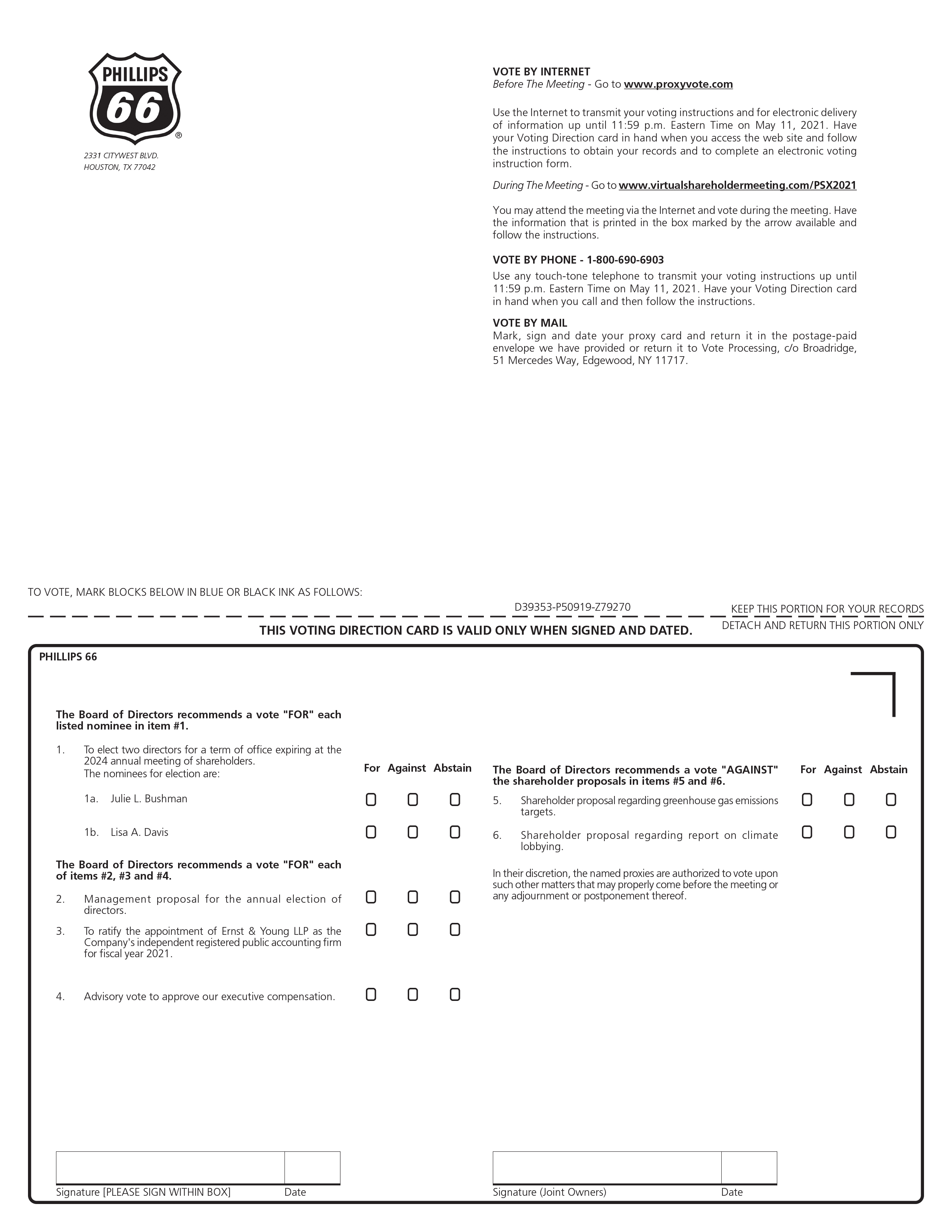
| 112 | Phillips 66 2023 Proxy Statement | ||||
